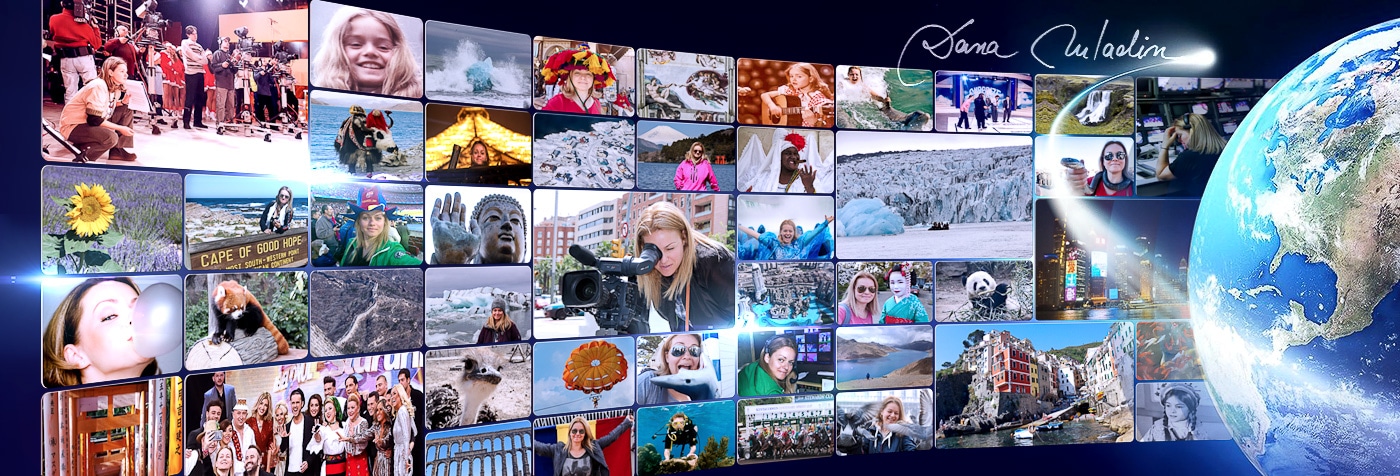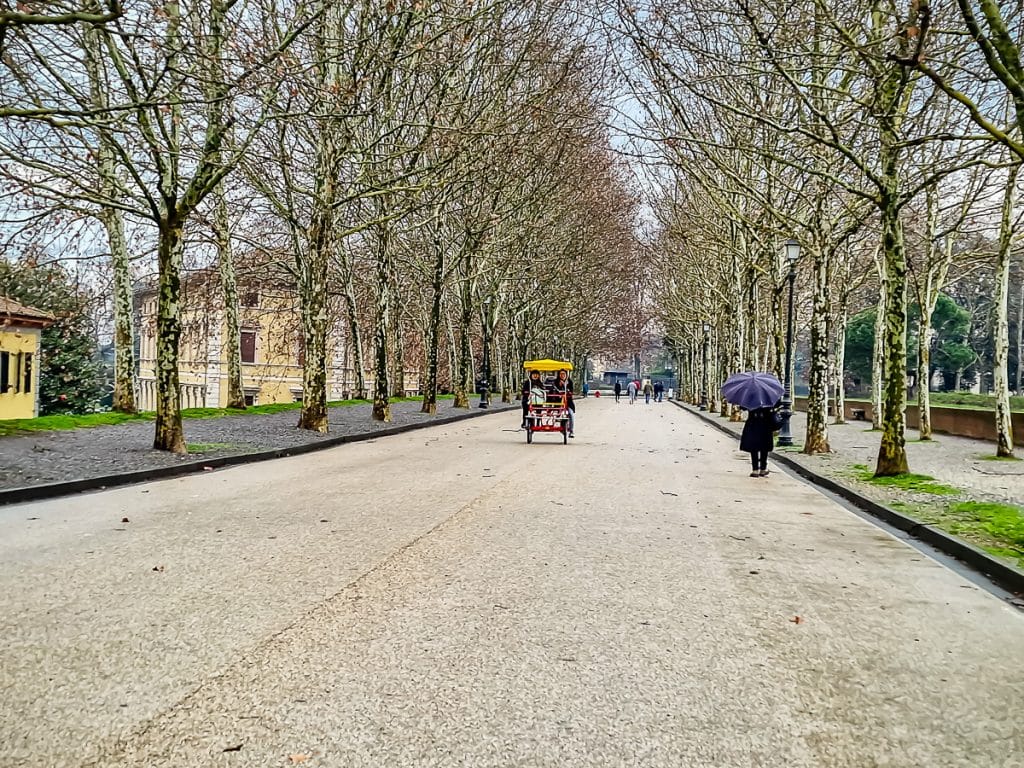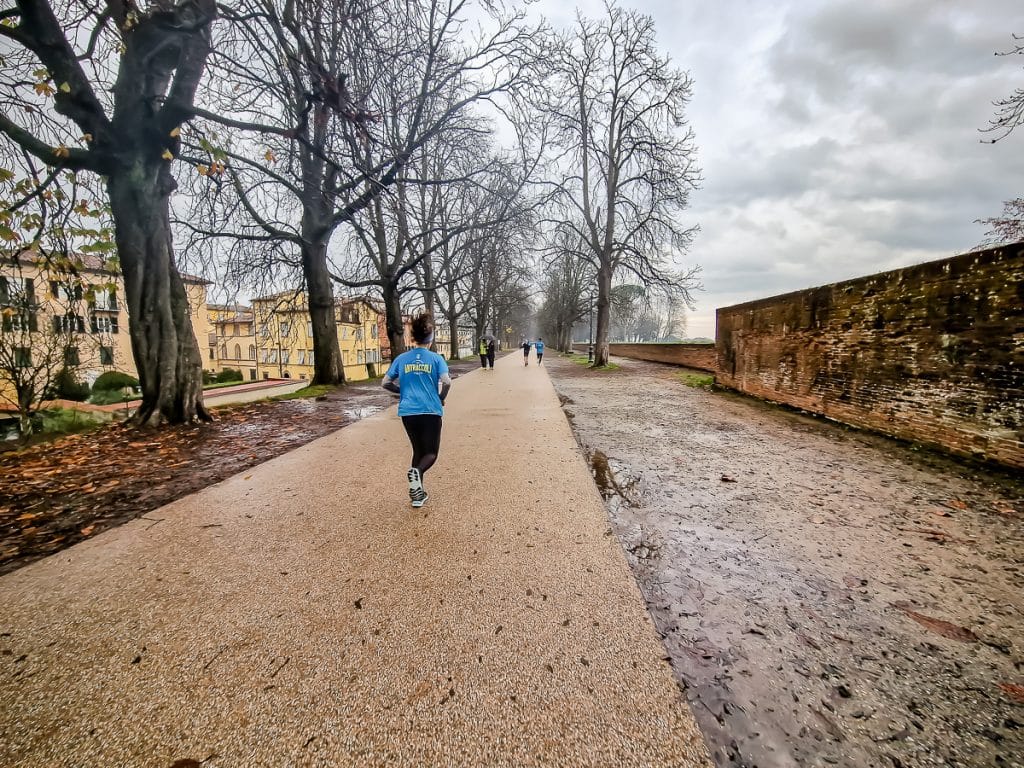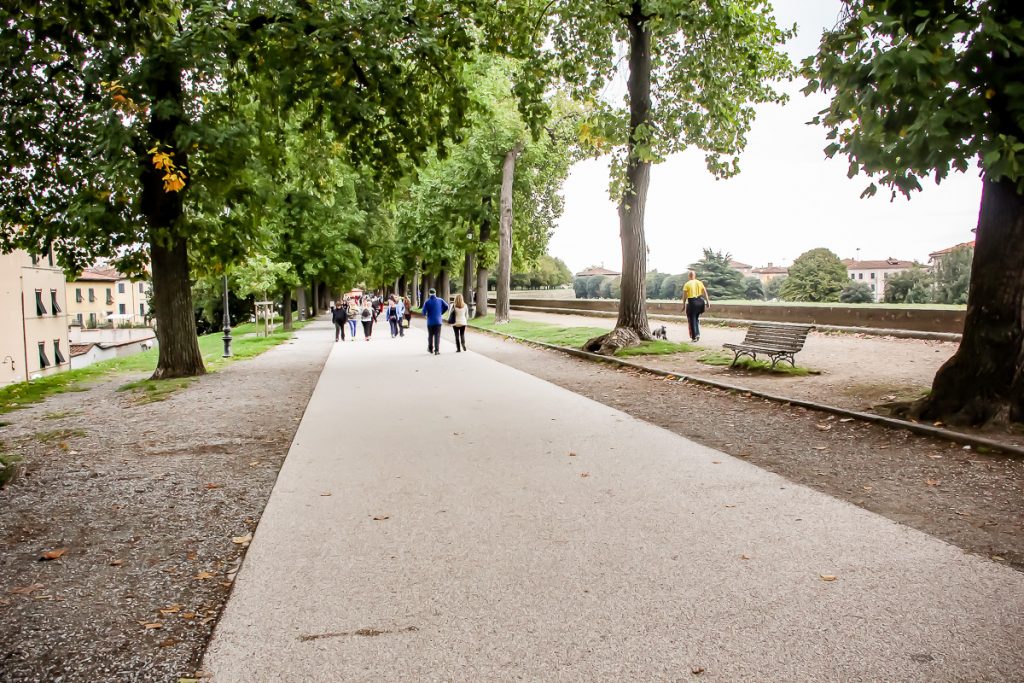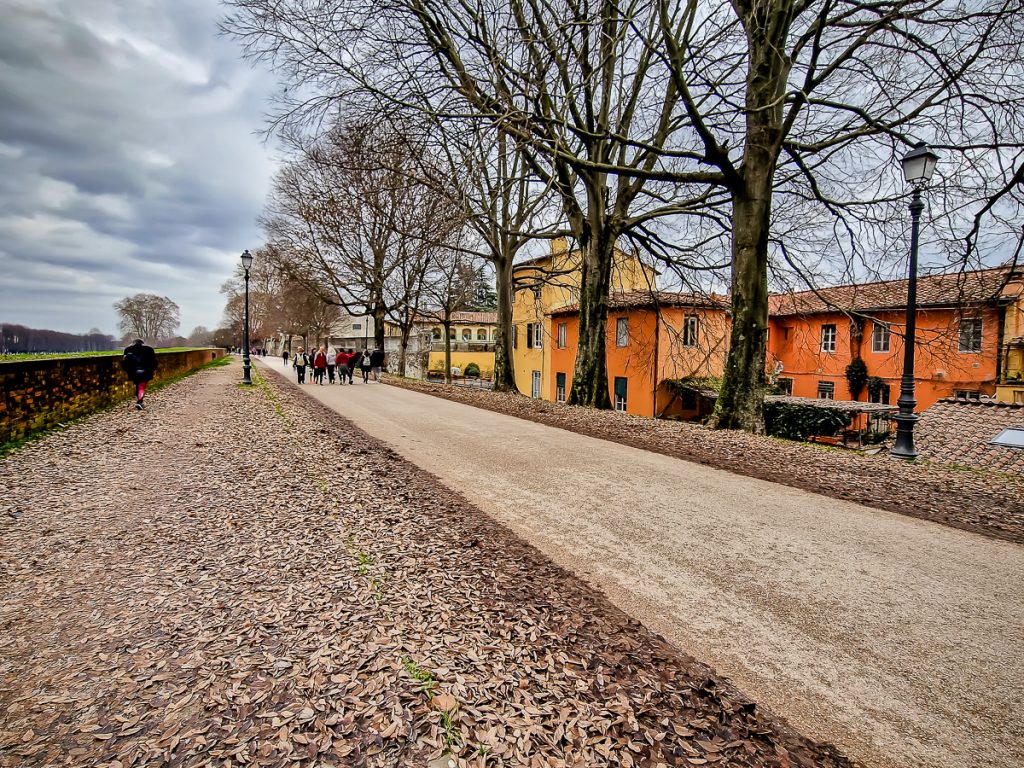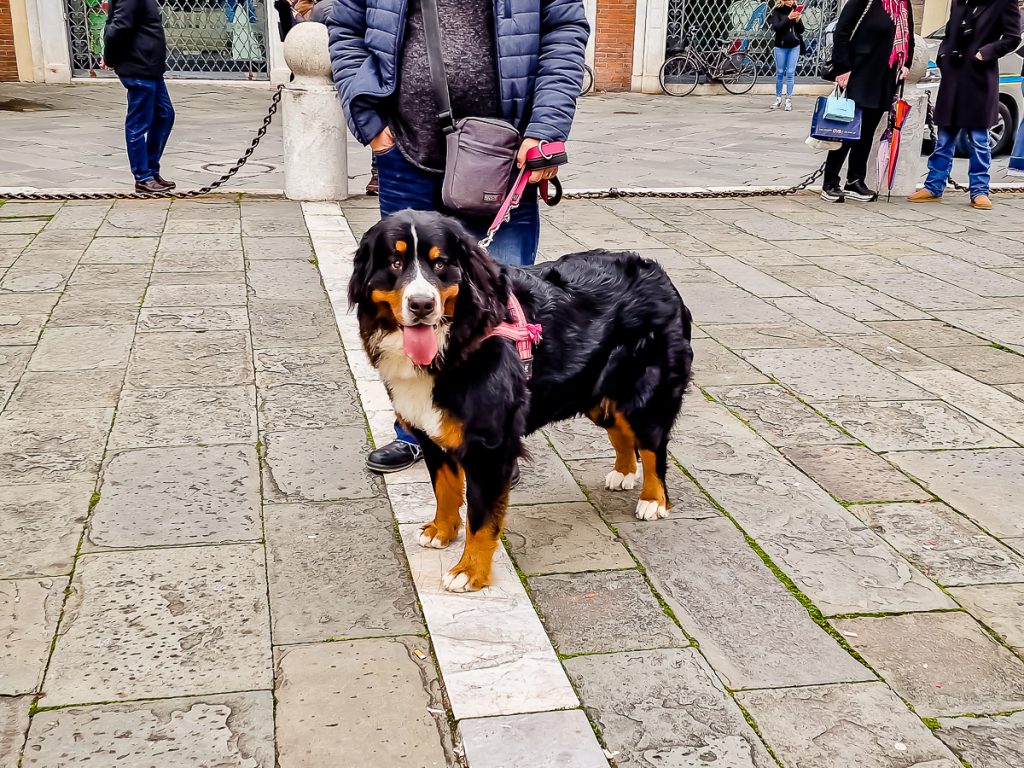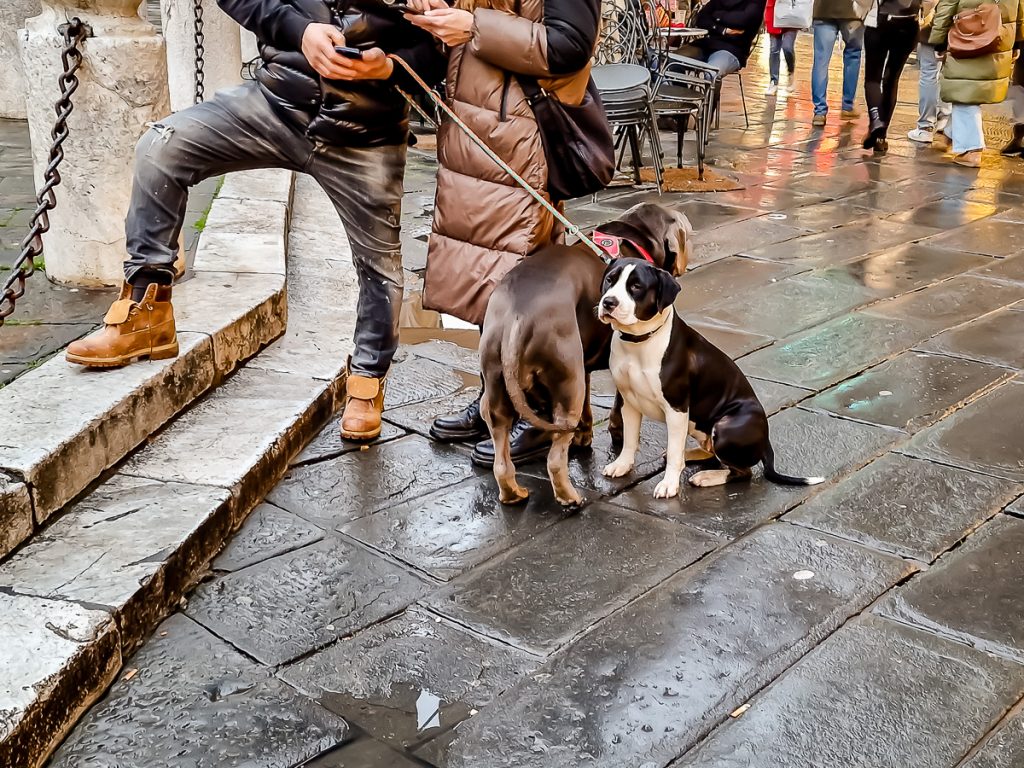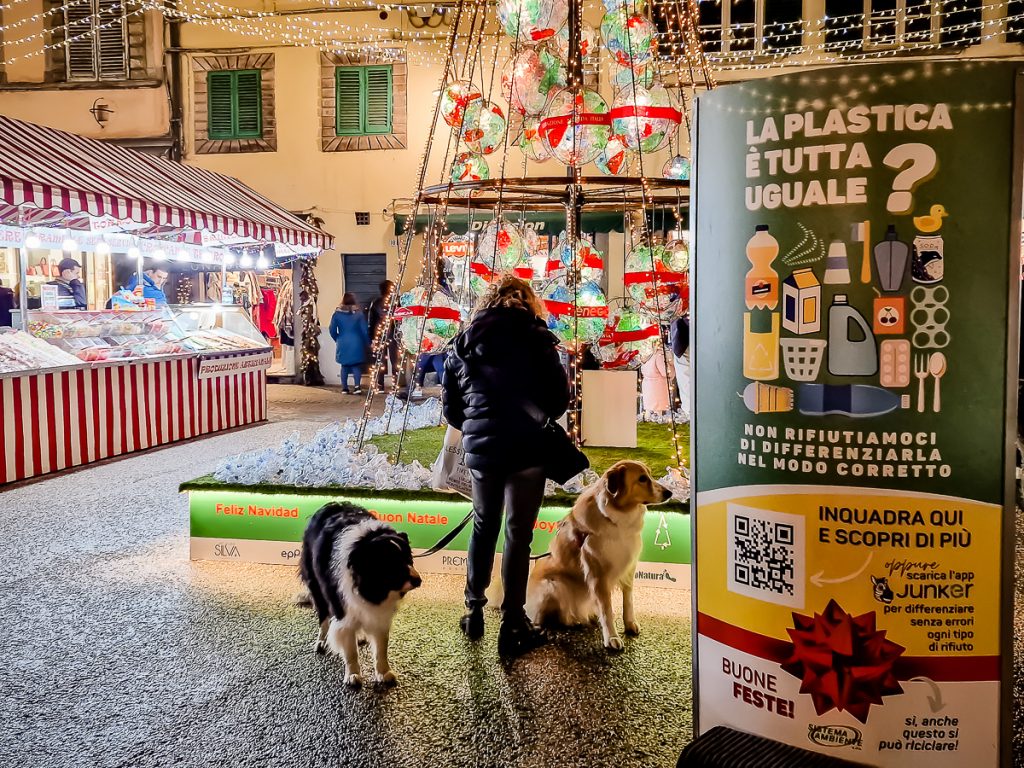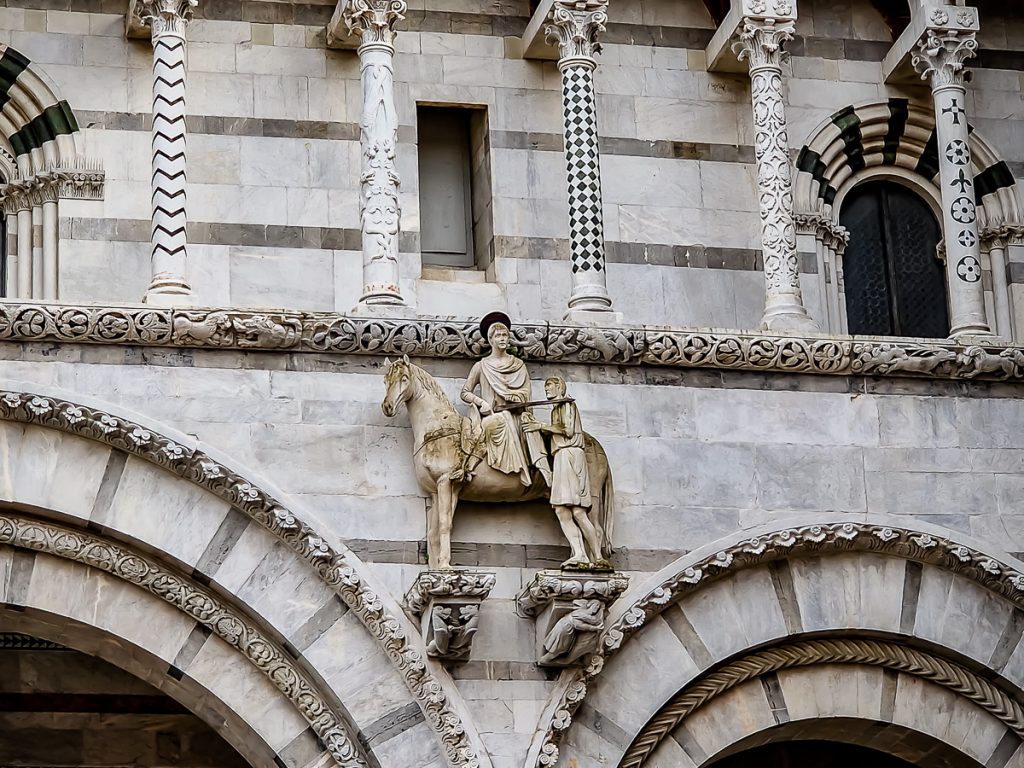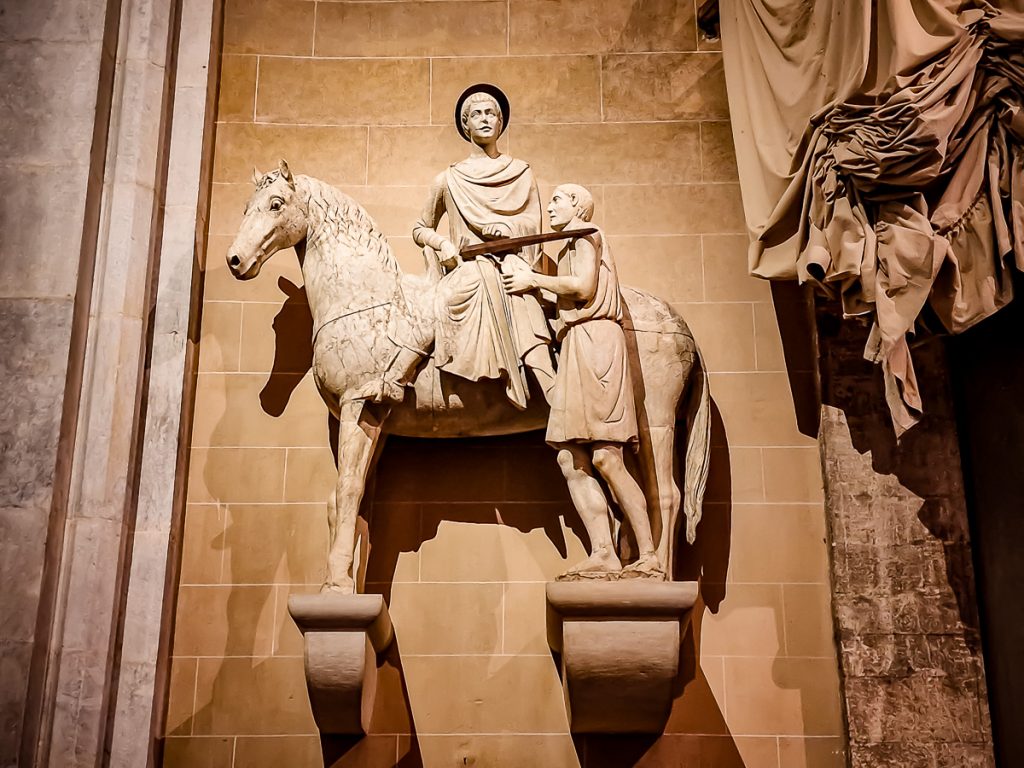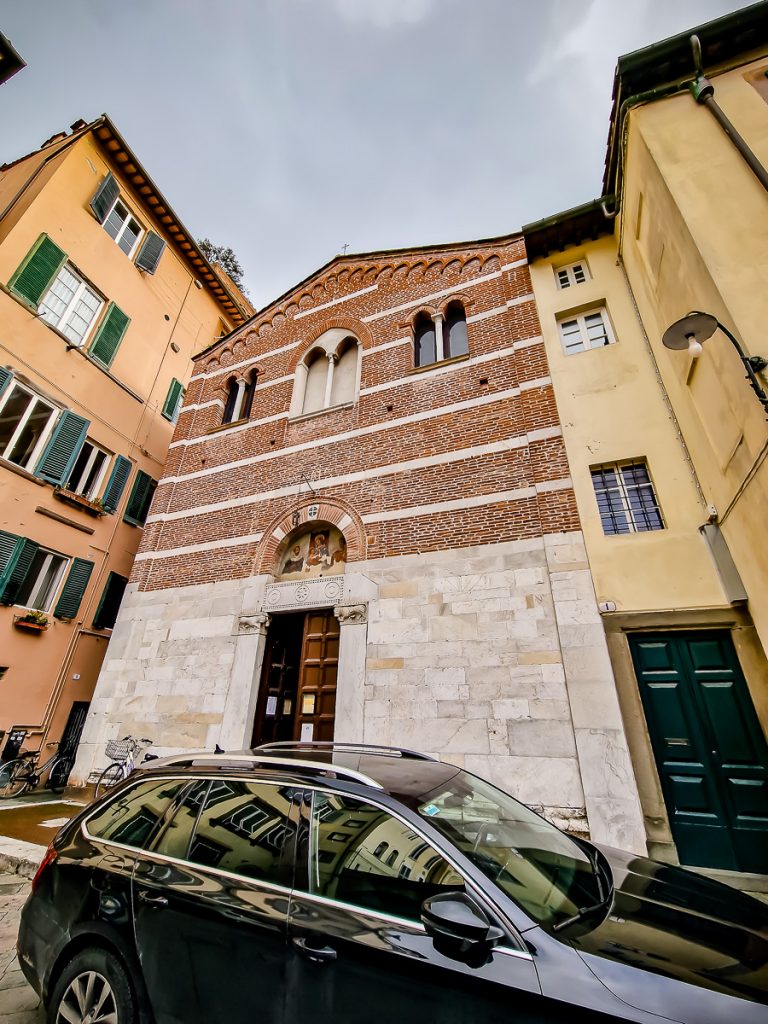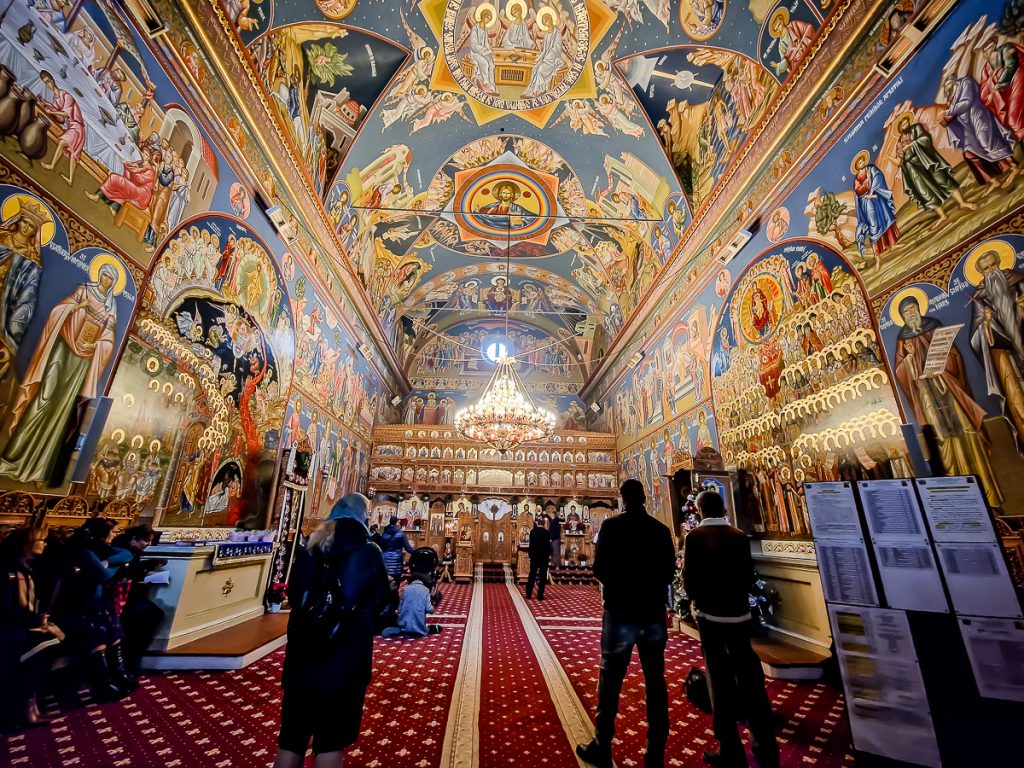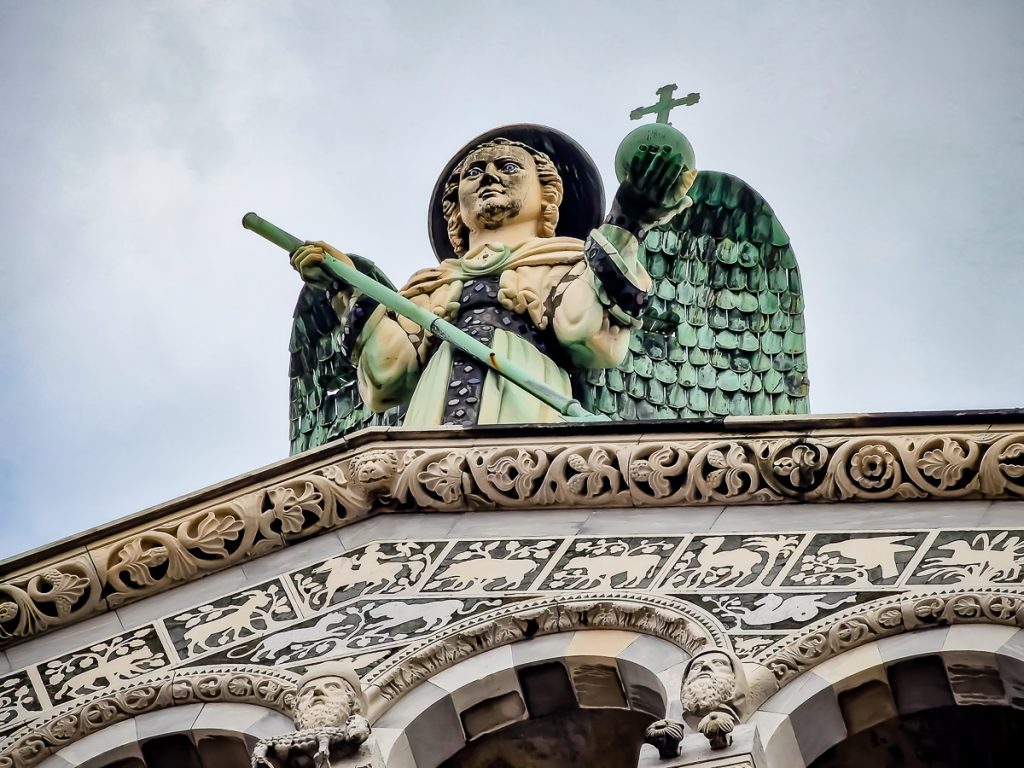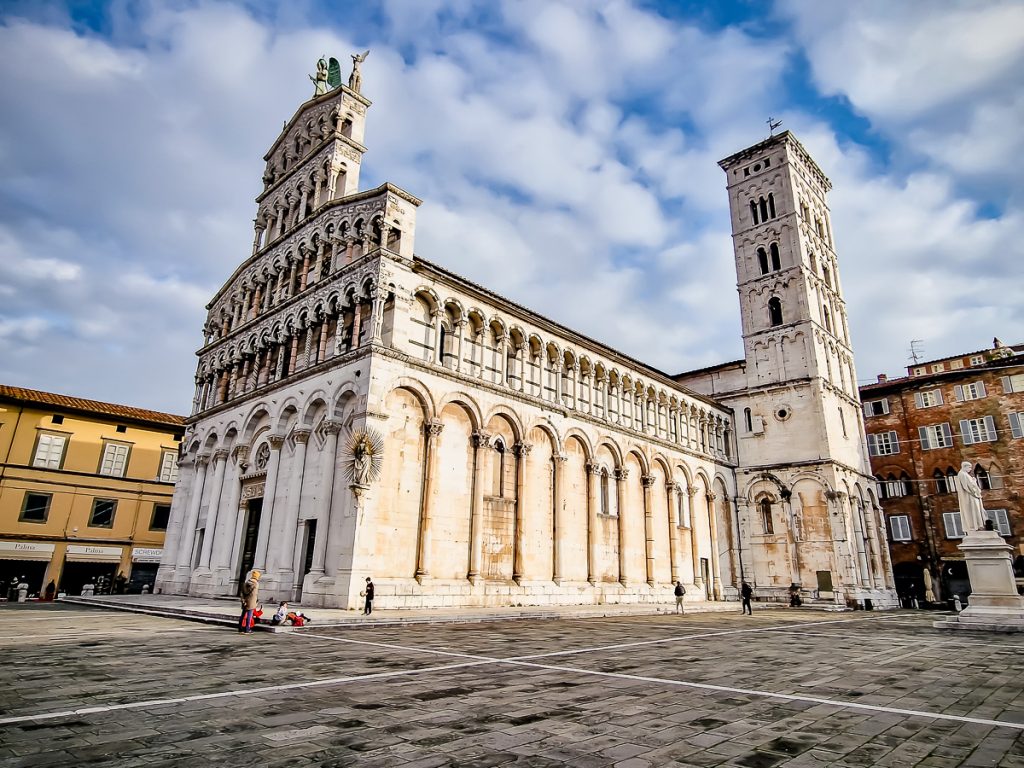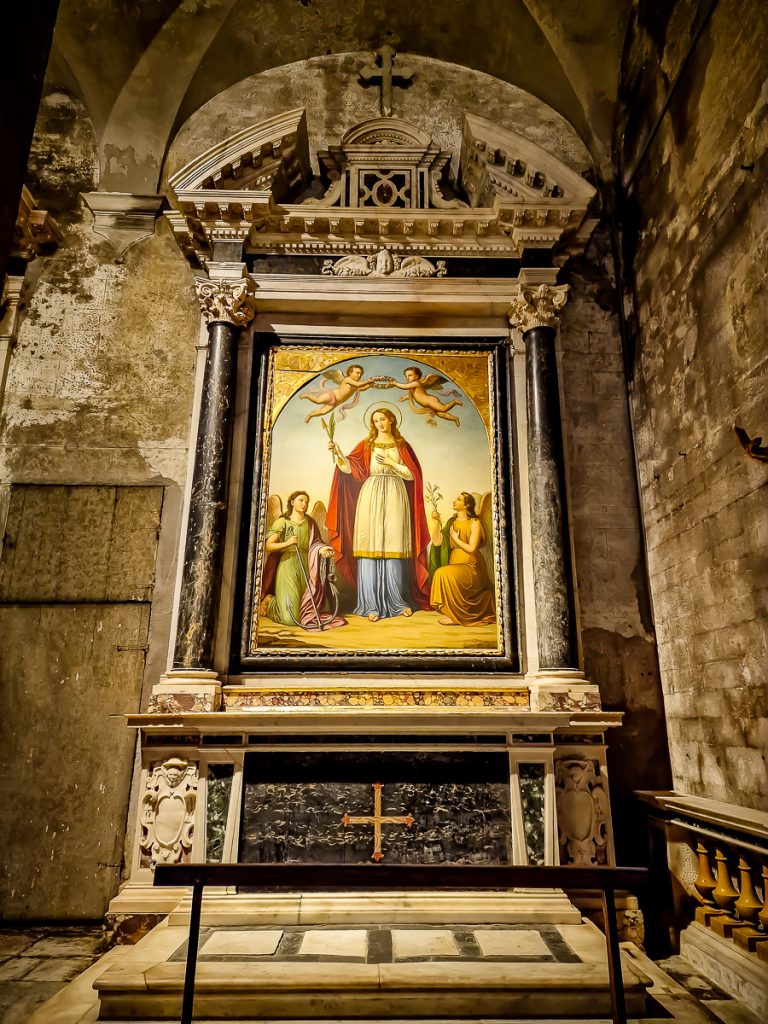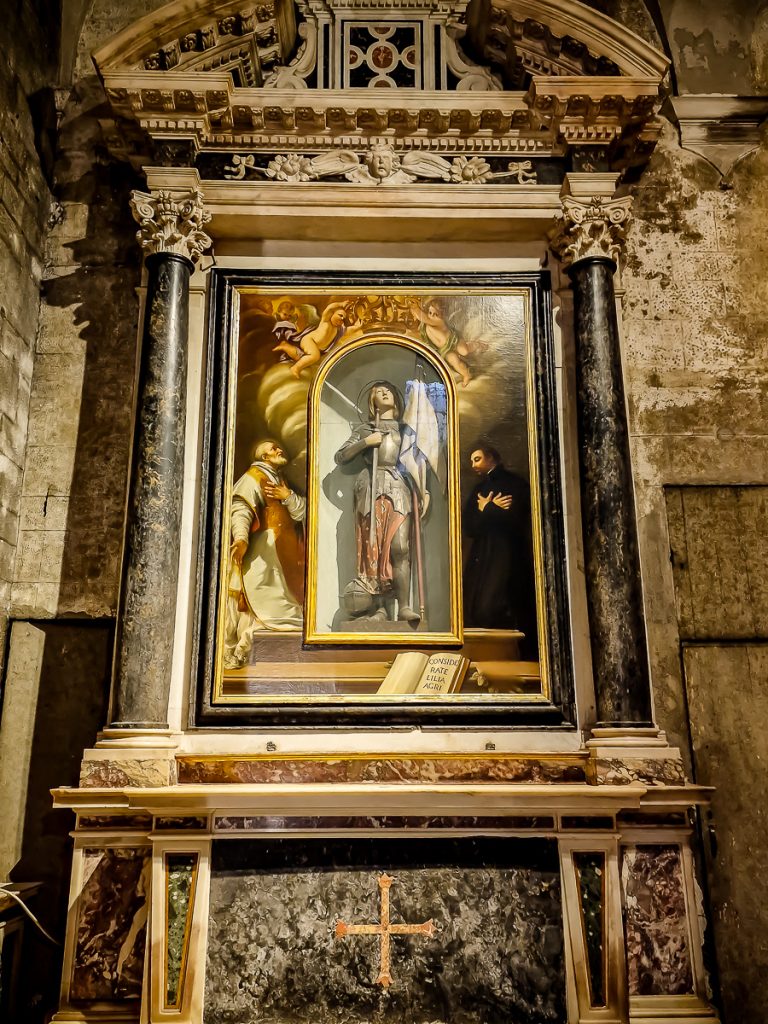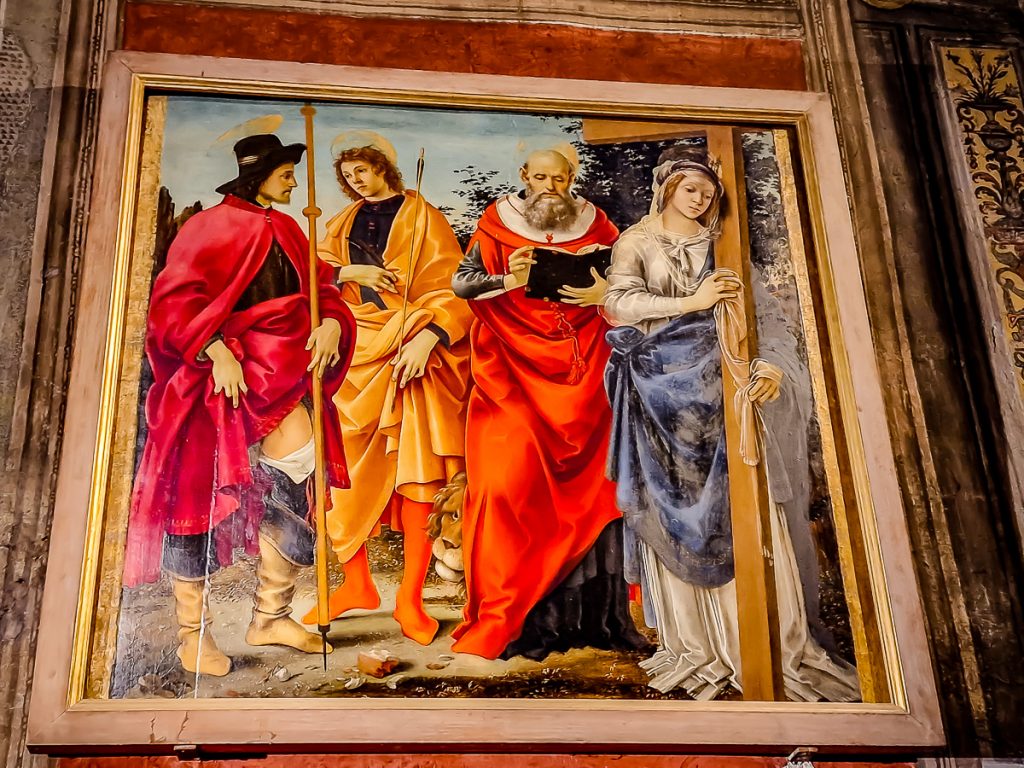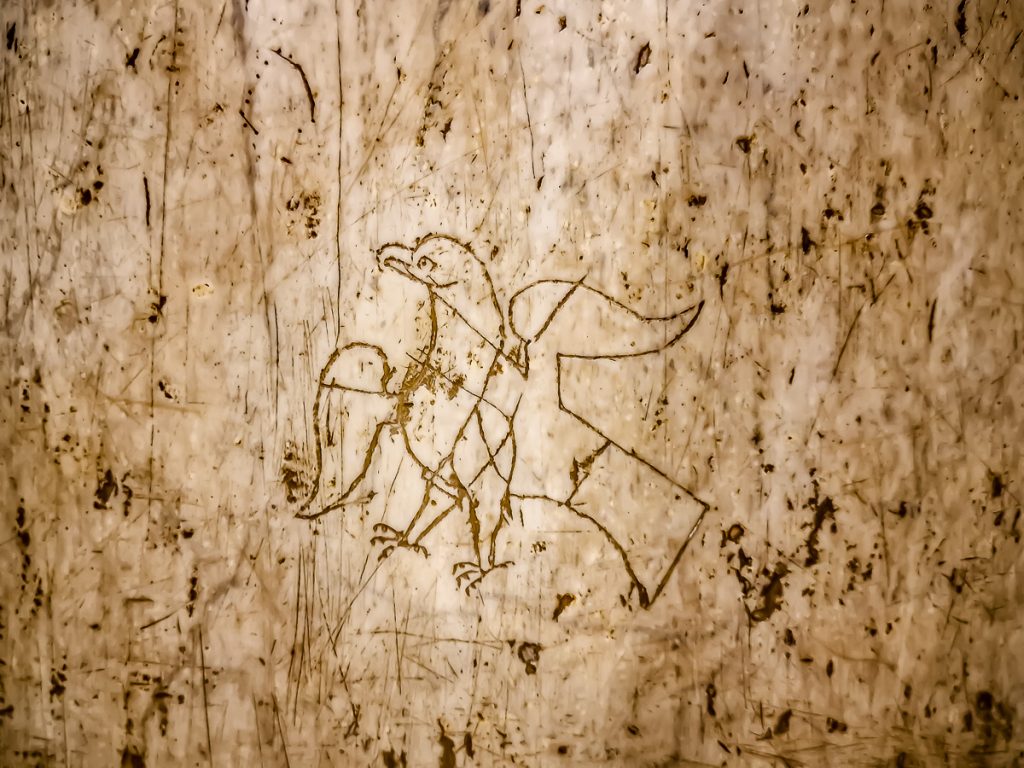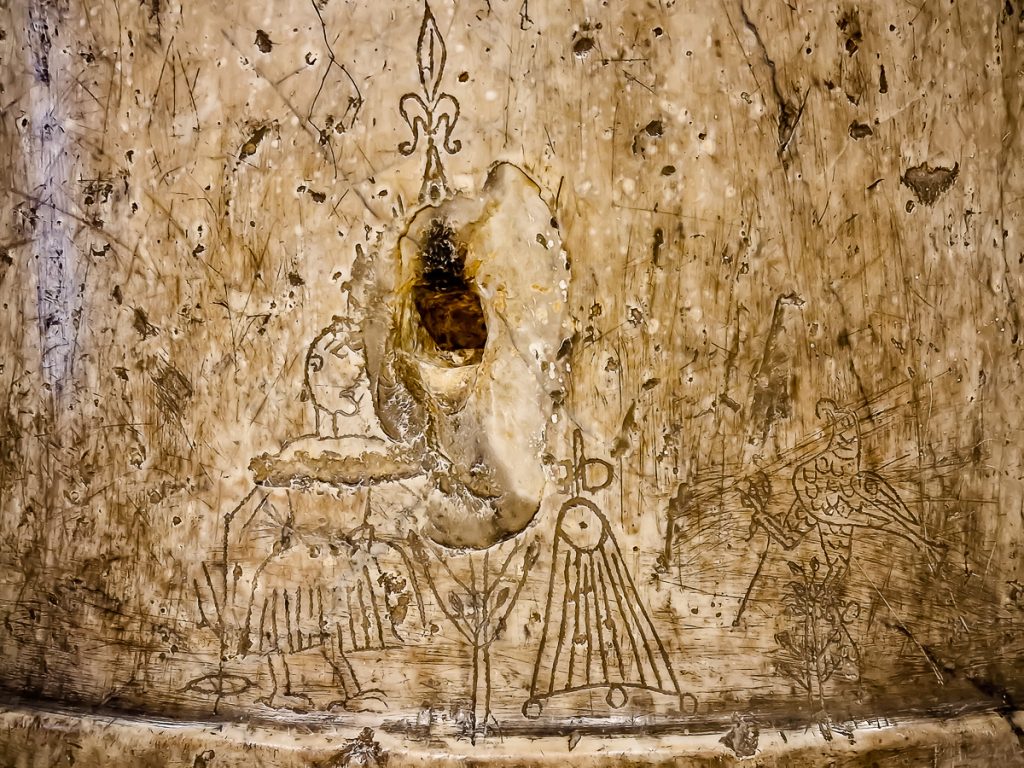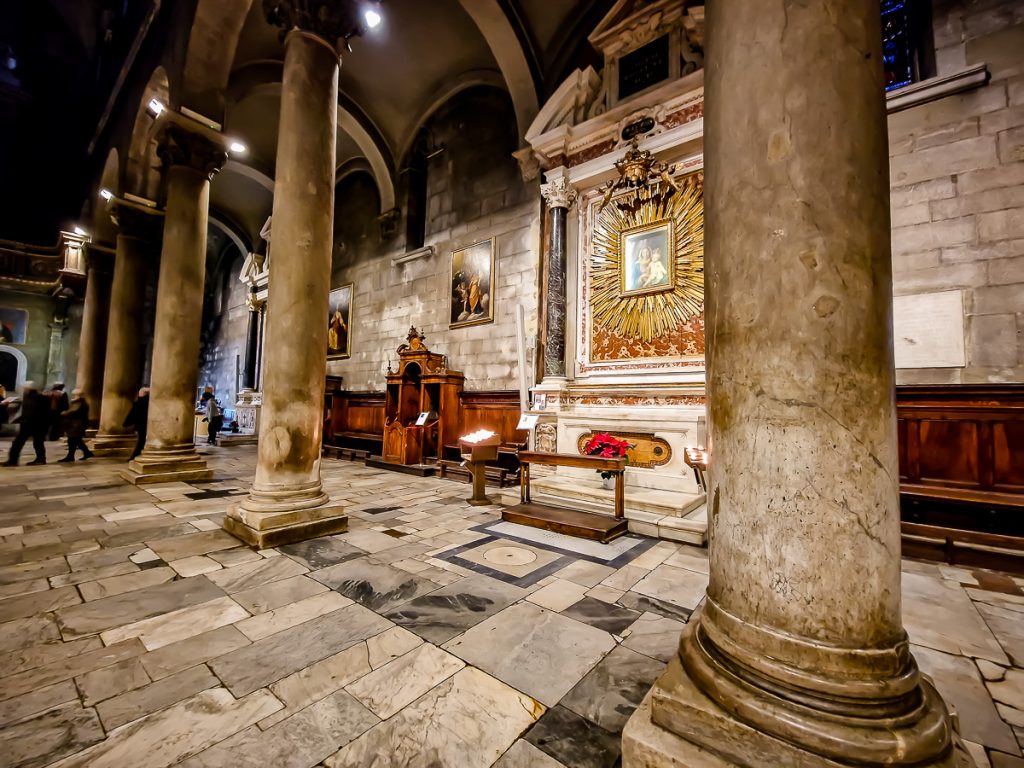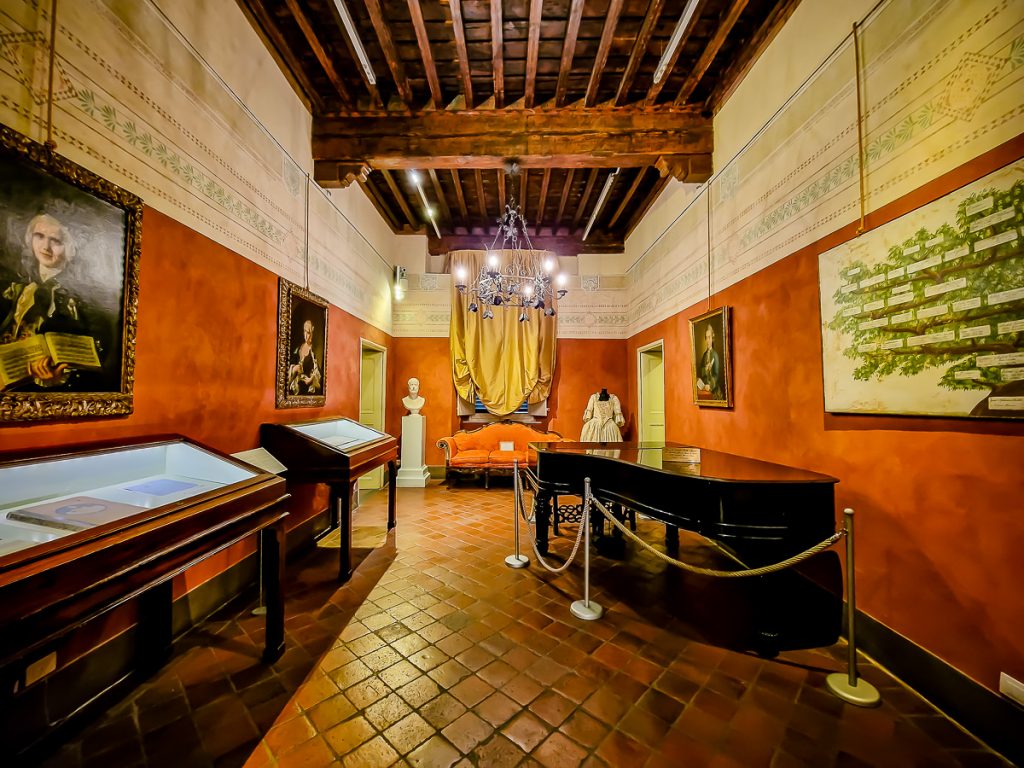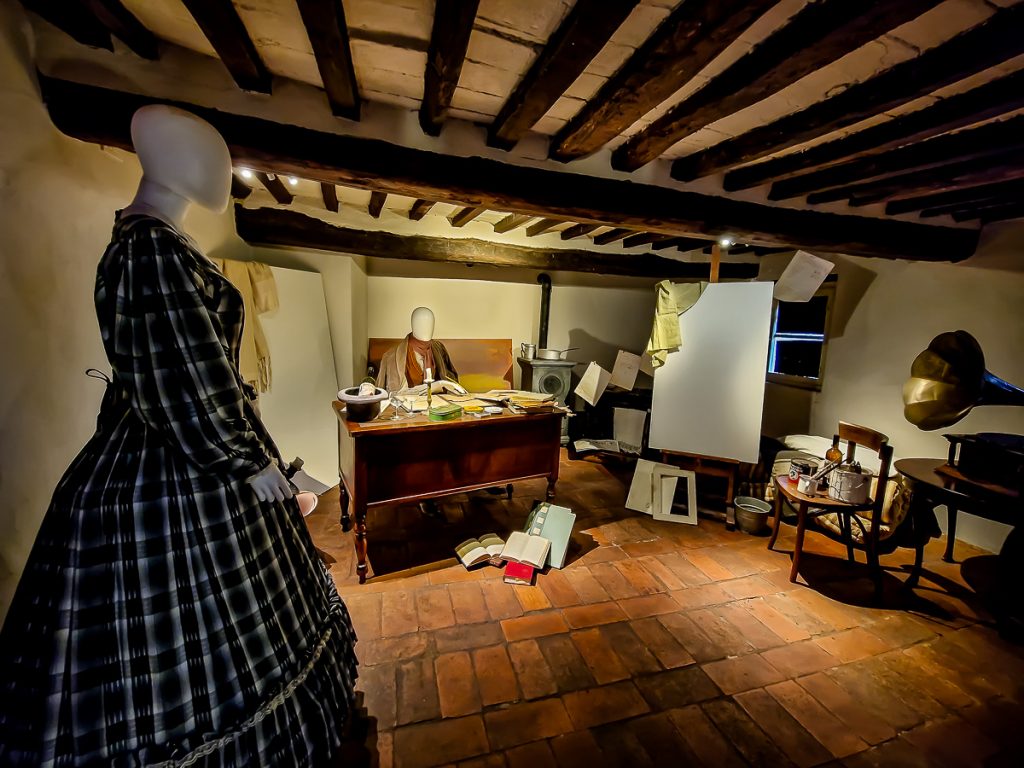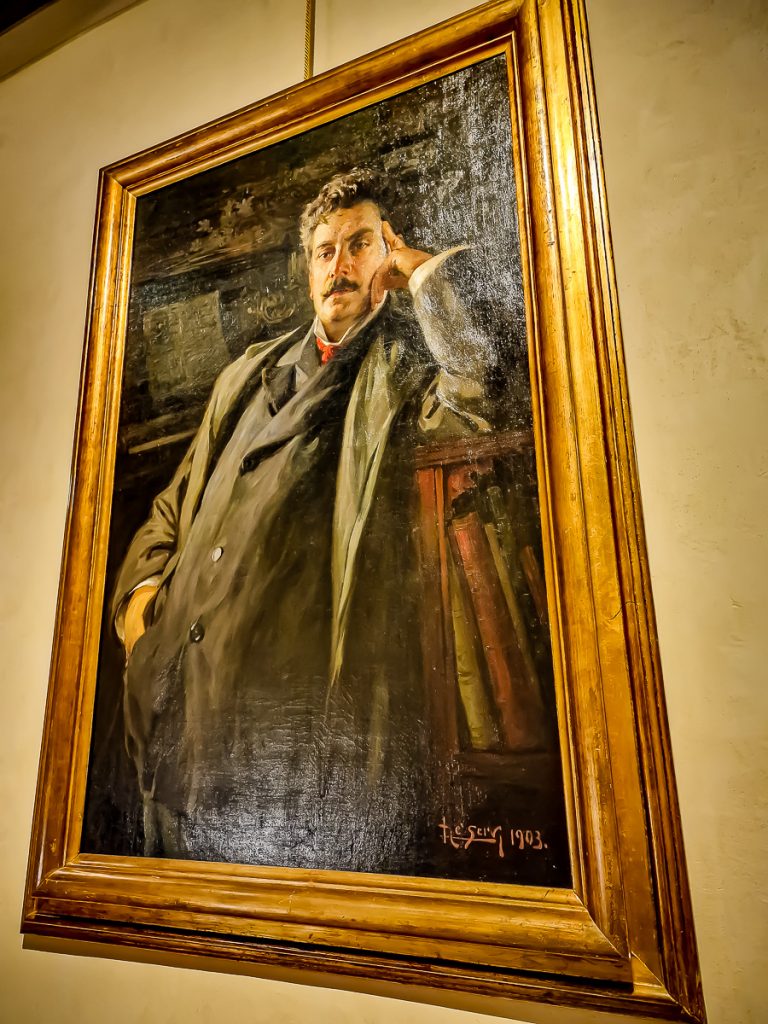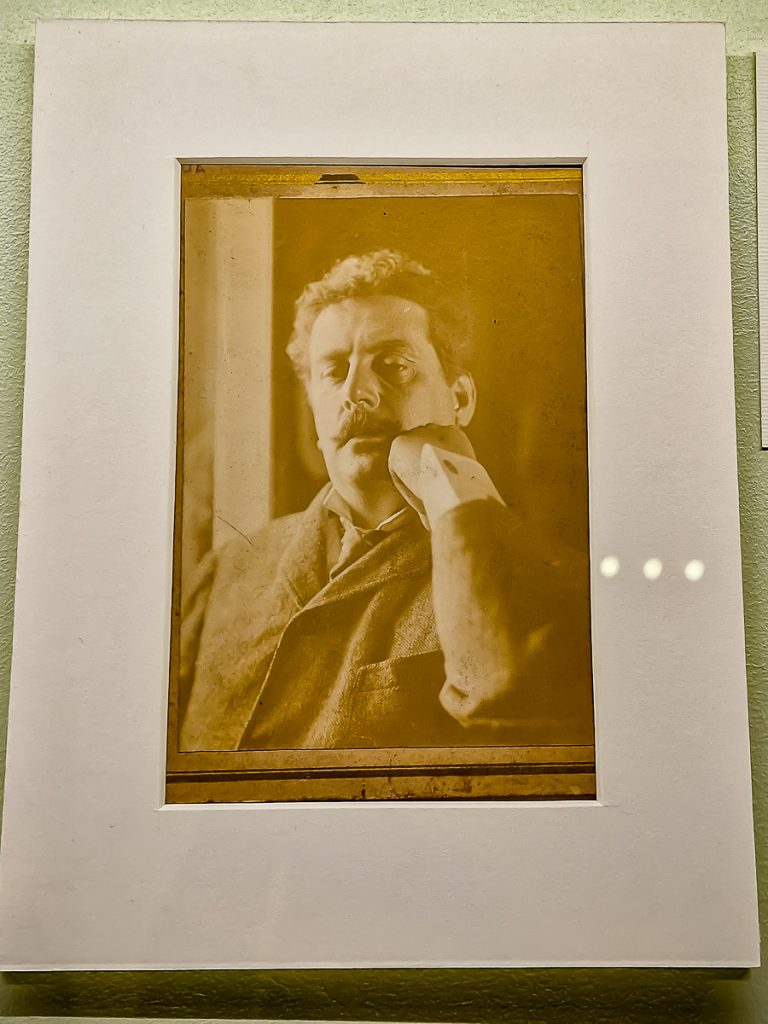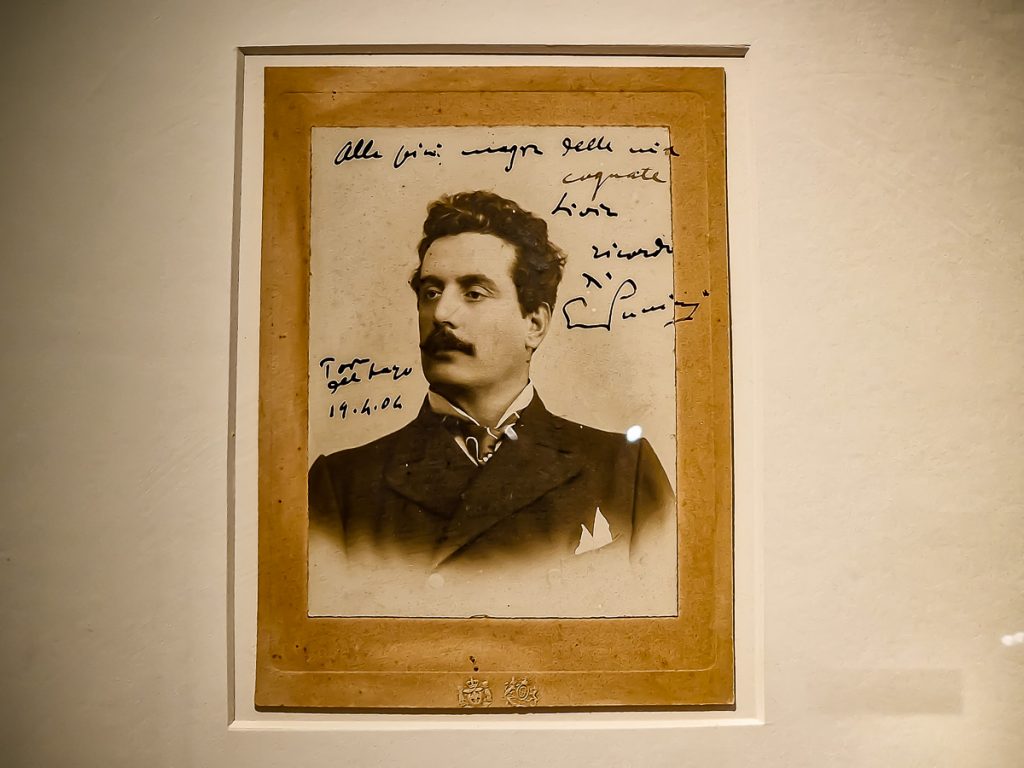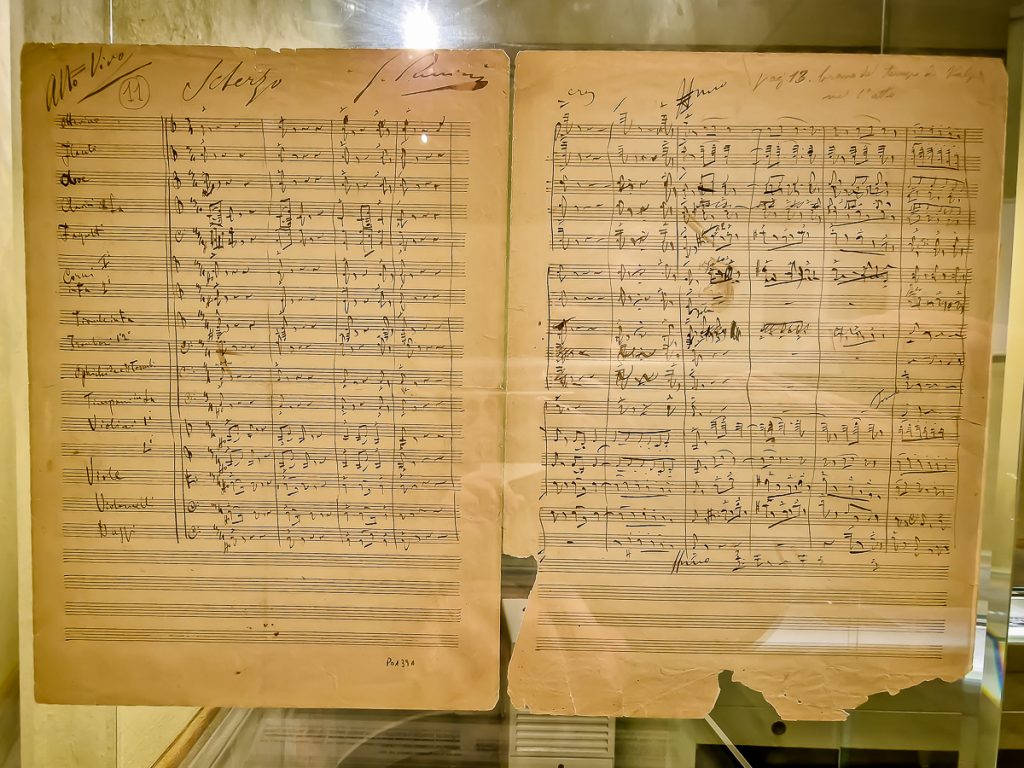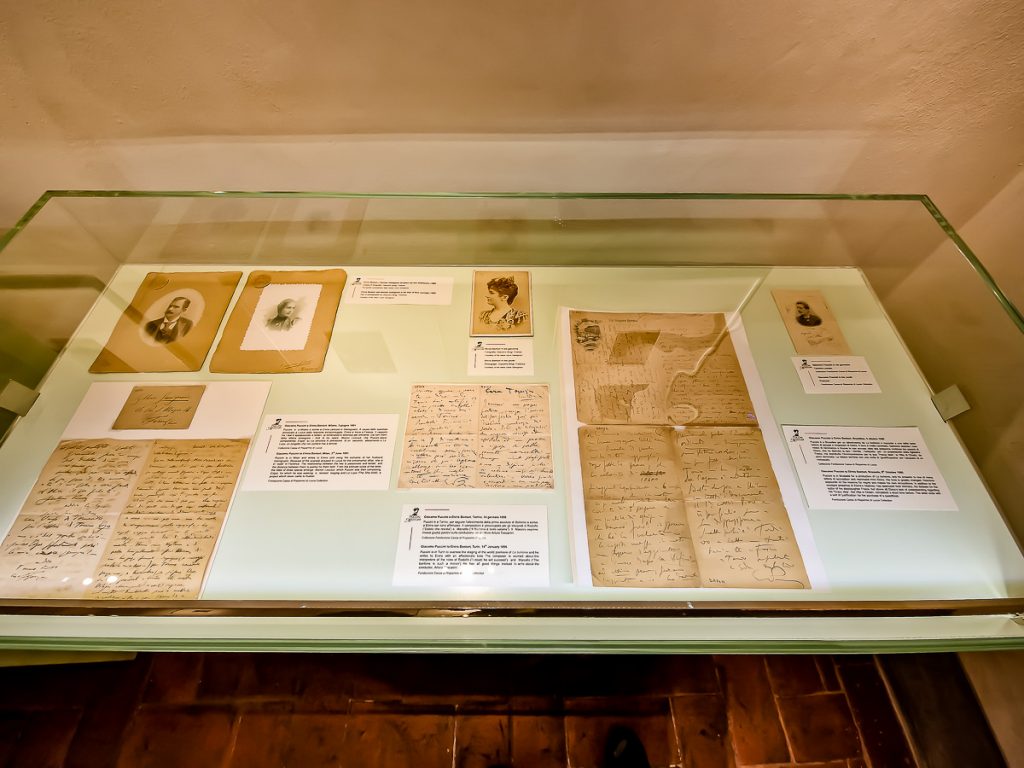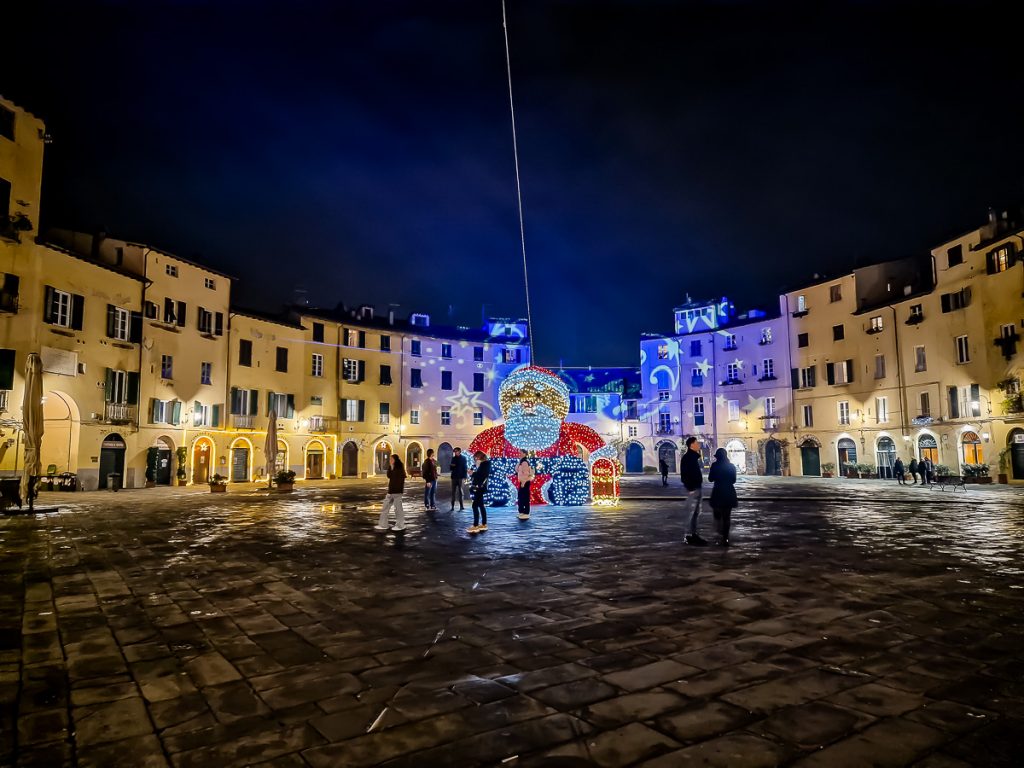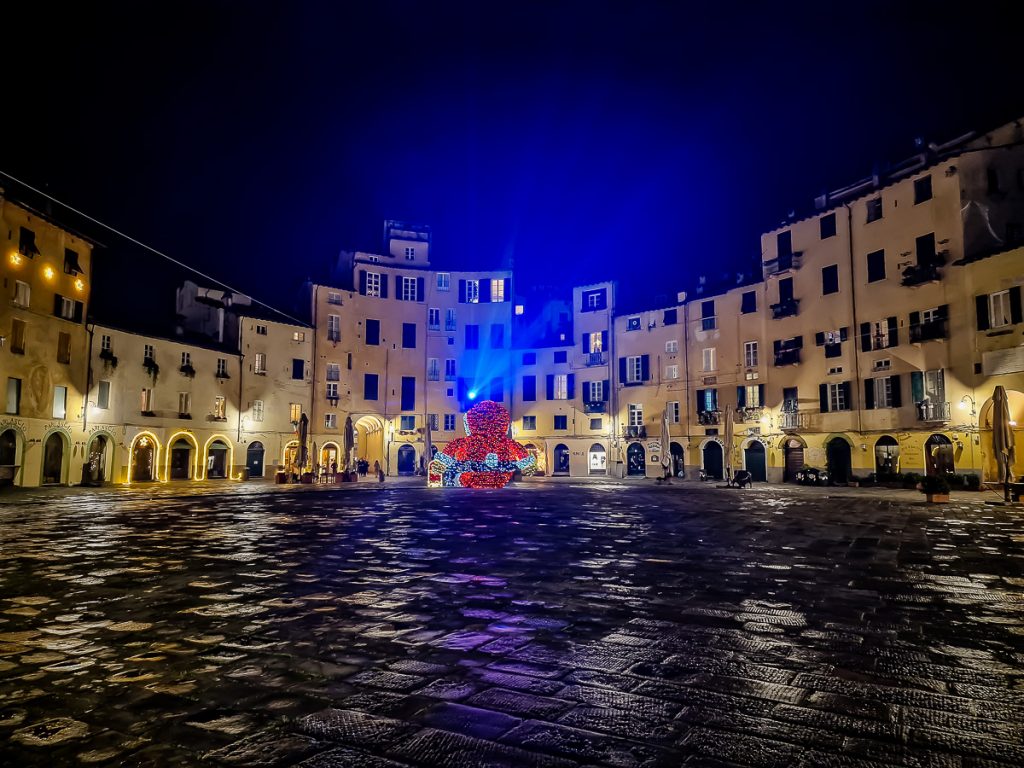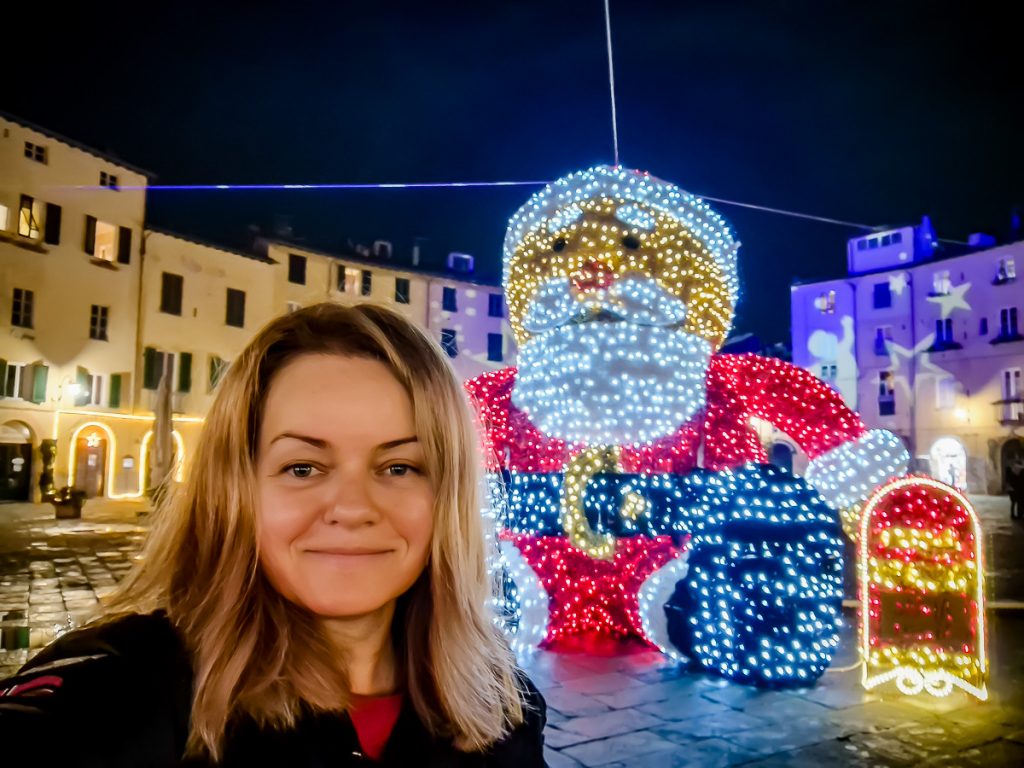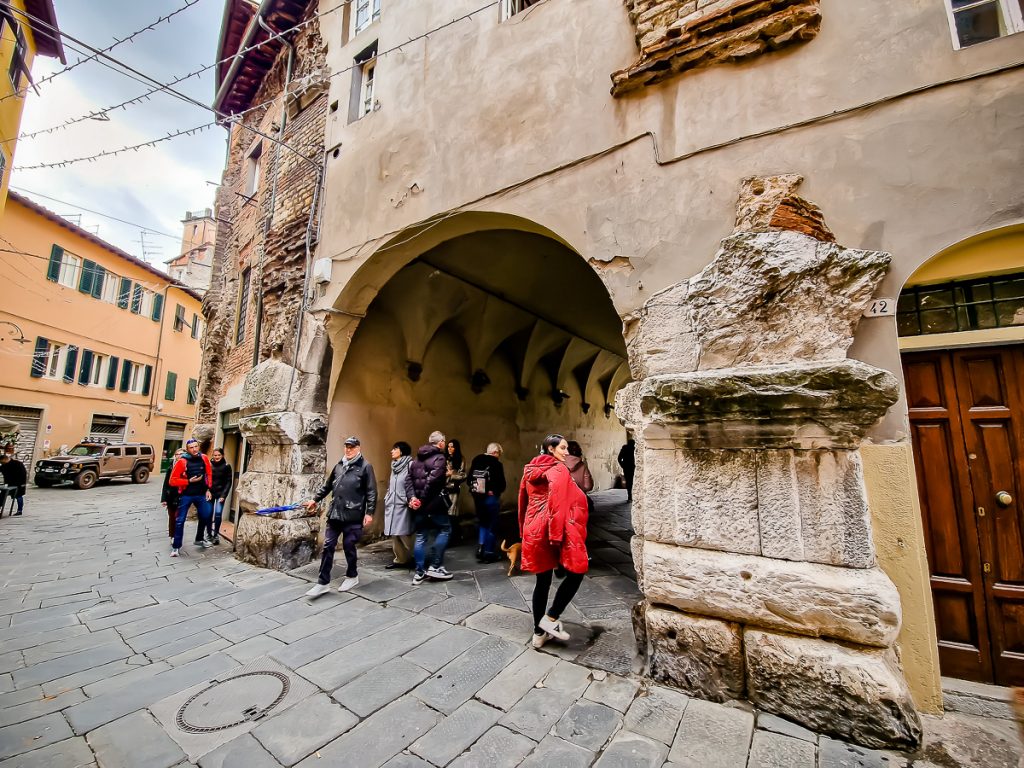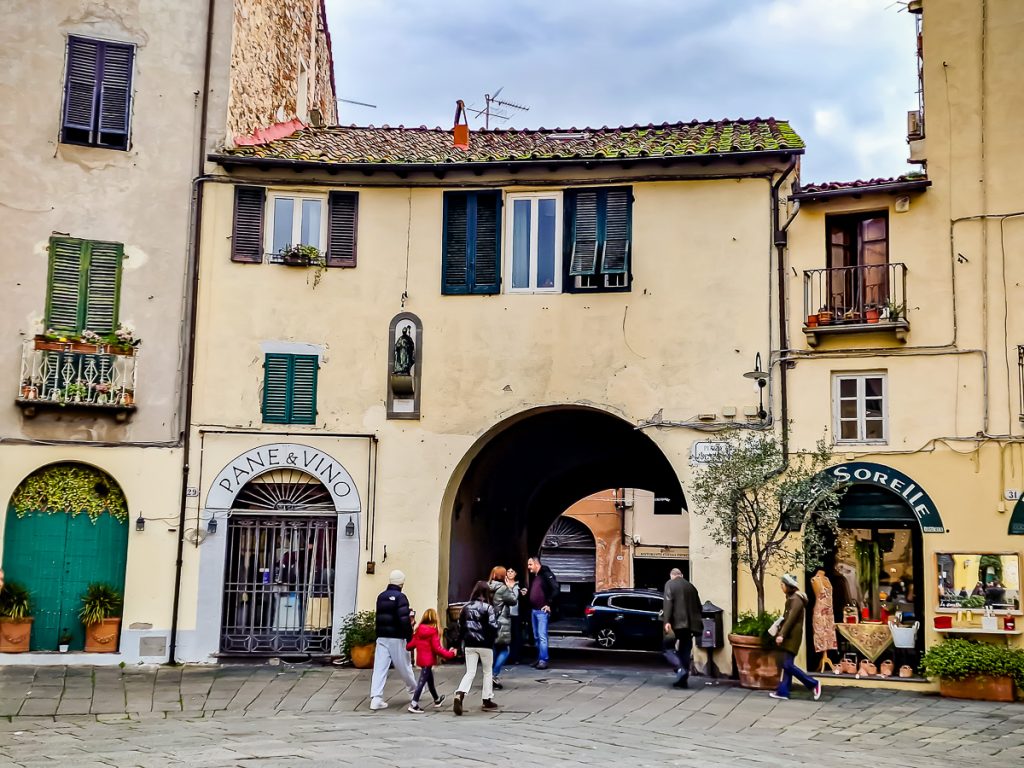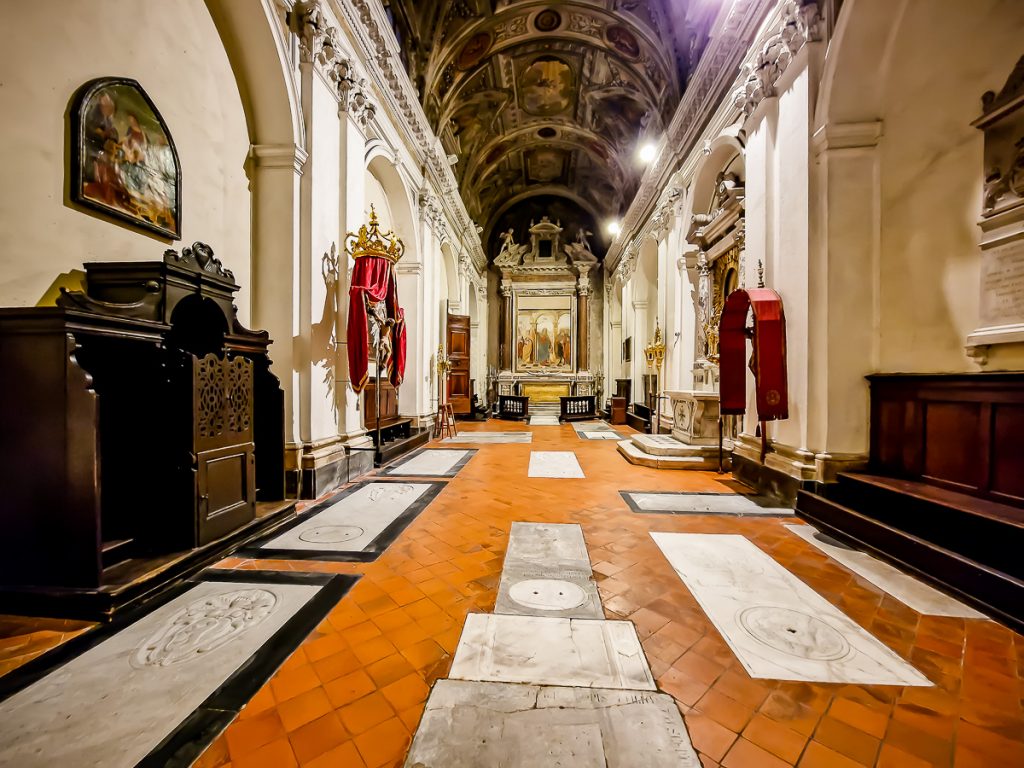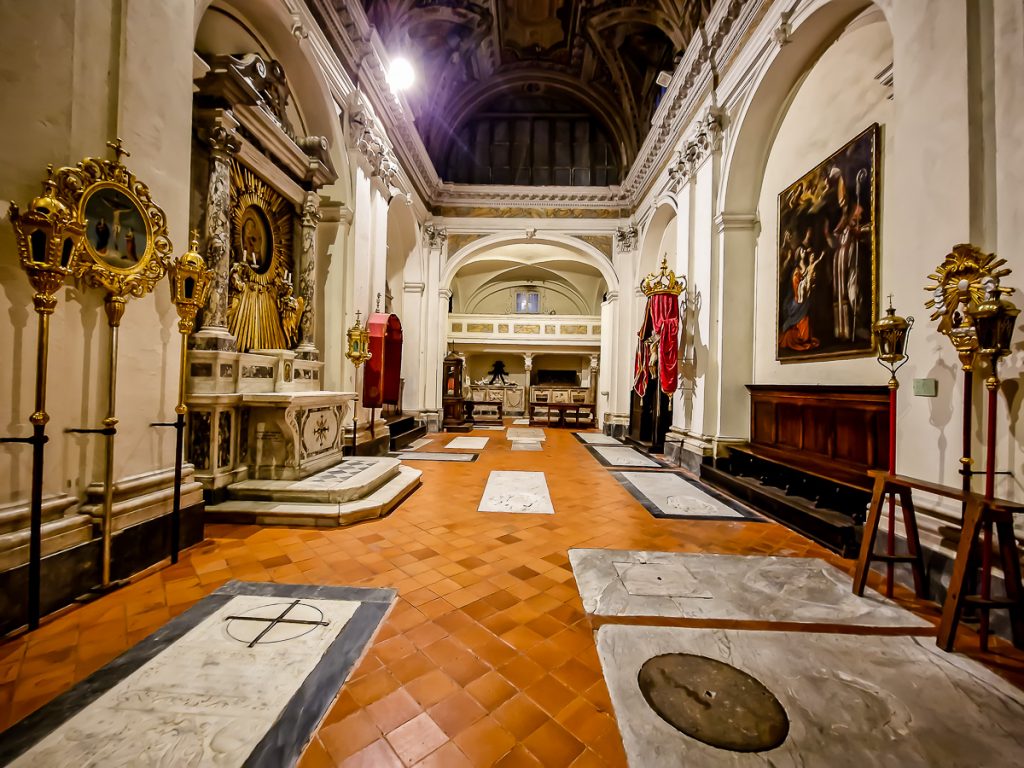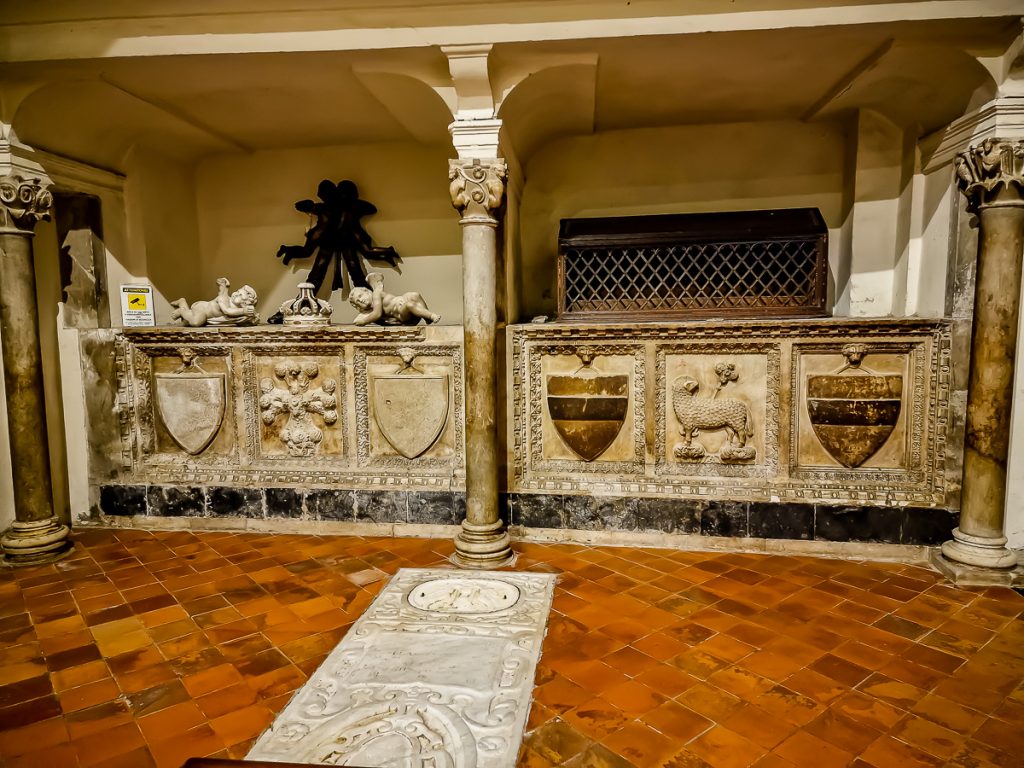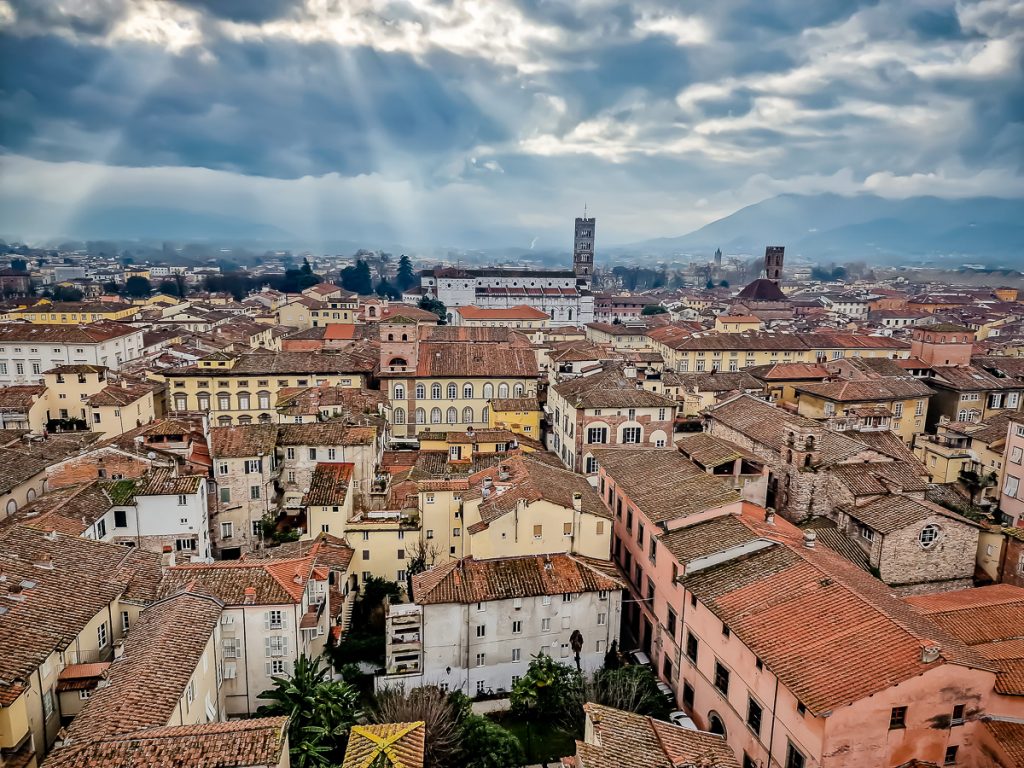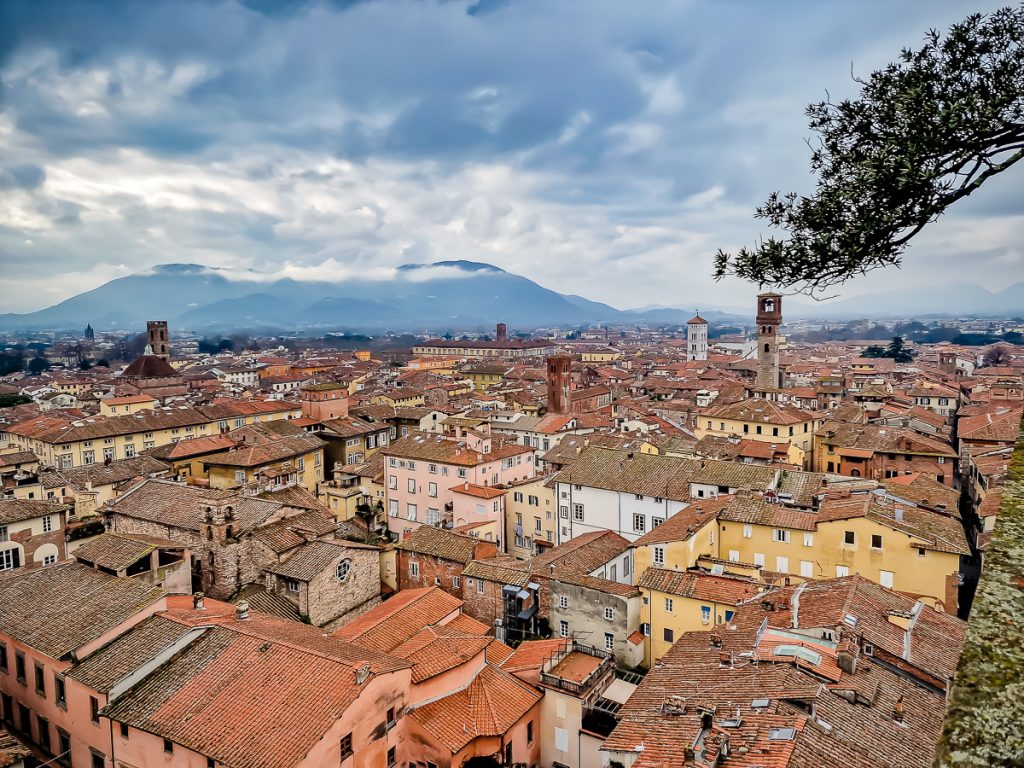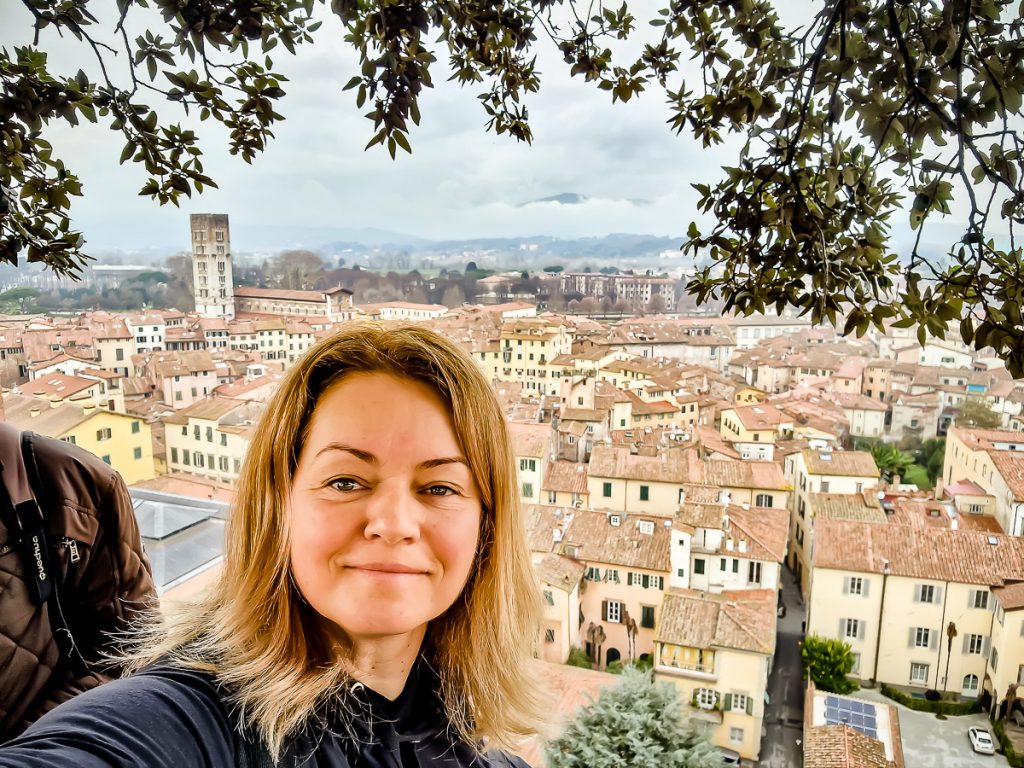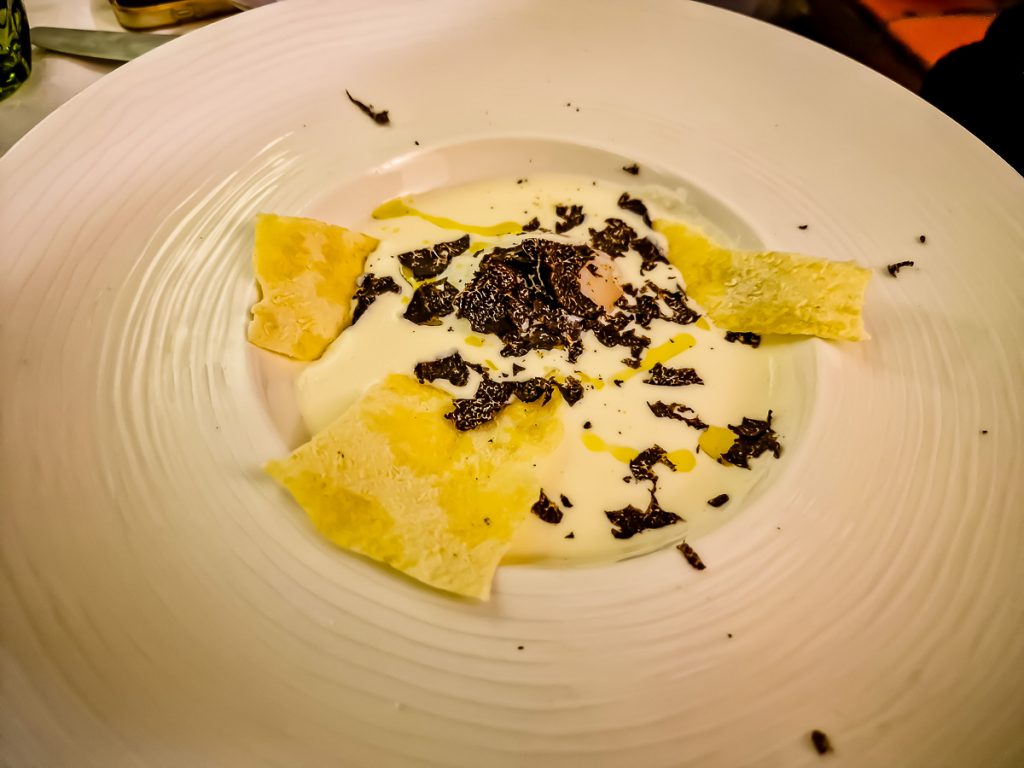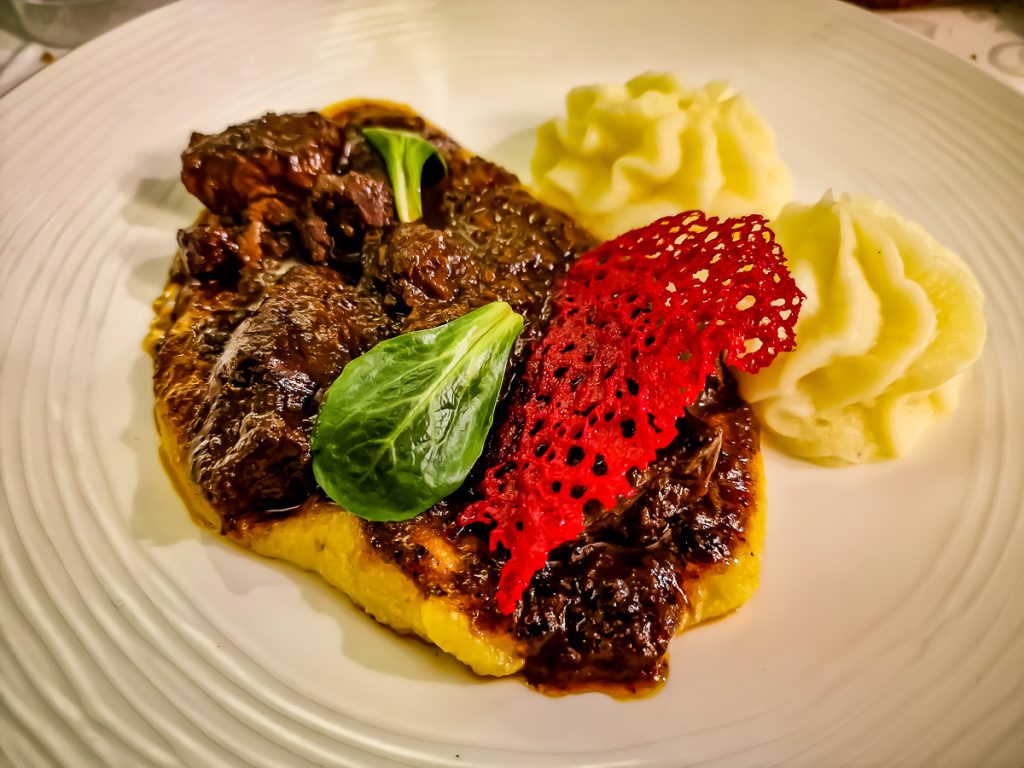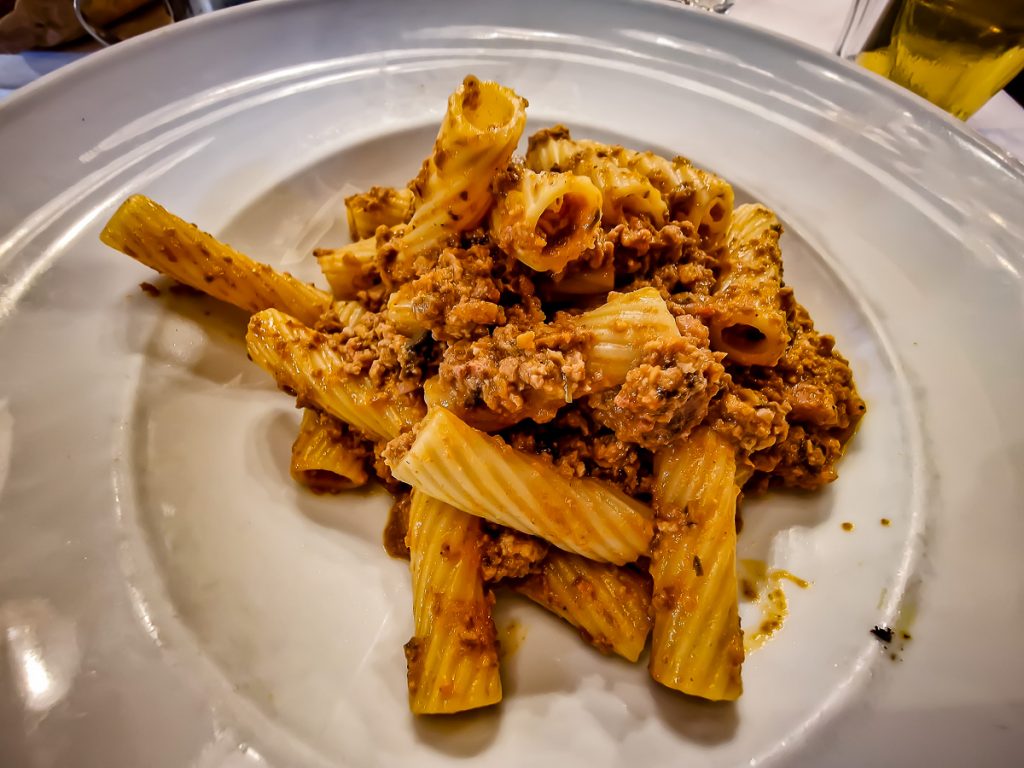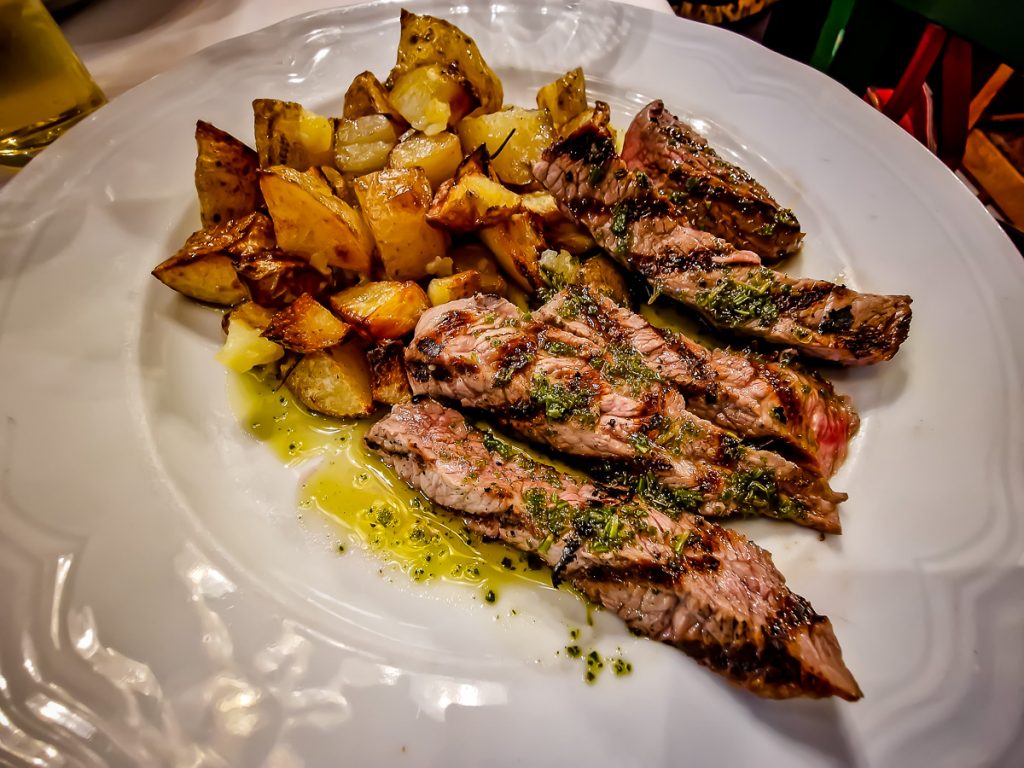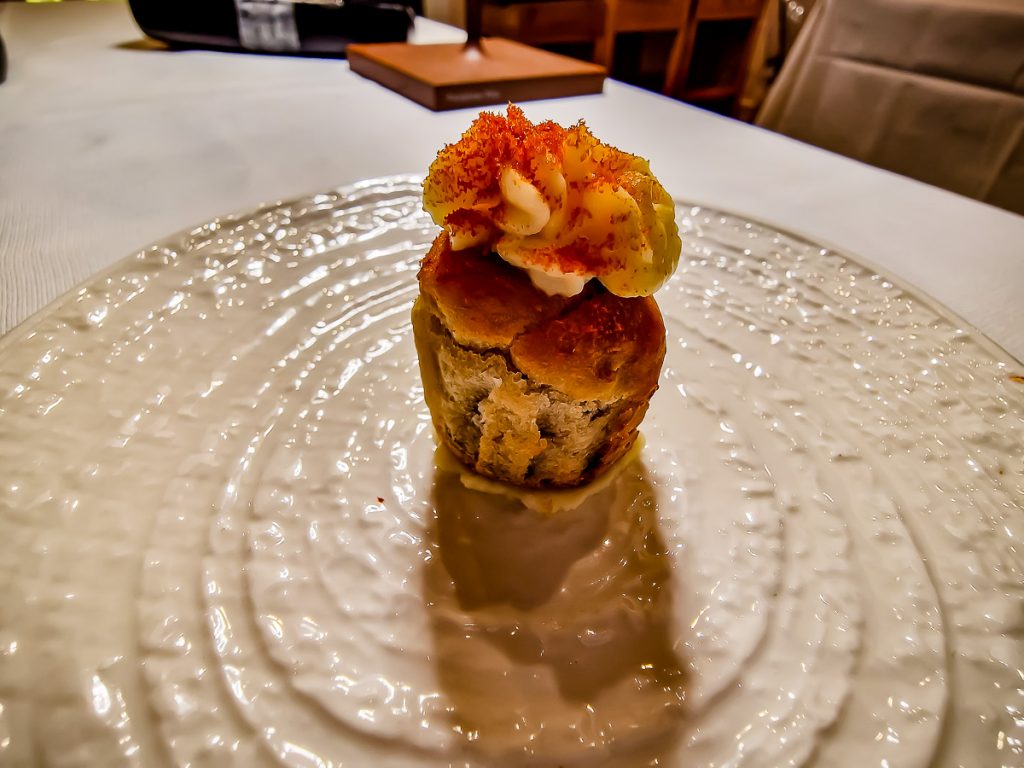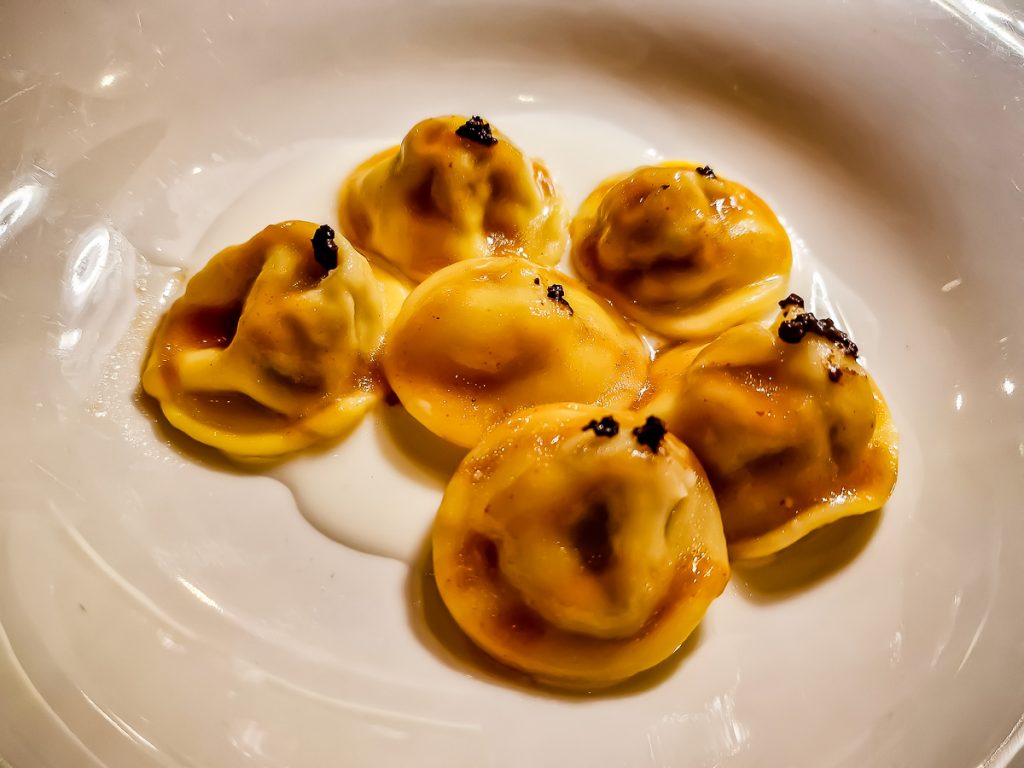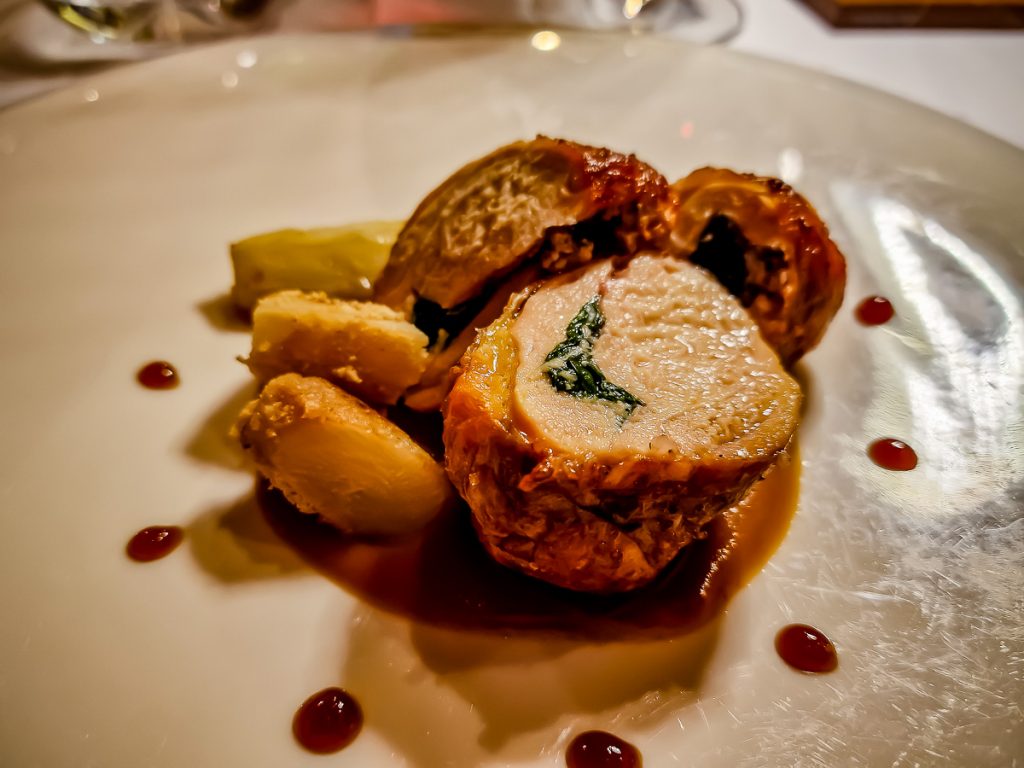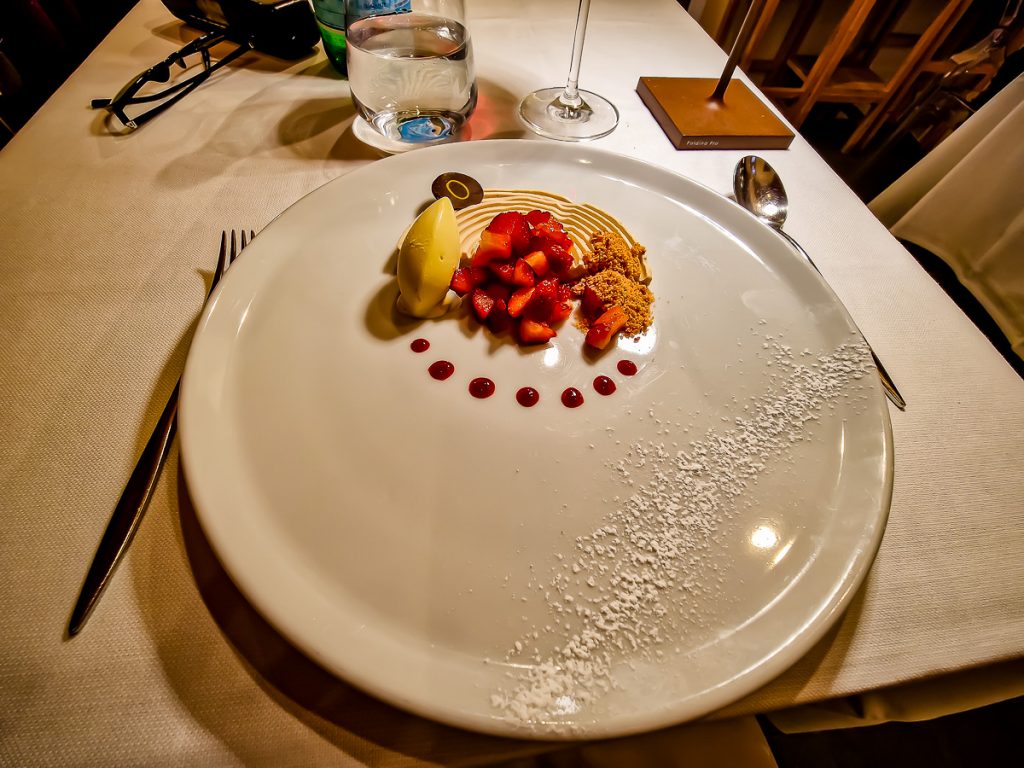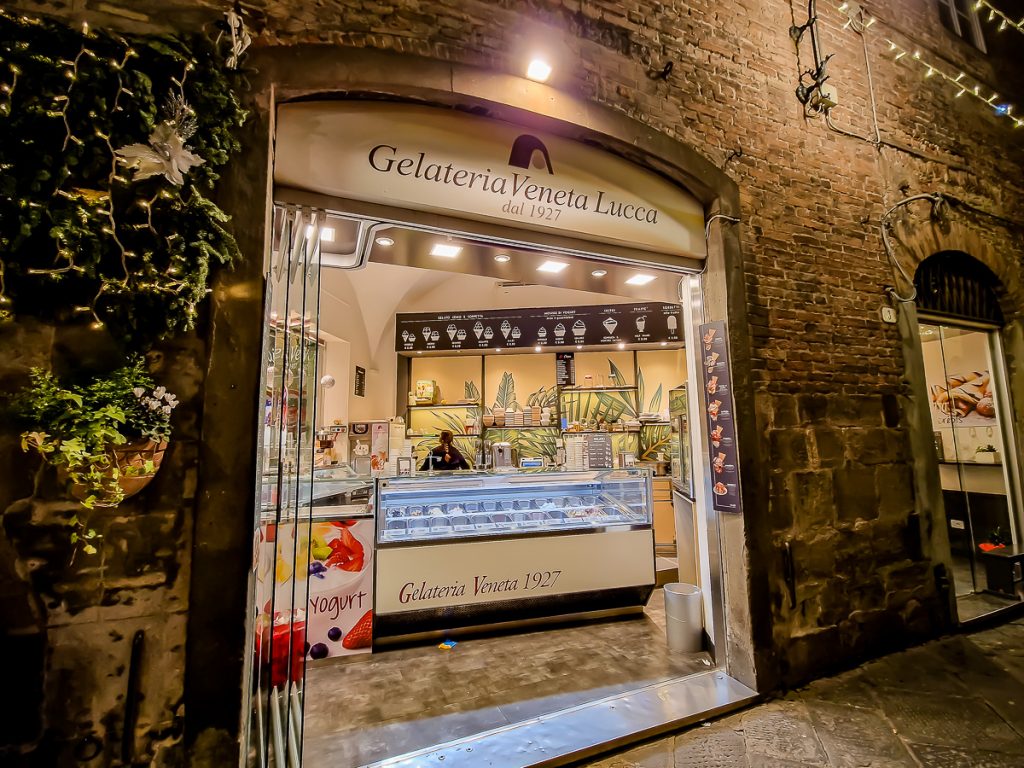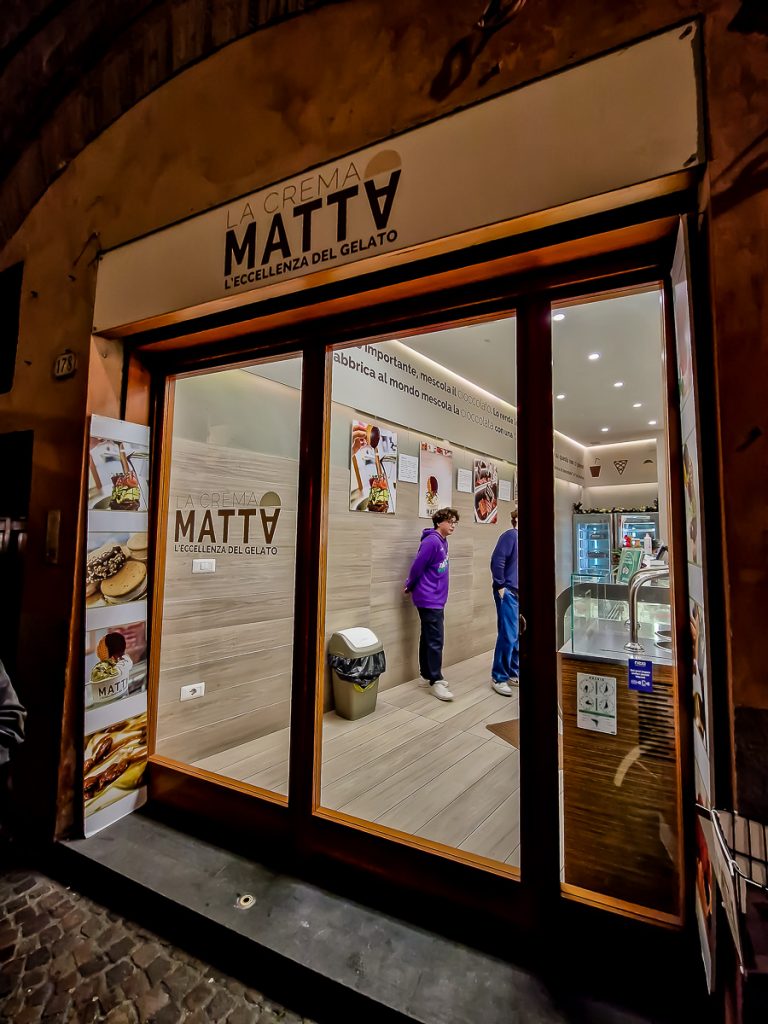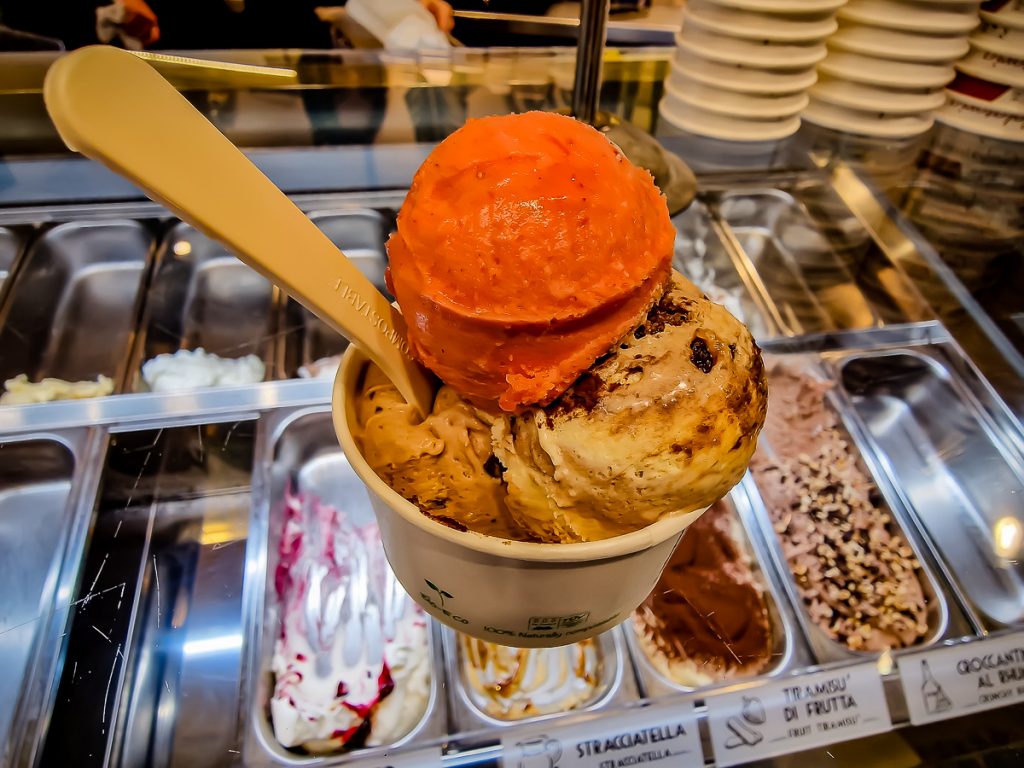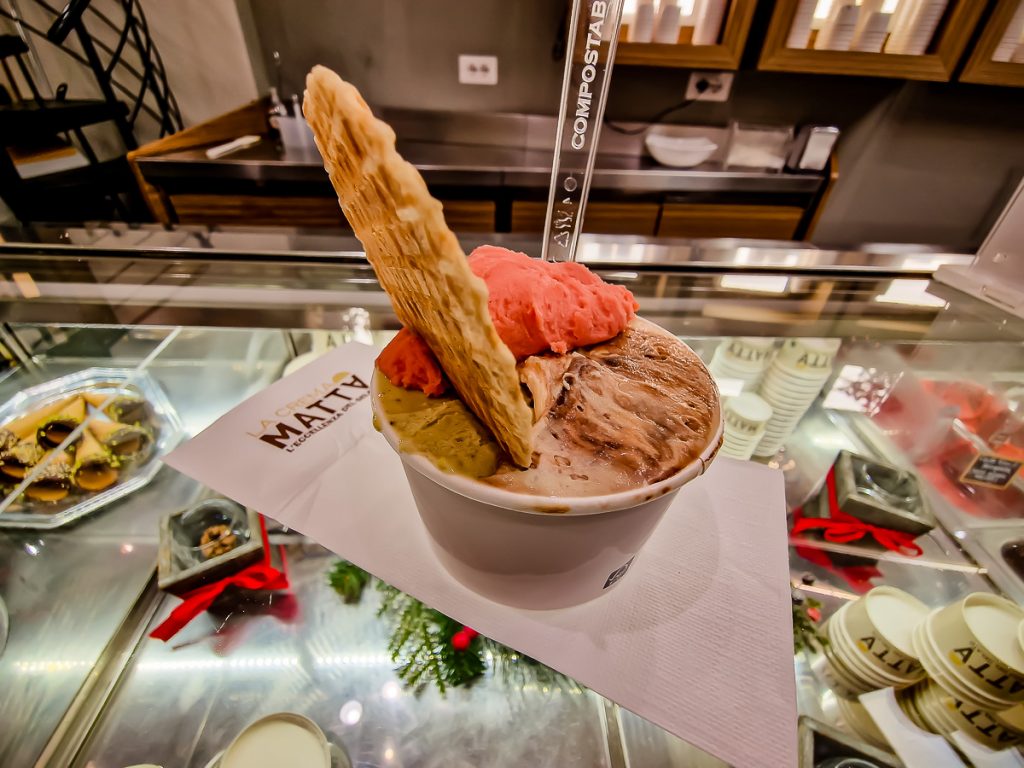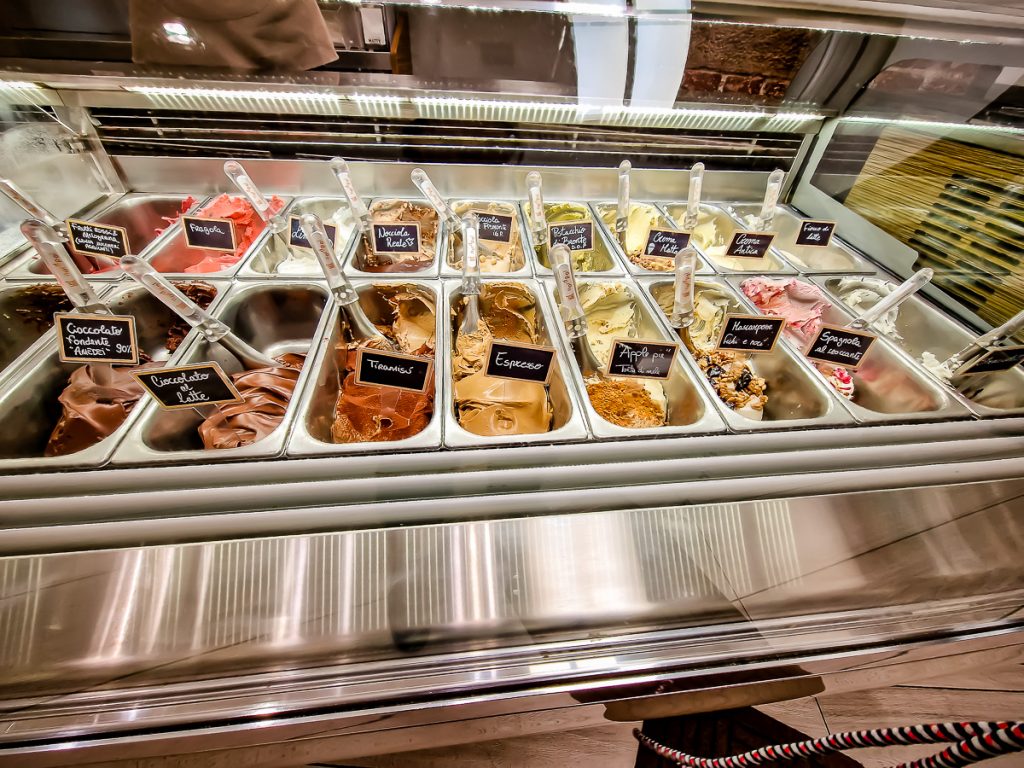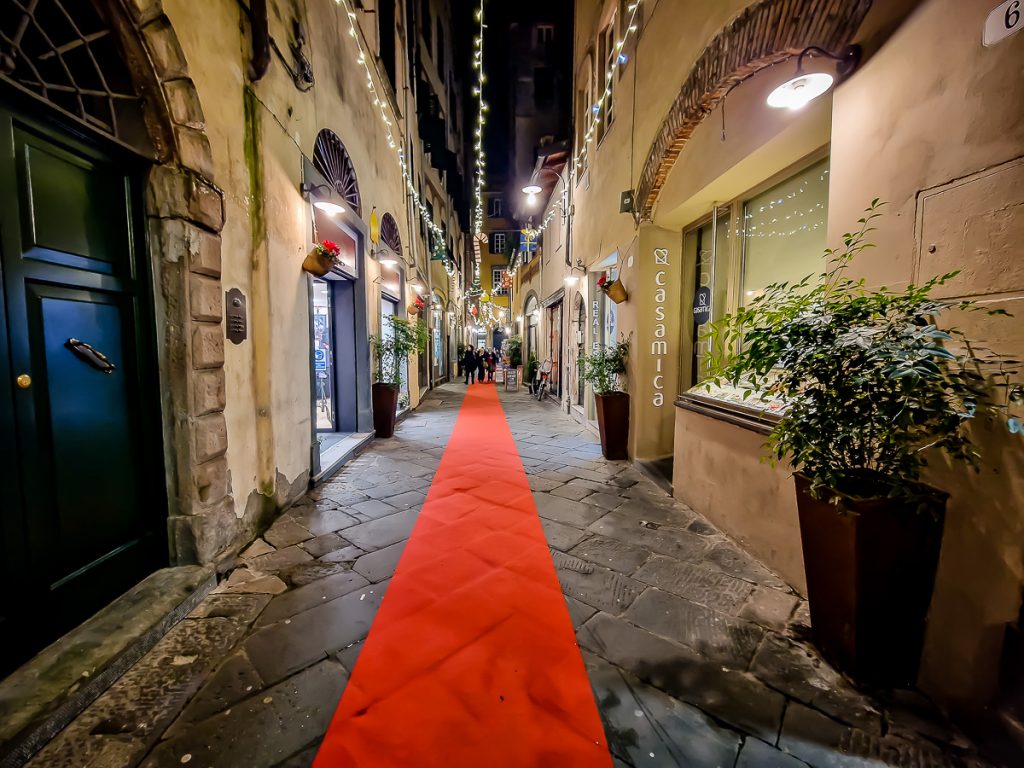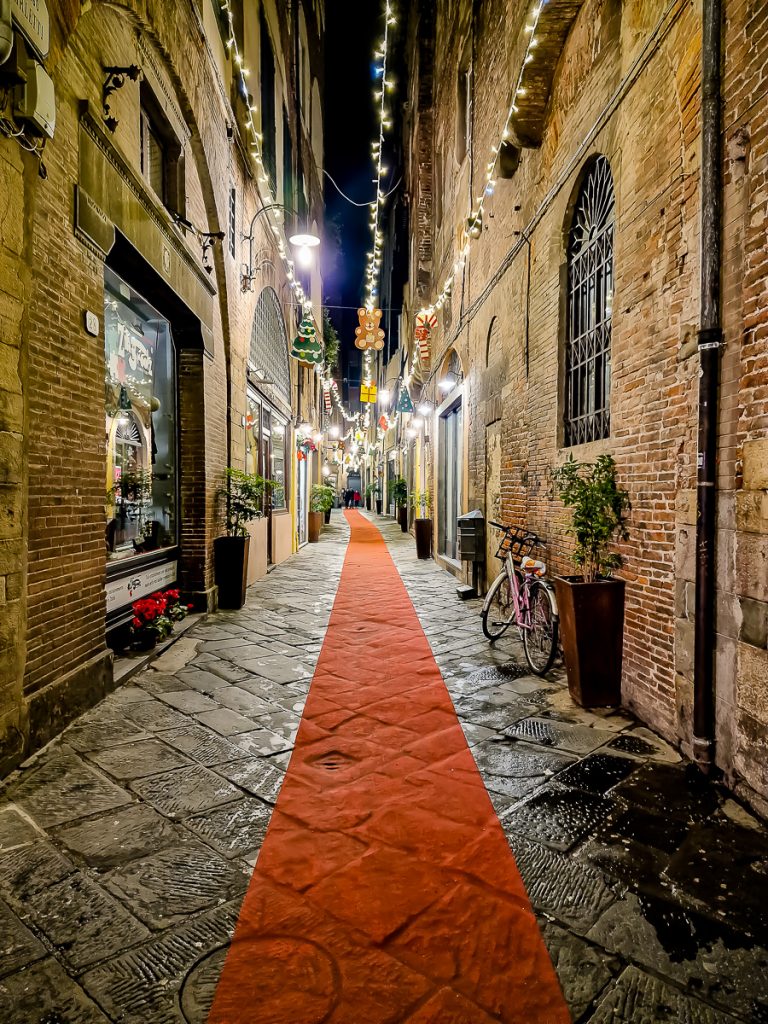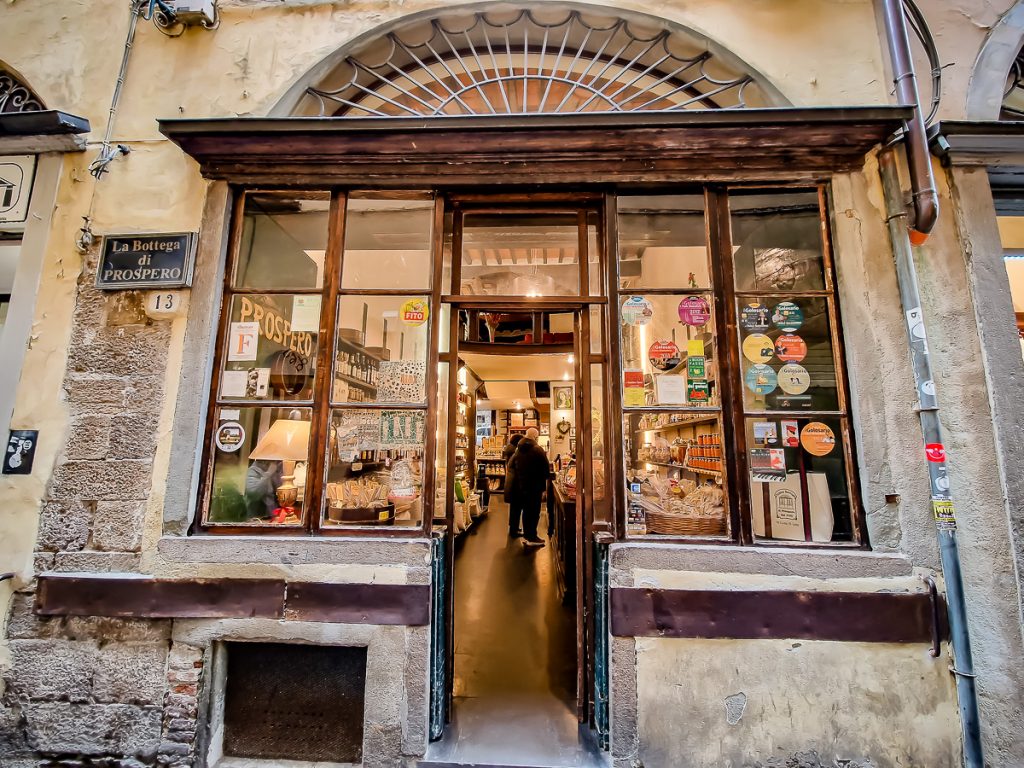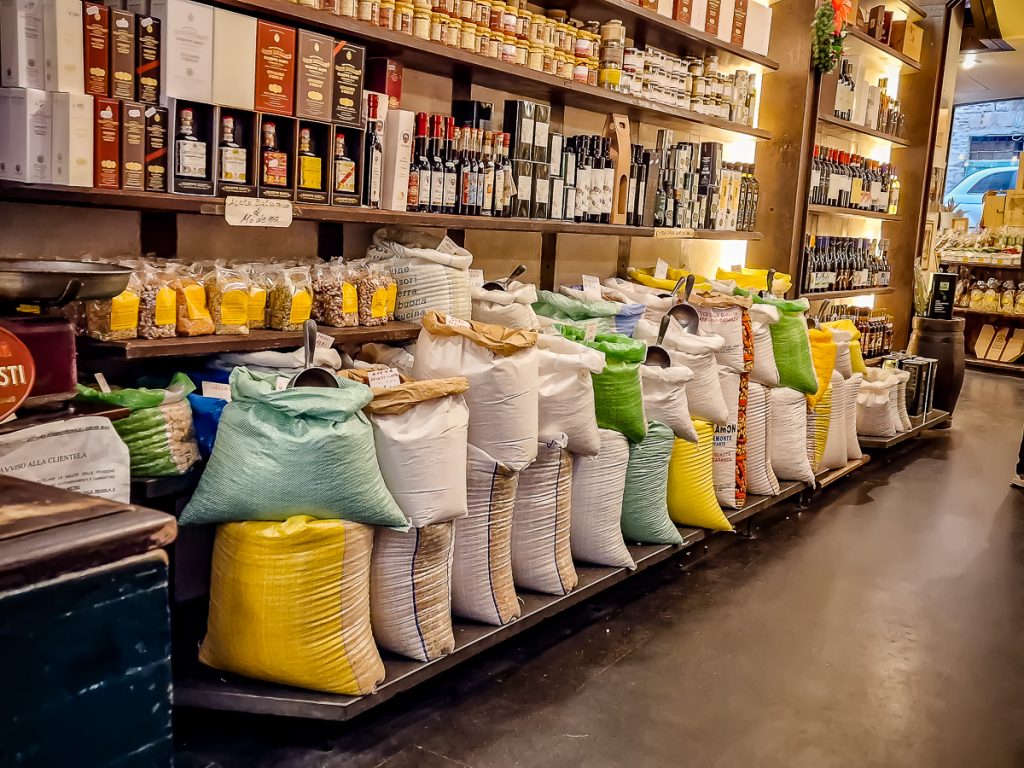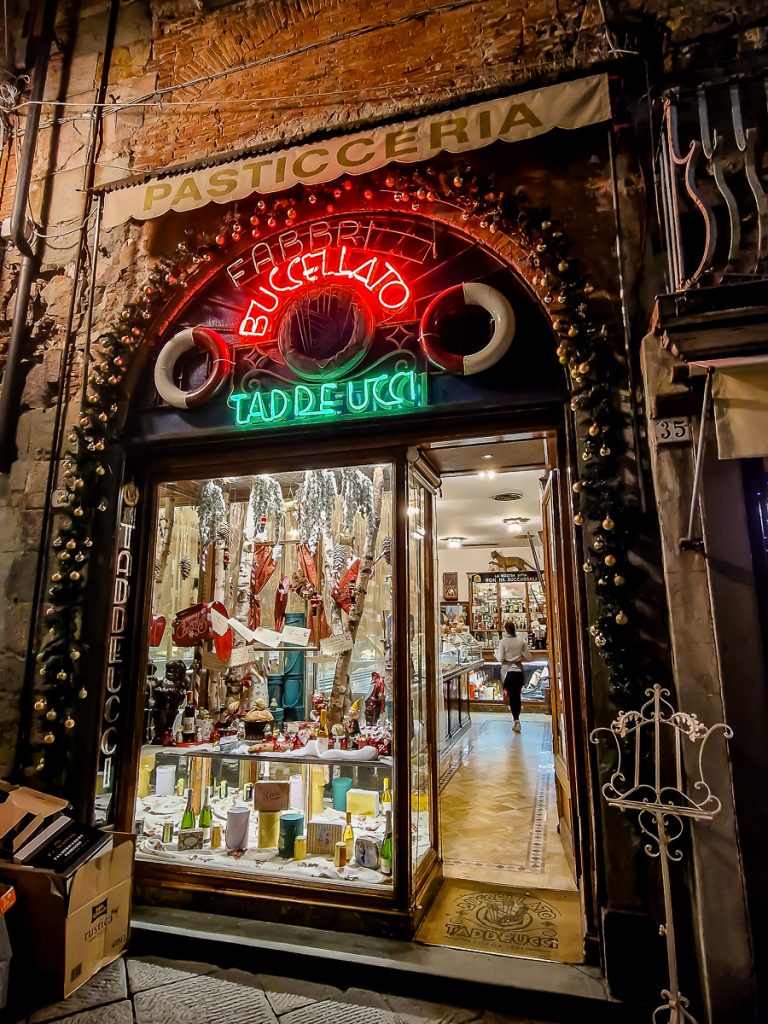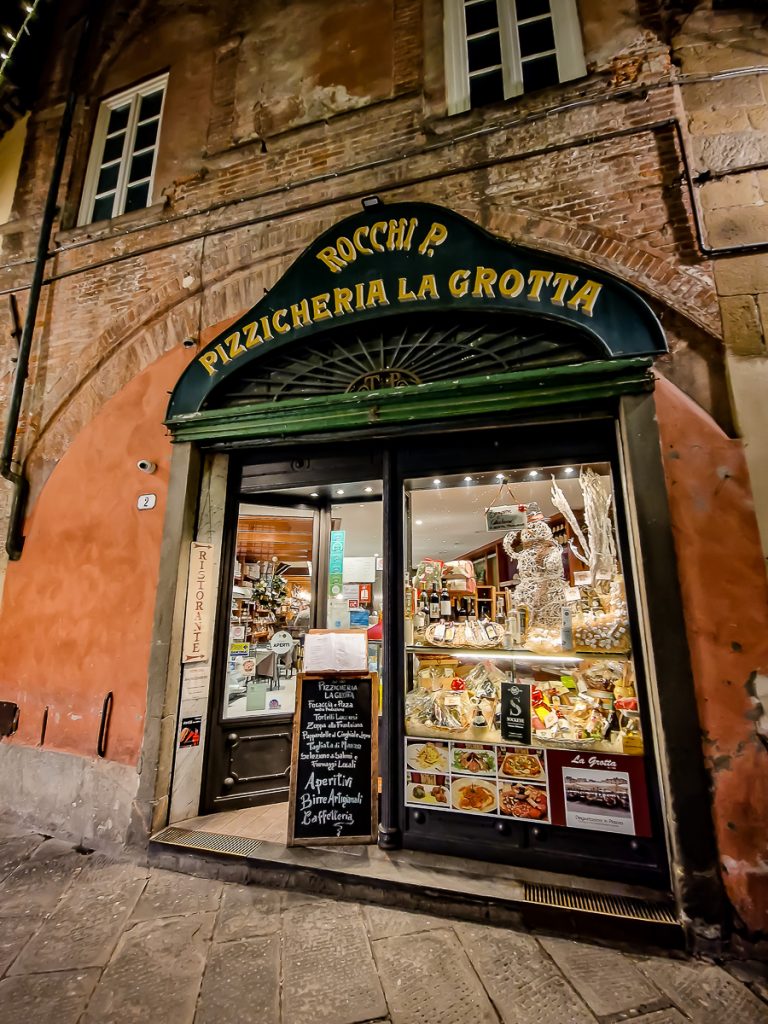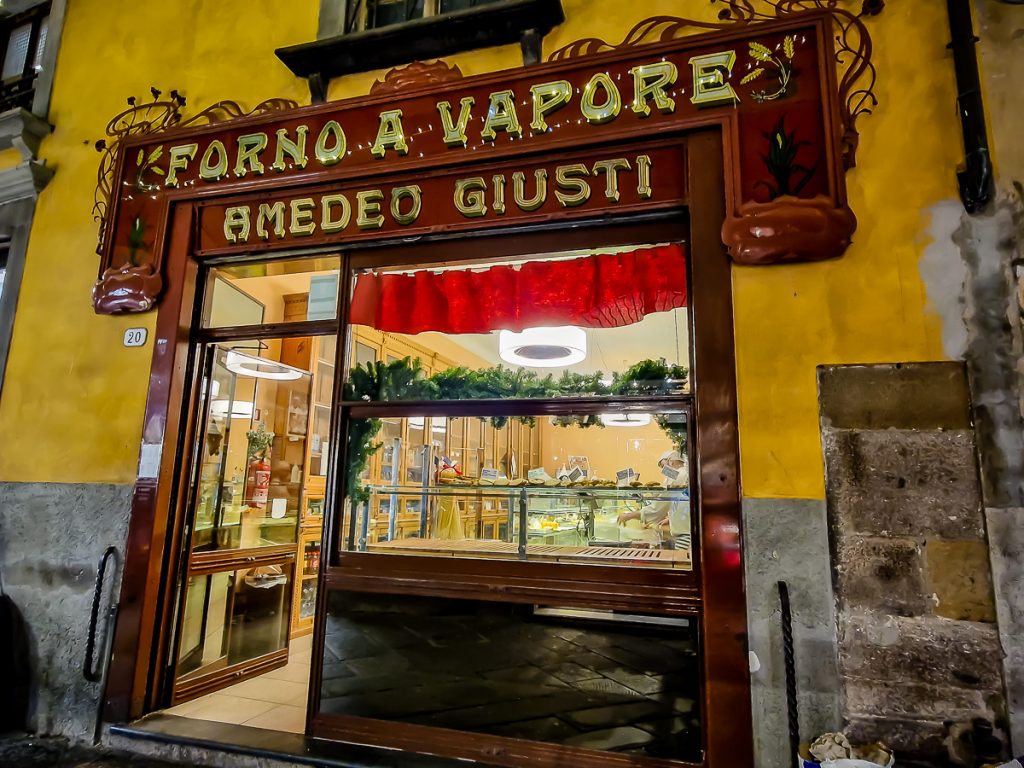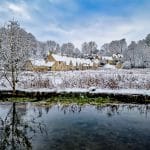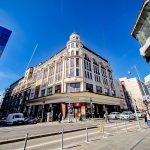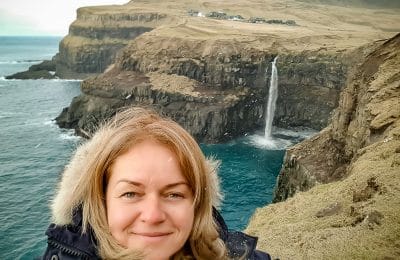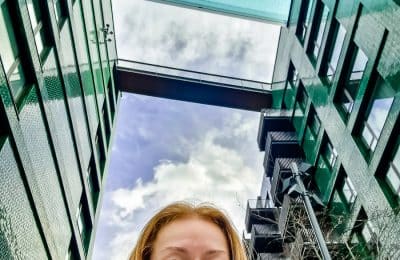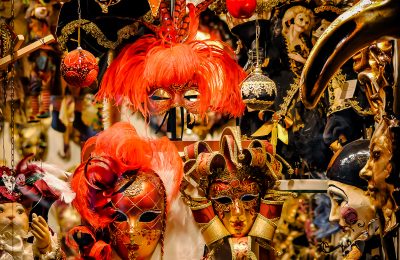Helplessly in love with Florence, during my frequent visits there I sought to see other cities in Tuscany or even further from it, too.
That’s how I discovered Lucca. The first time in 2016, and now again, on New Year’s Eve 2023.
HOW TO GET TO LUCCA
An hour and 46 minutes Bucharest-Pisa flight, a train ticket bought at an airport counter, then hop on a small subway-like train, which took me from the airport to Pisa Centrale Station in 5 minutes.
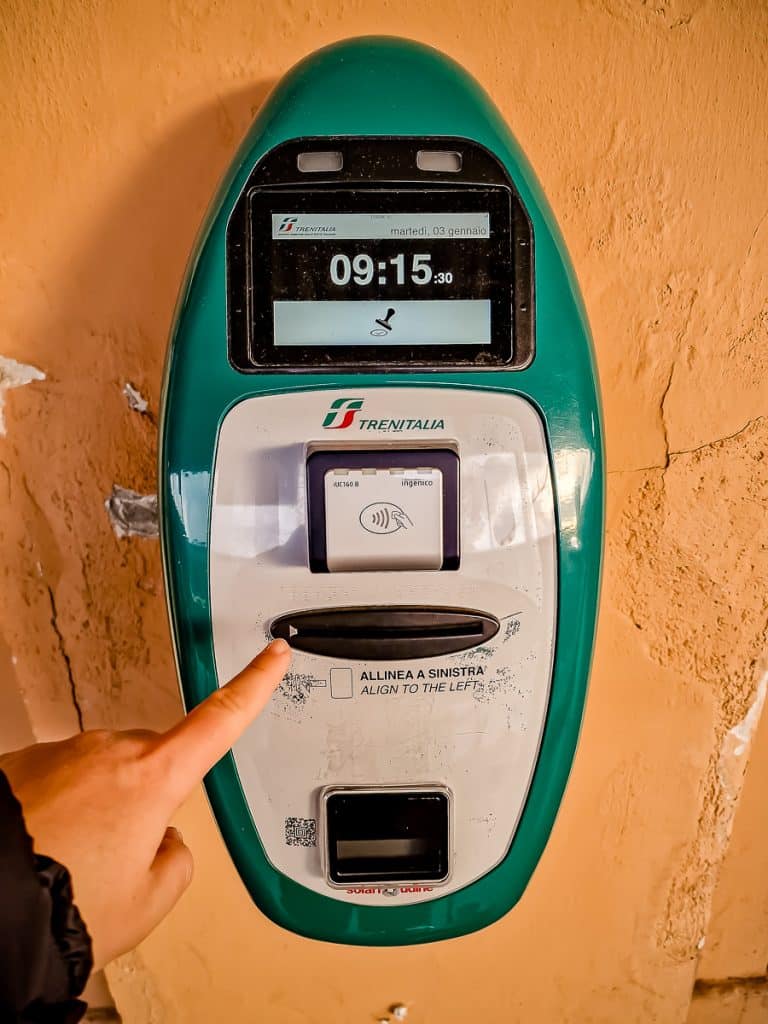
If I have learned anything from the many train journeys through Italy, it is that you must validate your ticket at such a machine in the station or on the platform, BEFORE you get on the train. Otherwise, you are fined! And it doesn’t get validated anyway, you have to align it to the left!…
I was lucky because I stood on the platform next to the controllers and, when I asked them where the hell the machine was (as there was none on the platform), they told me to forget about it, because I would miss the train. They said to skip the validation, because I look like a serious person, with a valid ticket, which I will not use again later…
After 27 minutes of traveling with such a very slow regional train that I counted all the branches from the trees, I arrived in Lucca!
The first time I came here from Florence. By train. 30 minutes. I didn’t know anything about Lucca, but I was fascinated by the information that „you can walk on the city wall”. How come?!? I couldn’t really imagine how, so, as soon as I left the station, I went straight towards the wall… And I was extremely surprized when I discovered it!
WALLS OF LUCCA
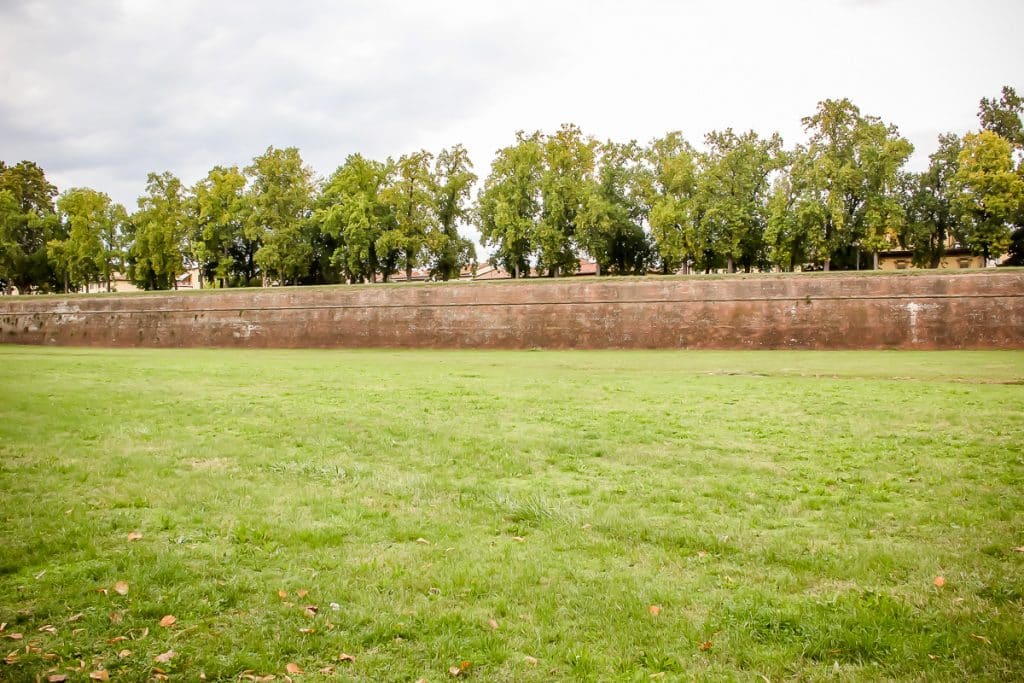
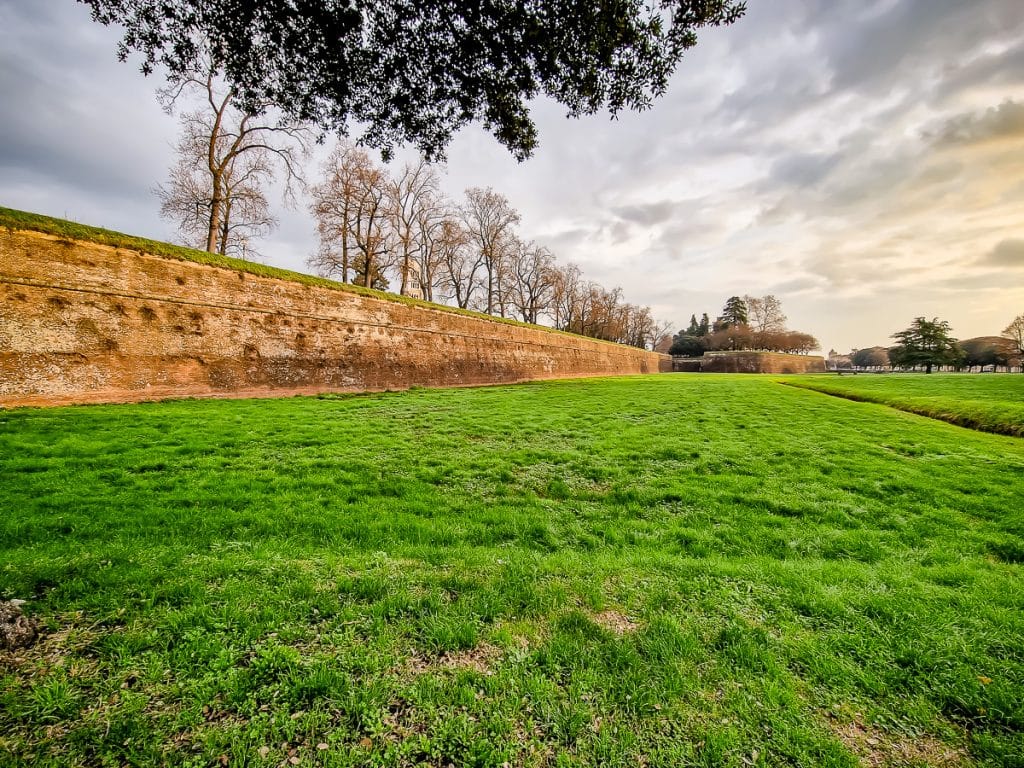
The wall surrounds the city, with everything it has that is most beautiful and worth visiting…
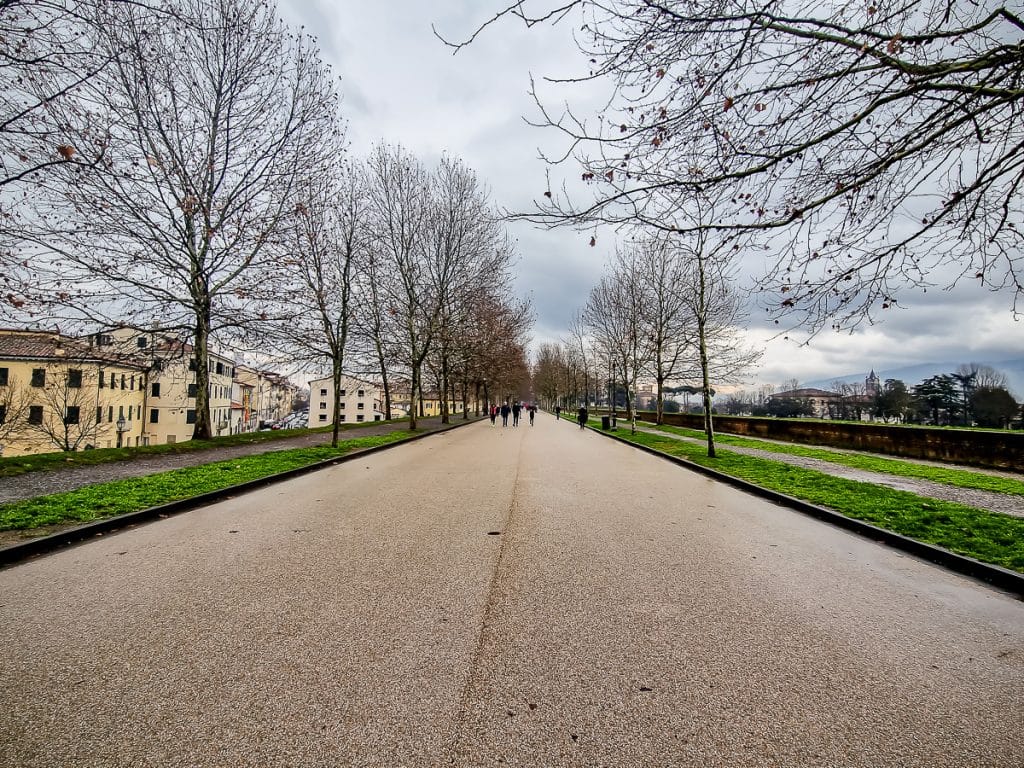
From place to place, there are access paths on the wall, you can practically climb it from many parts of the city. You go up and you get… into a park! Because the wall is so wide, trees, buildings, bastions, walkers, runners, cyclists, people with dogs or even groups of tourists can all go on it. A parade would fit here too!…
You have benches where you can rest, you have water pumps, so you don’t die of thirst, you have a beautiful view of the city, so definitely, I found it fascinating!
There are 4 kilometers of wall that surrounds the city.
You can keep walking on the wall, until you return to the point where you started. If you lose interest, you can go down to the city at any time.
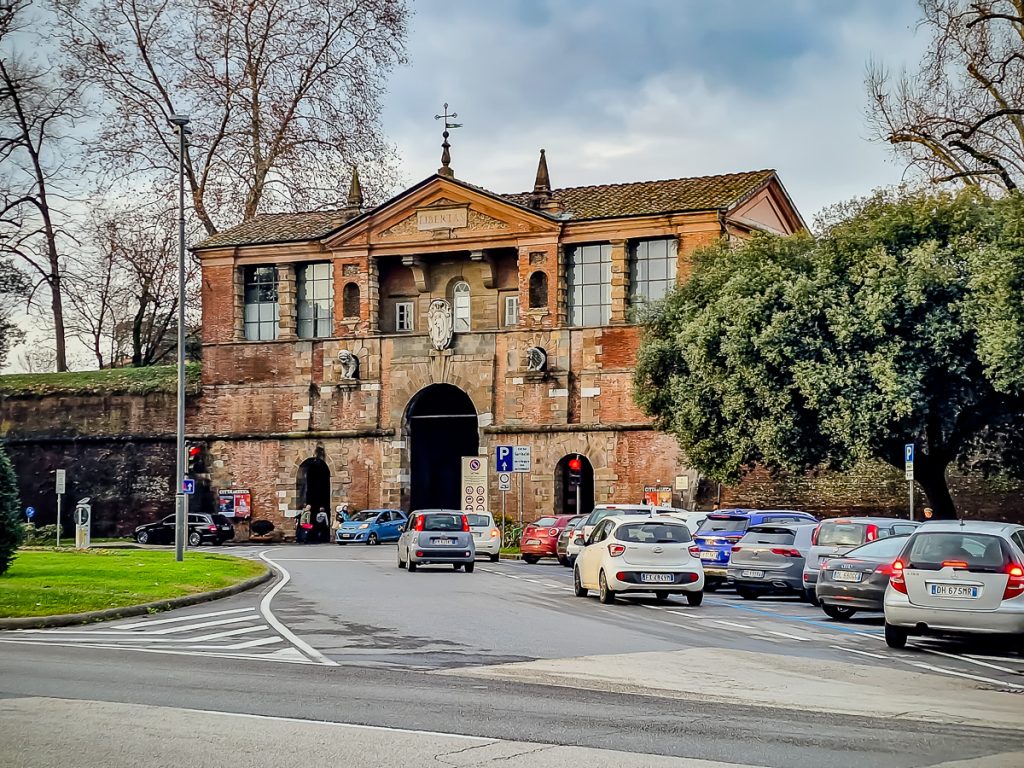
The clearest ways to access the wall are the city gates, but there are also steps or paths that take you up the wall at other points in the city as well.
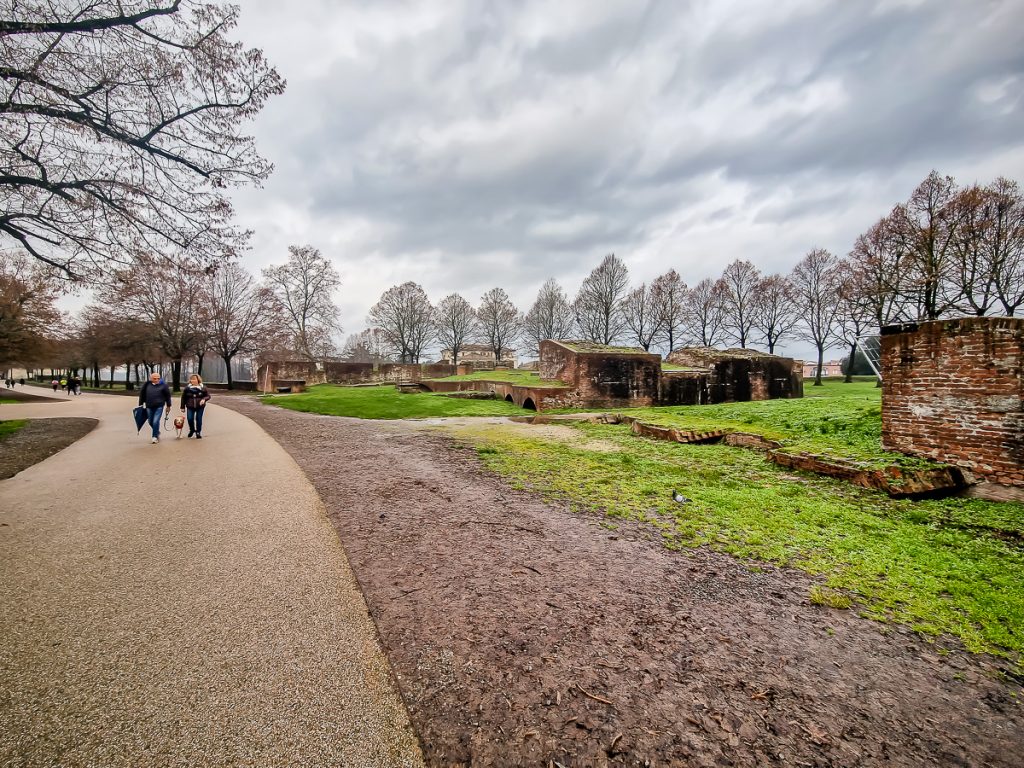
In the beginning there was a wall built by the Romans – I learned from the tour guide I just caught at one of the city gates (Porta San Donato). There are still some traces of the Roman wall. Moreover, Lucca owes the concentric plan of its center to the Romans.
You can find some more traces of the wall built in the Middle Ages – because one was also built at that time. Some remains are right here, at Porta San Donato.
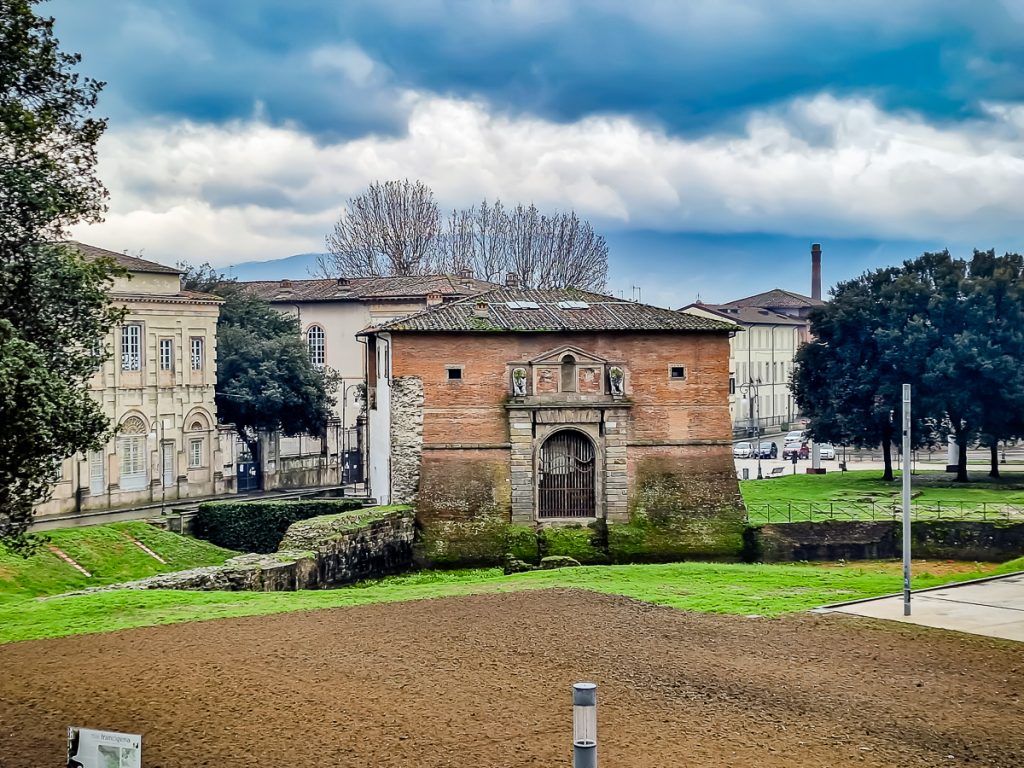
Basically, there are two gates here – the old one, from the Middle Ages, which today houses the tourism office – and the new one, of the wall built during the Renaissance.
In the Middle Ages, the wall was 11 meters high and 2 meters wide. Two meters only?? Well, naturally, during the Renaissance, needs and ambitions increased. Man, let’s build a wall like never seen before, it seems that the people said to each other then. And that’s how construction began (in 1544), a construction that lasted for 106 years! Kind of like in Bucharest on the subway, in the 21st century J.
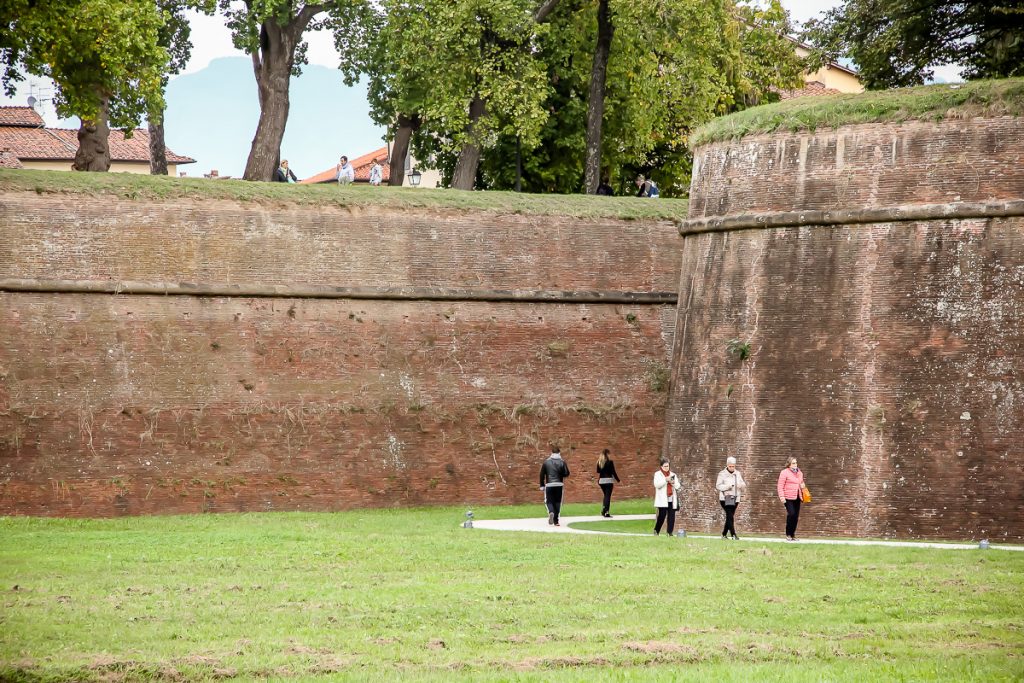
The current wall, the one that people built in the Renaissance, almost 500 years ago, is 12 meters high and… 30 meters wide at the base!!! „Three-zero”, yes, you read that right.
They dug as much as they dug, and they collected tons of earth. Basically, how did they do it? They created mountains from the earth, to help them with the wall. This is why the trees grew so well! If the outer part of the wall is made of brick, the whole inner part of the wall is a mound of earth!
This new wall kept Lucca away from any enemy. It was very complicated to come and conquer it. Before hitting the high and thick wall, you would come across a trench dug around it, where the inhabitants put water, in case of threat. And… ready, set, go to swim!
Moreover, no construction was allowed on the large land outside the wall, no trees were planted, so the visibility was one to envy! They saw everything that moved around!
For this reason, I understand that Lucca had a parallel history with Florence. It was not conquered, and the powerful De Medici family did not manage to mark its territory here either…
Lucca resisted until Napoleon Bonaparte.
The wall still “resist” today and, if in 2016 I walked only a part of it, now I have set my ambition to walk the entire length of 4 km, starting from one point and finishing the walk at the same point.
What a “walk”, ma man, it was like a marathon! 45 minutes of brisk walking took me to finish the entire tour. And it also took all my clothes becoming wet!
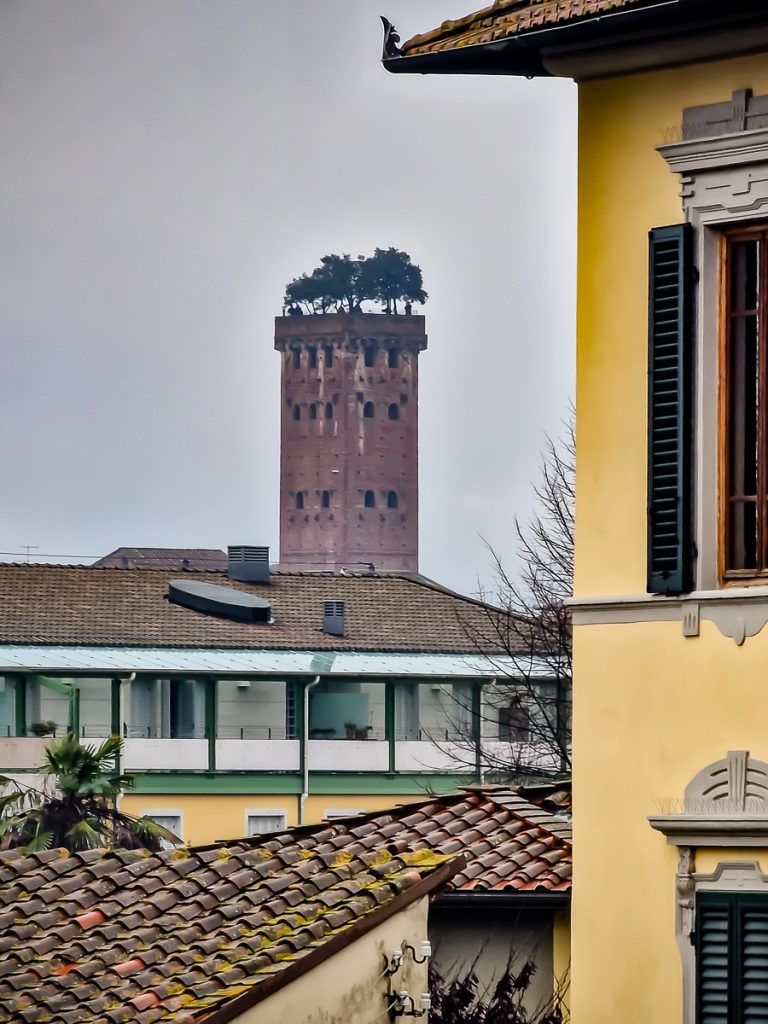
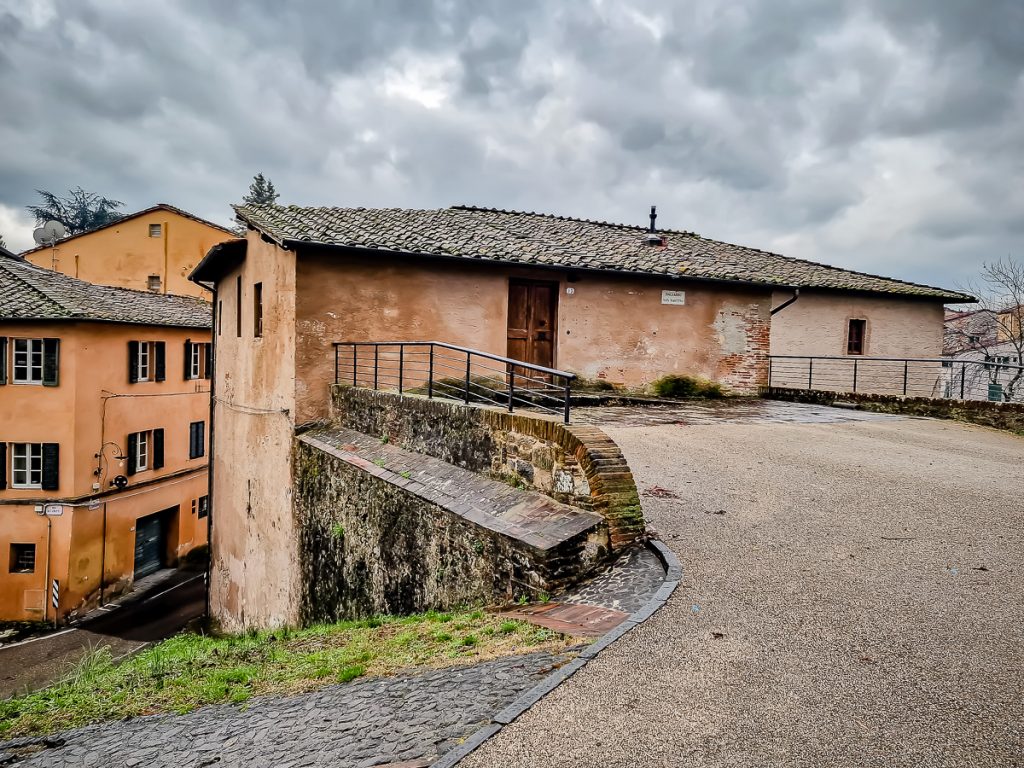
But I enjoyed everything I saw from above – Torre Guinigi, which I can’t wait to tell you about – and I photographed everything that came my way on the wall, such as the Bastiones or the Mint Museum!
PFANNER PALACE
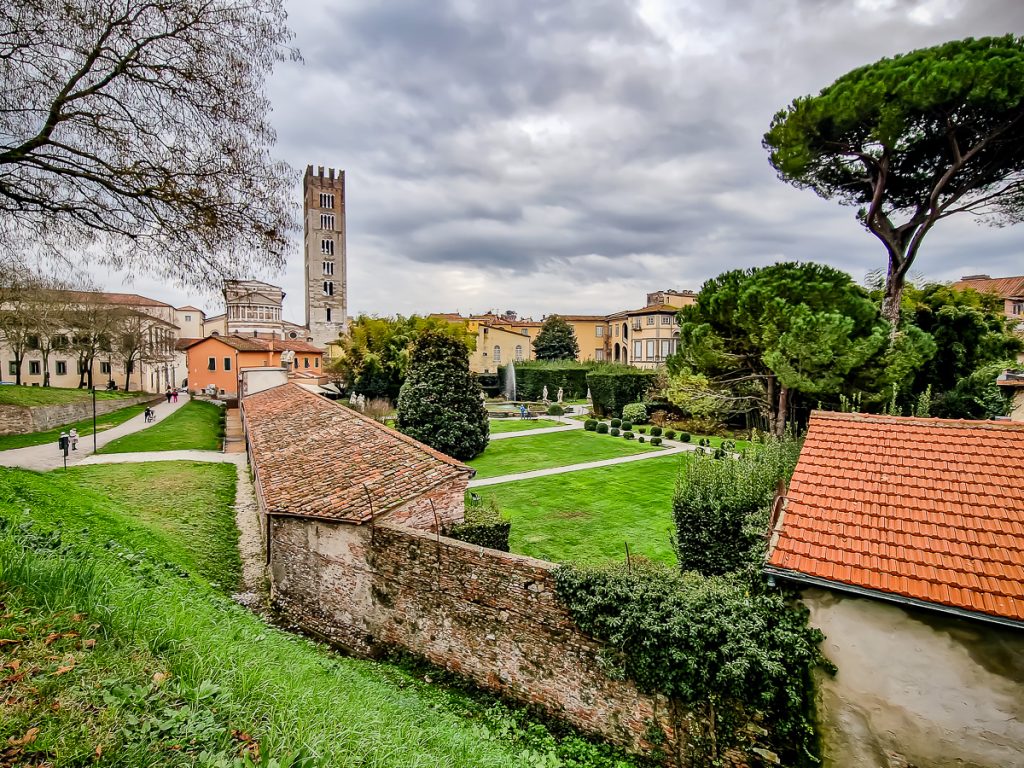
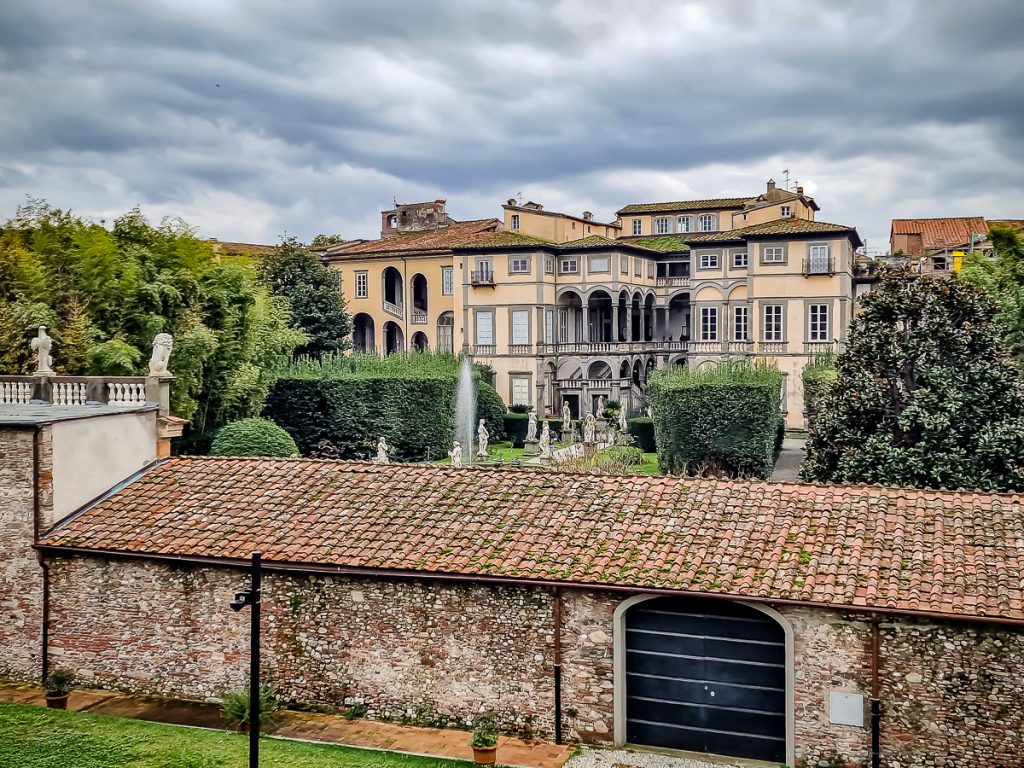
From the city wall, I admire a huge villa, with a beautiful garden, even now, in winter!
It’s not “villa”, I’m told, but “palazzo”. “Palazzo” = winter residence, while “villa” = summer residence, outside the city. Ok… Good, I’ve learned something.
The Pfanner Palace dates back to the 17th century and belonged to a rich family that dealt with the silk trade.
Then it was bought by an Austrian, Mr. Pfanner, who just jumped the fence to come here, because he lived close to the Italian border.
This man made one of the first breweries in Italy!
What’s cool is that the family of the Austrian Pfanner still owns the house. They live on the upper floors, while the first two floors and the gardens are open to the public. You pay 6.5 euros (full price, as there is also a reduced price) and you can take a walk around the house and the yard.
What’s even cooler, is that, on the road, as we followed our guide like sheep, we met one of the owners! Ha! A guy in his 50s, very normal in attitude and attire. I wanted to ask him when he was putting the palazzo up for sale, but I decided to wait until I won the lottery first.
Lucca has about 89,000 inhabitants and a lot of dogs! I have never seen so many dogs per square meter in my life. They kiss, they growl, they smell each other, nothing out of the ordinary.
However, it seemed unusual to me that 90% of the Lucca people stay outside the walls and only 10% inside! I thought I was smart enough to say that, probably, because of the prices. Not necessarily because the houses here are more expensive, the guide tells me, but because outside the walls you could have facilities that some people really care about. For example, you can have a garage for your car. Or a yard.
When you ask a Lucca person where he lives, you ask him: “do you live inside or outside?” J
All tourist attractions are inside the wall. And I am determined to (re)discover them. Compared to a few years ago, when I only stayed for a few hours, on a train escape from Florence, now I’ll stay for several days!
CATHEDRAL – DUOMO DE SAN MARTINO
When I came down from the city wall for the first time, in 2016, I went to the very center of the city, where I was impressed by the church San Michele. So I got to work: making selfies.
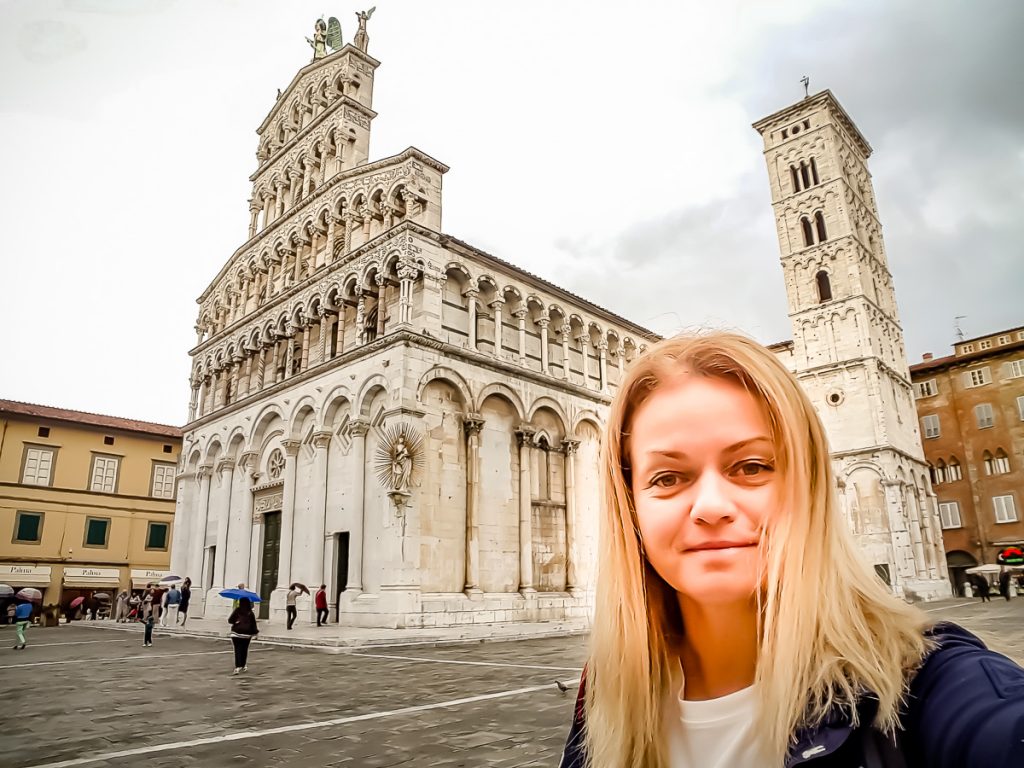
Except that San Michele is not the most important in Lucca, but the Cathedral (Dome). So let’s go to the Cathedral first!
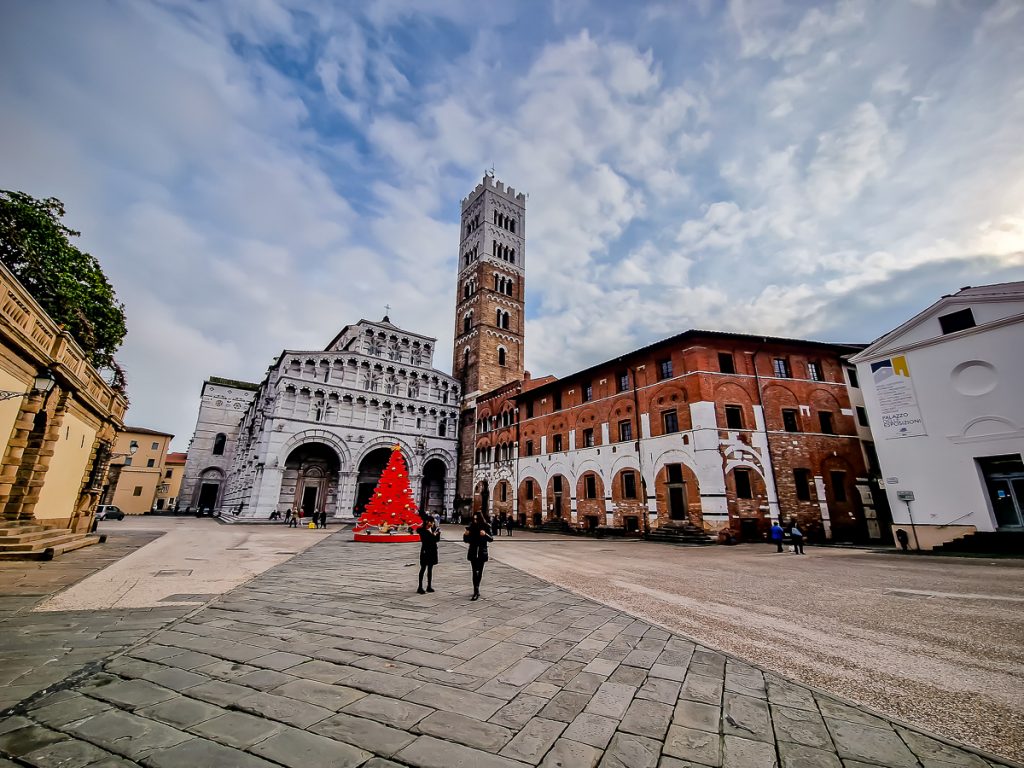
It is one of the few cathedrals in Italy that is not dedicated to the Holy Virgin Mary.
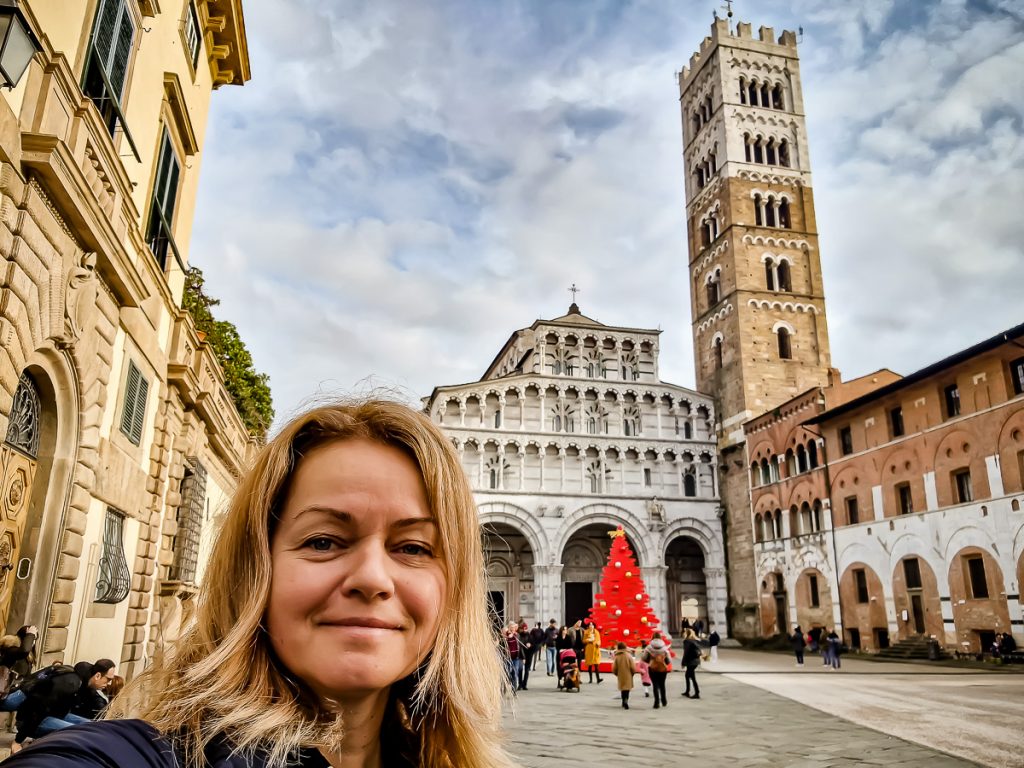
I, a wrinkled virgin hihi, start to listen to info about the Dome, to read and to observe…
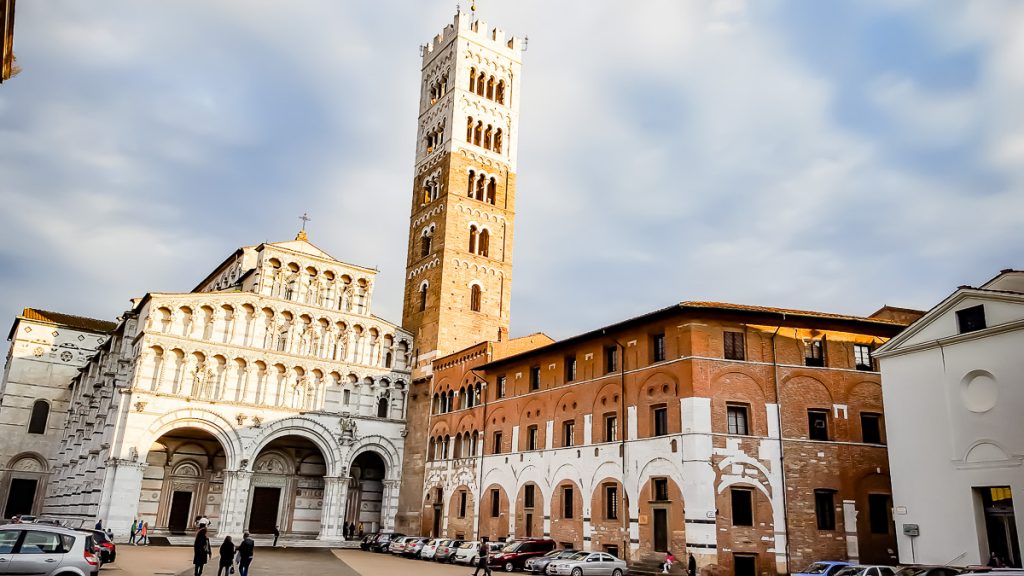
The asymmetrical facade of the Cathedral (the left side is larger) is especially famous for its engravings dating from the 12th century.
I see San Martino on the facade, and I also find him inside.
Speaking of the interior: 3 euros is the entrance fee to the Cathedral (January 2023). But you can also buy a combined ticket, for 10 euros, which allows you access to several places related to the Cathedral, such as climbing the bell tower.
Let me tell you what I found interesting from what I saw and learned.
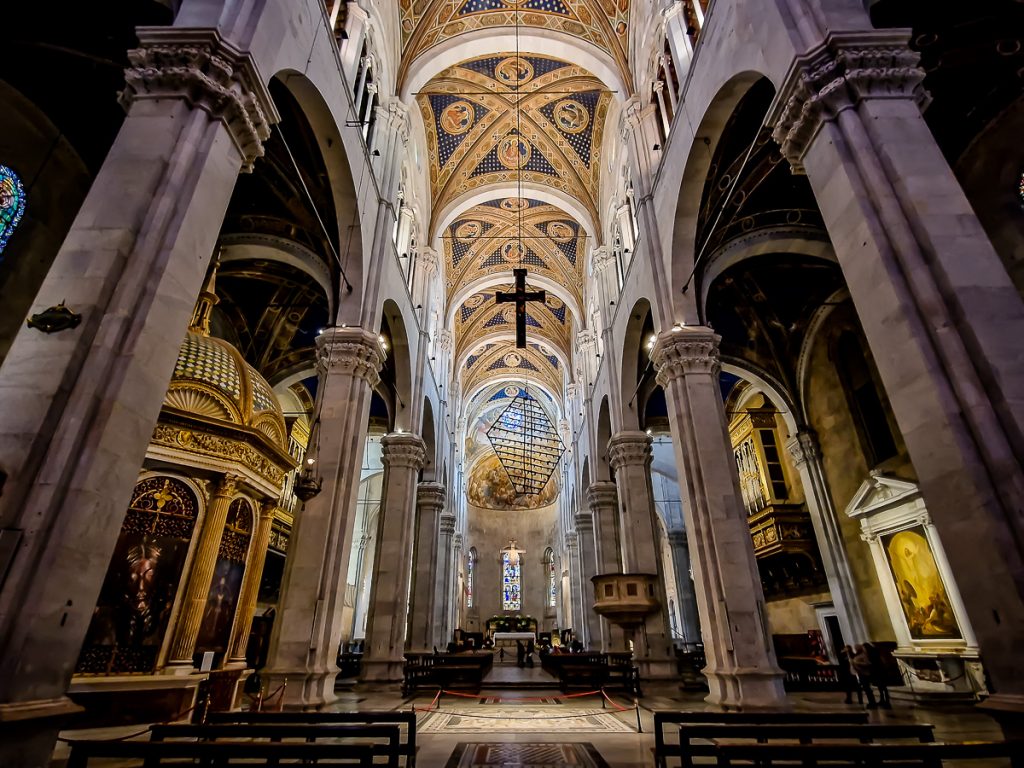
The stained glass windows in the Cathedral were broken during the Second World War. BUT, those from the altar were removed in time and therefore saved! They date from the Renaissance, so it’s worth taking a look at them.
As you enter the Cathedral, the left side is full of paintings about the life of the Virgin Mary. The right side is dedicated to the history of Jesus. Among the paintings on the right side, there is one signed by Tintoretto.
LAST SUPPER TINTORETTO
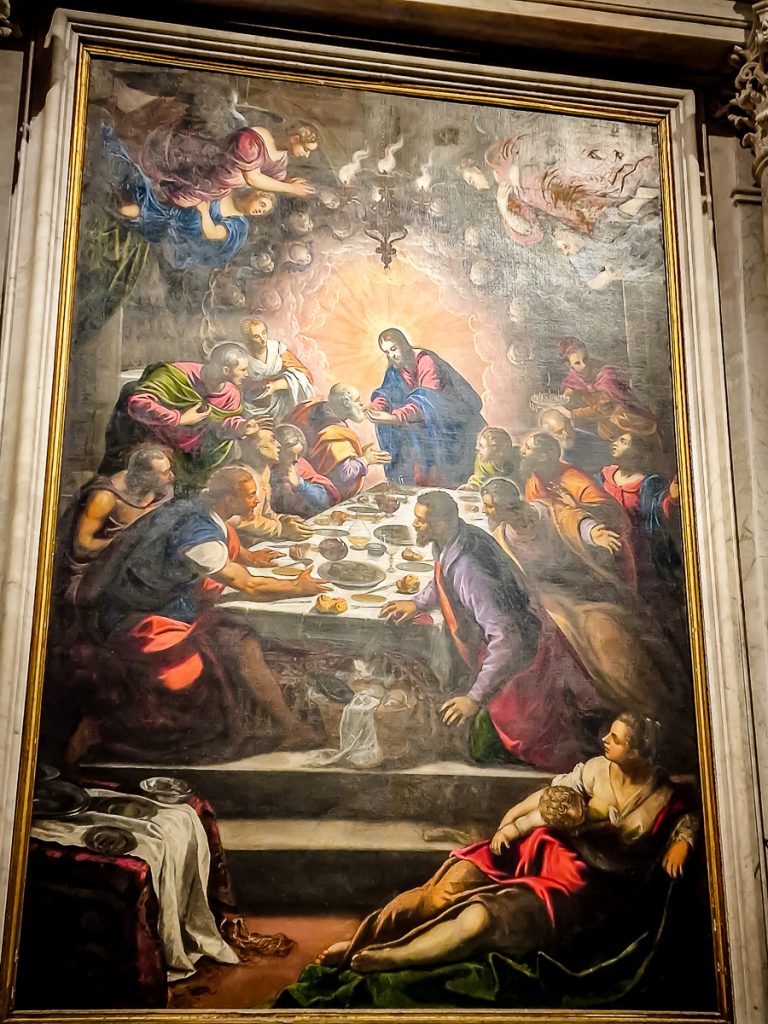
A painting made in very vivid colors, in which there are servants, women (one breastfeeding), an otherwise different Last Supper, where the table is not horizontal, as in the classical representations.
VOLTO SANTO
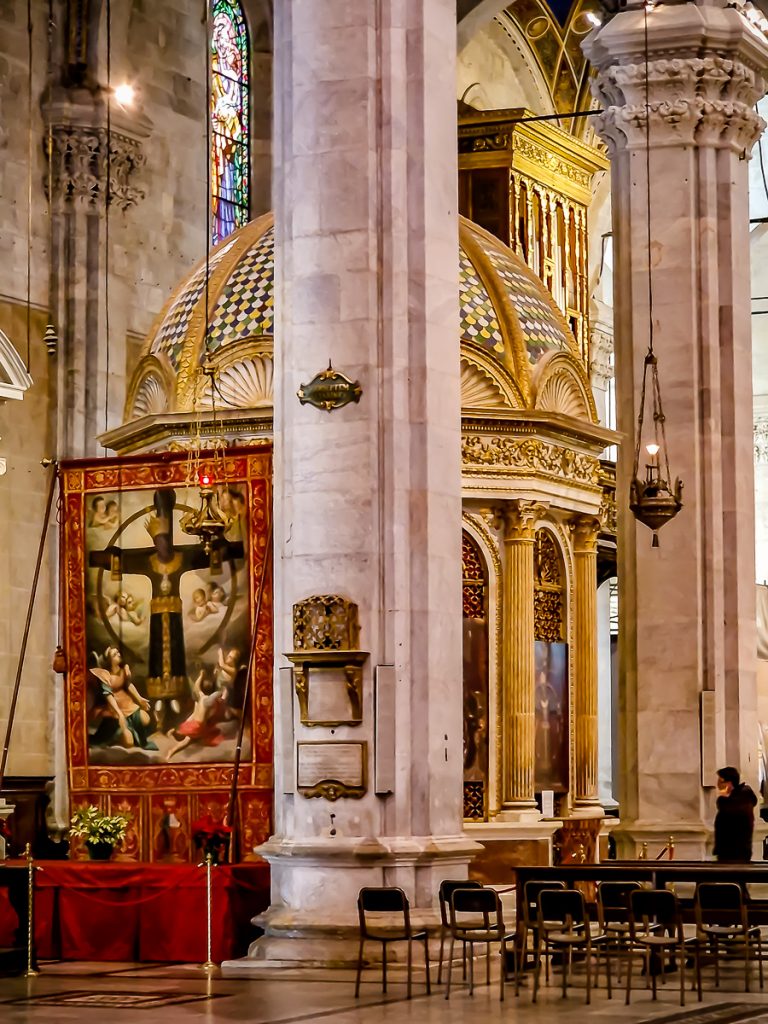
In the middle of the nave there is an octagonal chapel meant to house the precious Volto Santo (Holy Face), a cedar crucifix that is said to have been carved in the image and likeness of Jesus by Nicodemus, who witnessed the Crucifixion. (Another theory is that two angels carved it.)
I did not see it, because its restoration began in September 2022, inside the Dome, in a closed area.
During the pandemic, the carbon sample was allowed and, thus, they were able to establish that the Holy Face dates from the 8th century! It is the oldest wooden sculpture in Europe!
For the Lucca people, Volto Santo is the most important! But, for other Italians, something else in the Cathedral is of major importance.
TOMB OF ILARIA DEL CARRETTO
Once upon a time there was a cunning gentleman in Lucca. His name was Paolo Guinigi (you will hear this name again). The gentleman in question was one of the governors of the city of Lucca in the medieval period.
He had 4 wives and they all died… When the second one, Ilaria, died, Guinigi commissioned a sculptor from Siena to create a marble sarcophagus. It is said that he loved the woman enormously and for this reason he wanted something special for her.
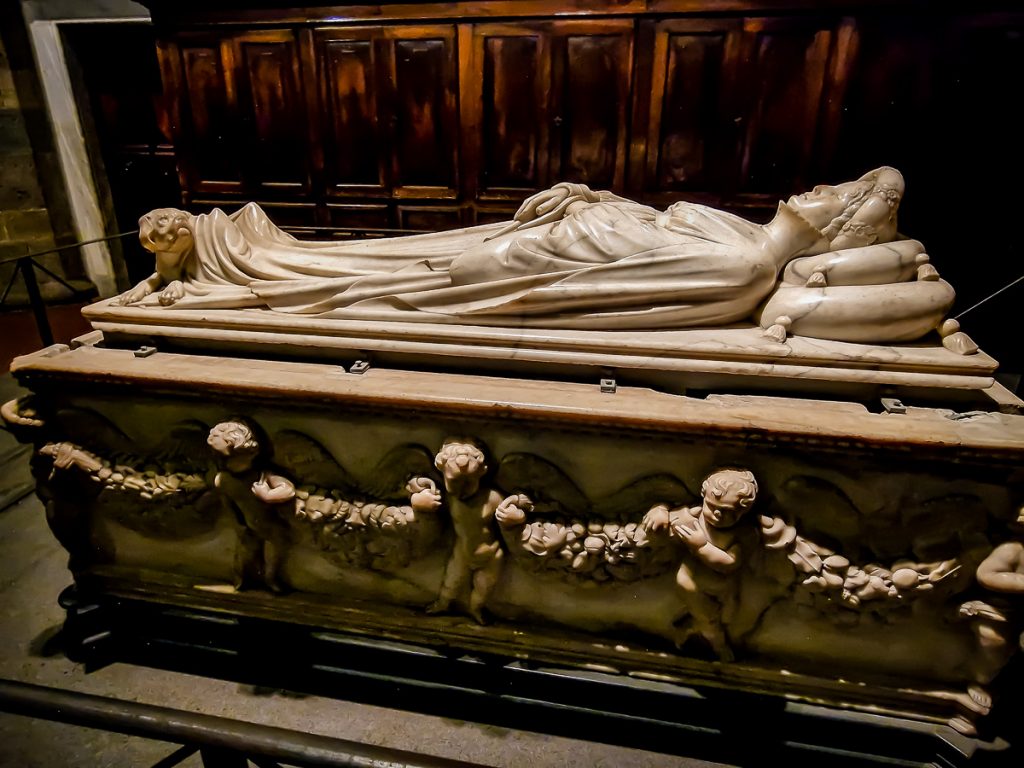
Ilaria’s monument is the most precious sculpture in Lucca and one of the most beautiful in Italy!
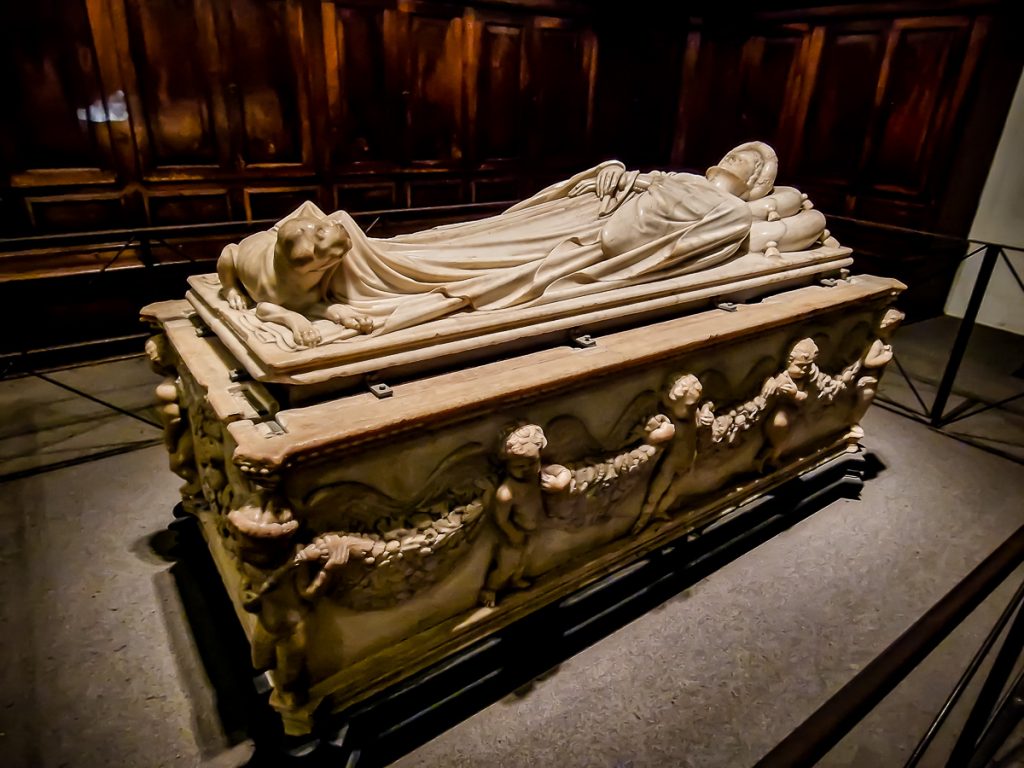
The dog at her feet represents Ilaria’s loyalty, fidelity.
THE LABYRINTH
At the exit from the Cathedral, I see a labyrinth on one of the pillars. I look at it like an intelligence test that I fail with flying colors…
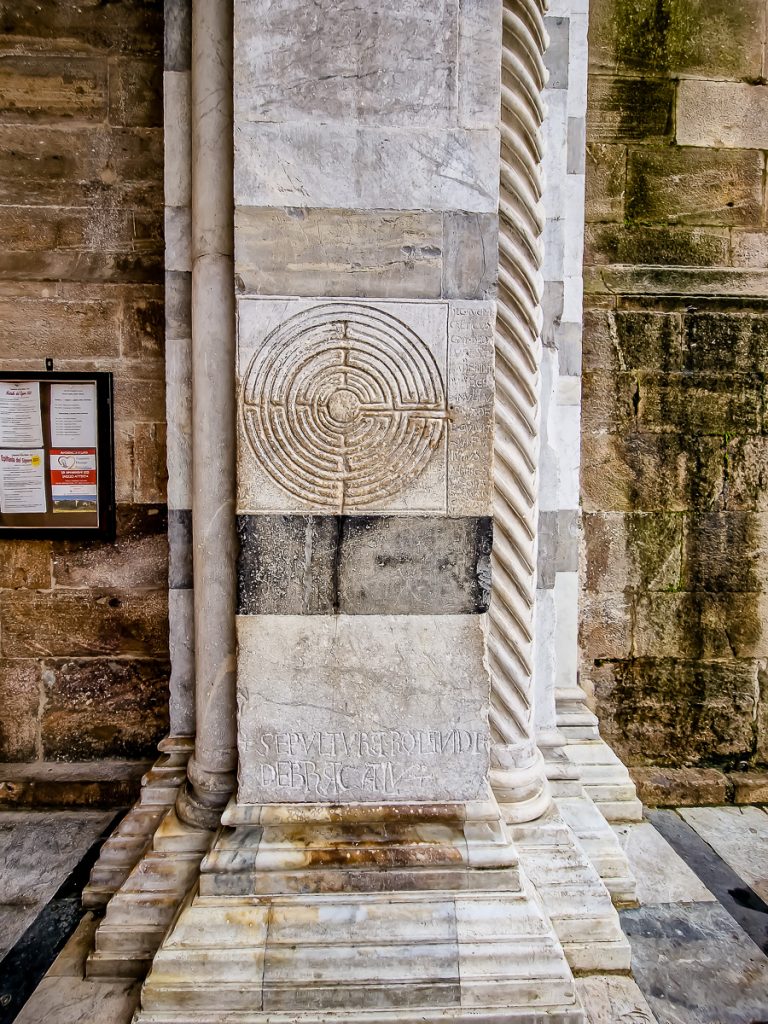
Having the Greek labyrinth as a model, it is related to Theseus, a character from Greek mythology, who kills the Minotaur and manages to find the exit from the labyrinth in which that one was kept, using a thread given by the daughter of King Minos, Ariadne. Extrapolating, the lesson is that it would be good for all believers to rely on God to show them the way.
I read that this labyrinth also had the image of Theseus and the Minotaur, but they were erased over time.
Done with the Cathedral (Dome), I’m going back to San Michele.
On my way from one to another I come across some churches. The city is full of them! Churches and towers, that’s what people built here. There is not much left of the towers, but what is left is worth considering, so I will return to the subject…
What do you know, among the churches I see in Lucca, is one Romanian Church!
Many Romanians come here on holidays or simply for service. They even come from Florence!
When I saw the interior, I realized why: you feel like home and it’s probably the place that soothes your longing for your loved ones.
I happened to get there in the middle of the religious service. It’s January 1, Saint Basil.
SAN MICHELE IN FORO
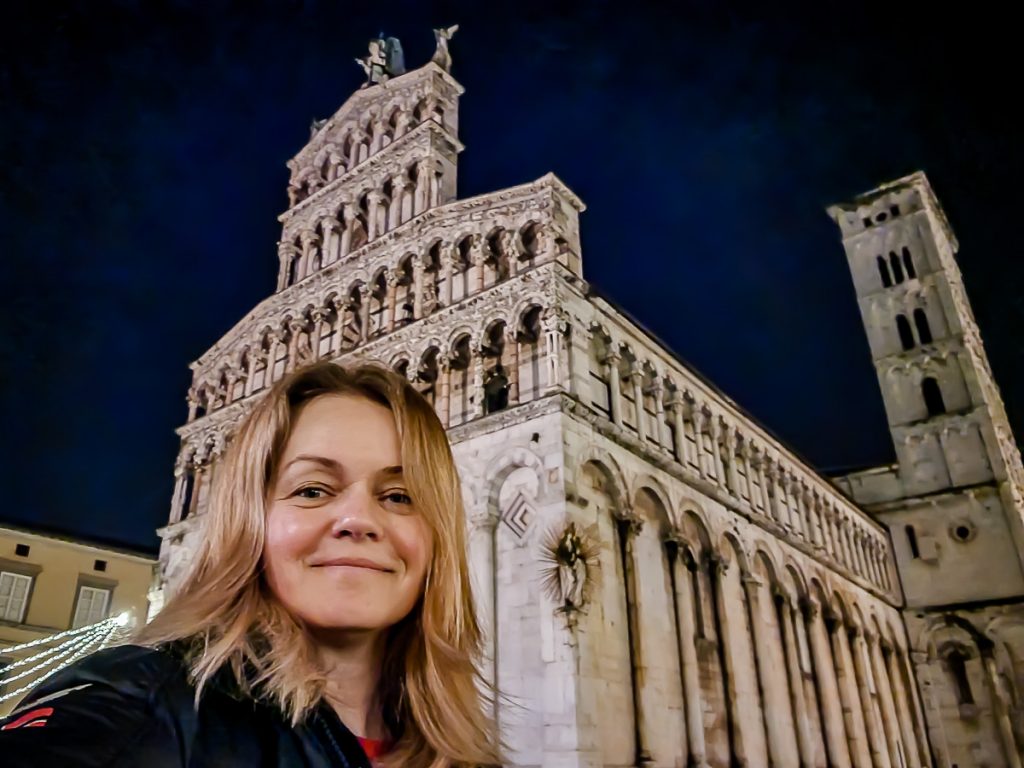
I liked it from the first moment! As soon as I saw it. And clearly this is due to the facade and the position in the city.
I had no idea that it was built on the ruins of an old Roman forum, in the 11th century.
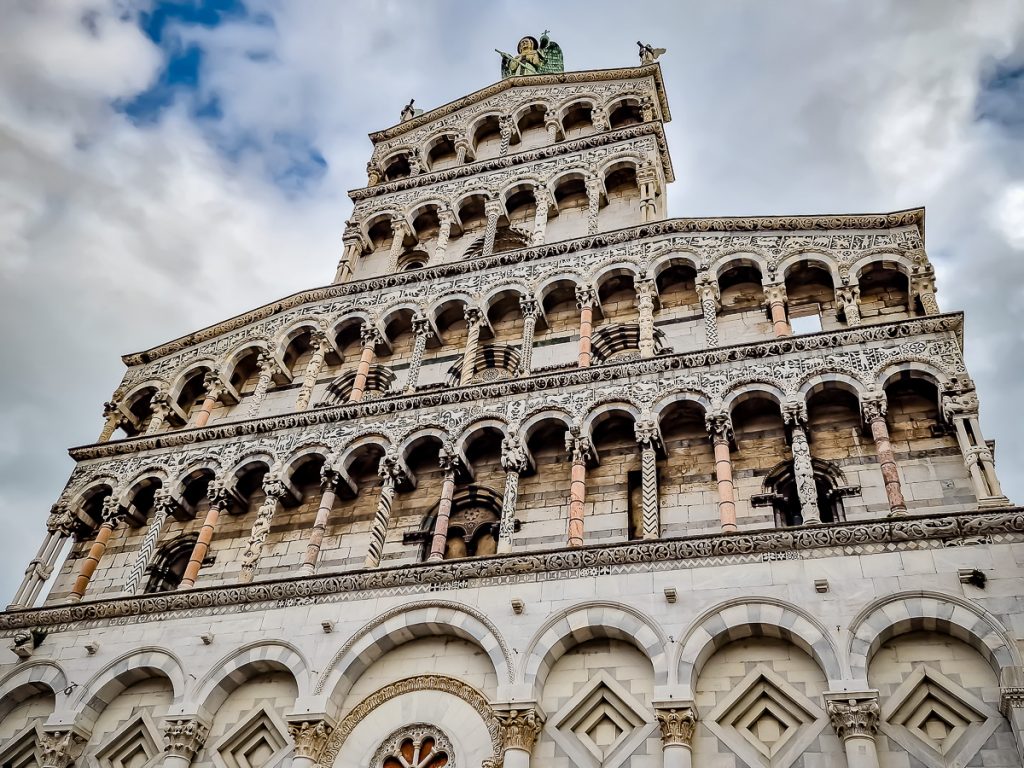
Staring at it and at all the details of the facade, I realize that it is modeled after the Pisa Cathedral (white, gray marble, arches), only that the Lucca people, as far as I understand, also wanted to leave their mark and added to the Romanesque style of Pisa a… original touch – for example, the columns are different in model, colors. I saw this at the Dome too.
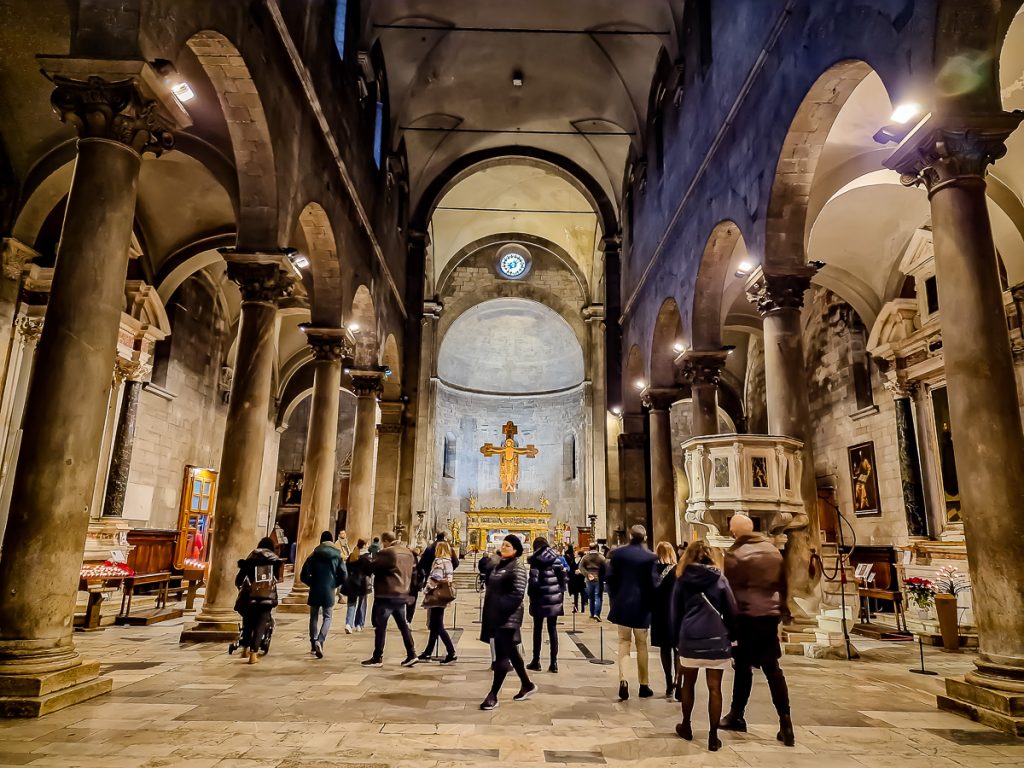
The interior is less attractive – both the guide-book and the guide-person say this. This is because people spent the budget on the outside… But I am convinced that there are also cool stories about certain things inside.
Like, for example, the medieval graffiti on the poles, which I looked for as if choosing my pole for a pole dance….
I found two, but next time I’ll try harder.
Not far from the Church of San Michele is the Puccini Memorial House. I’m not pretending to be cultivated, because I’m not, but at least I should become, I tell myself J. And I’m heading towards the house.
PUCCINI MUSEUM
The famous composer Giacomo Puccini was born right here, in Lucca, in 1858.
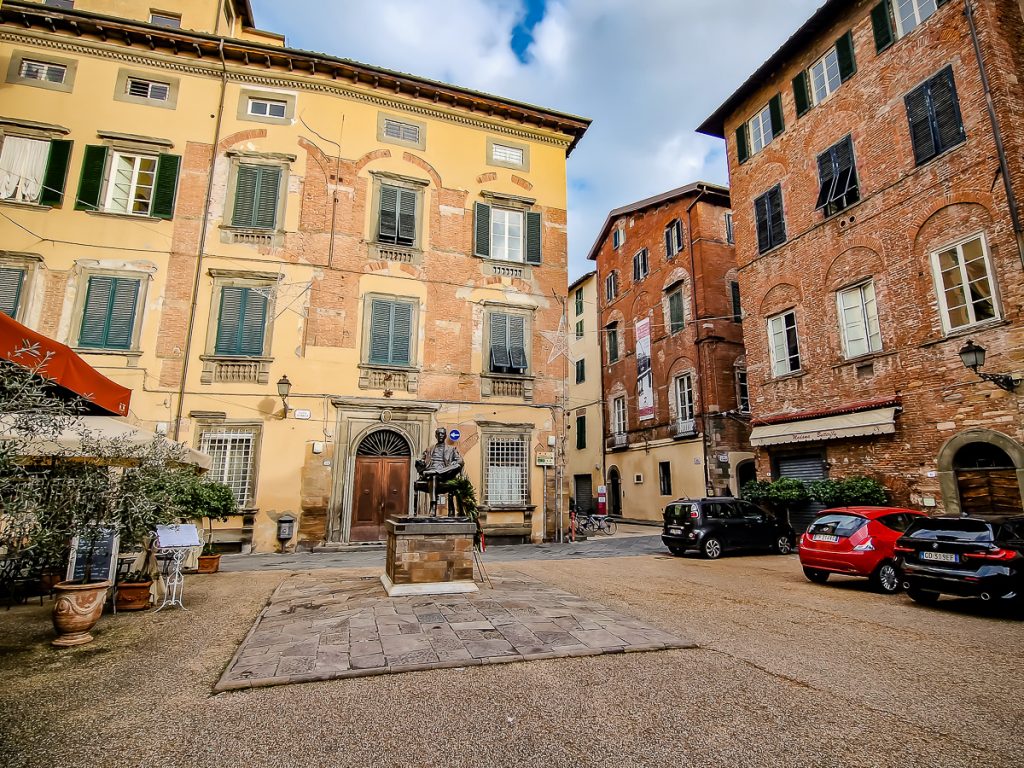
The house is easy to find. The square with the statue of the composer helps me. And as I sit facing the statue, I see a banner on the red building in the corner. That’s the house.
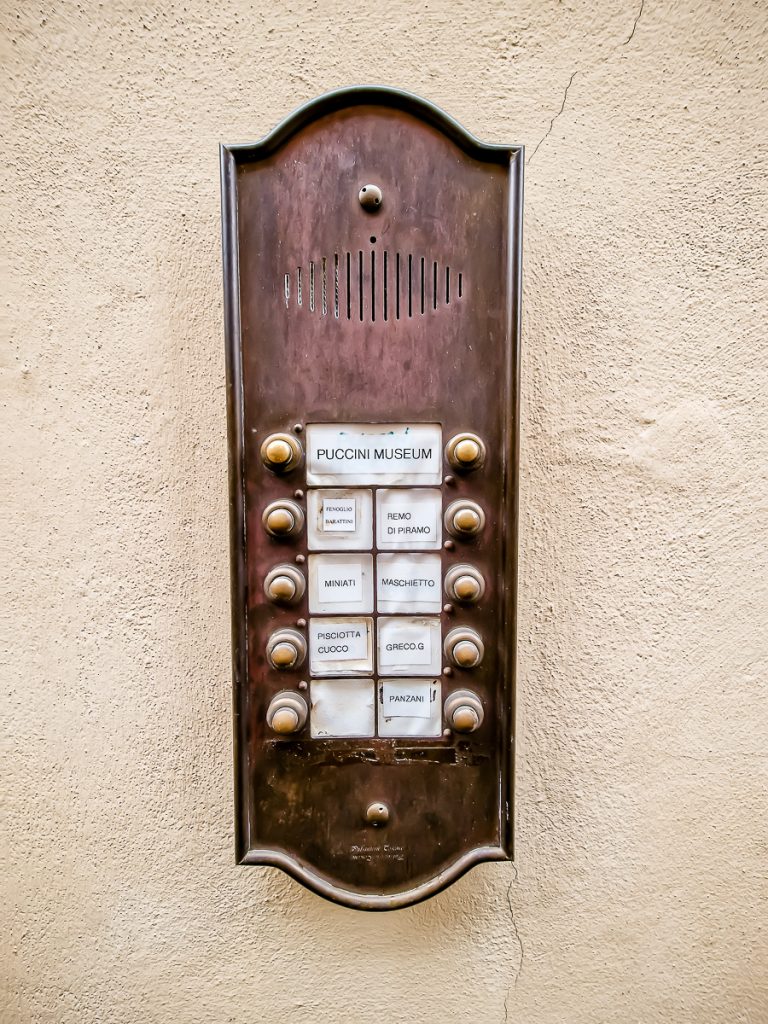
I get to the door and… oops! Although I see Puccini Museum written on the buttons, I admit that I did not press it, as I have never seen such an entrance to a museum.
The door opens and someone comes out with a bicycle. I take the chance and enter.
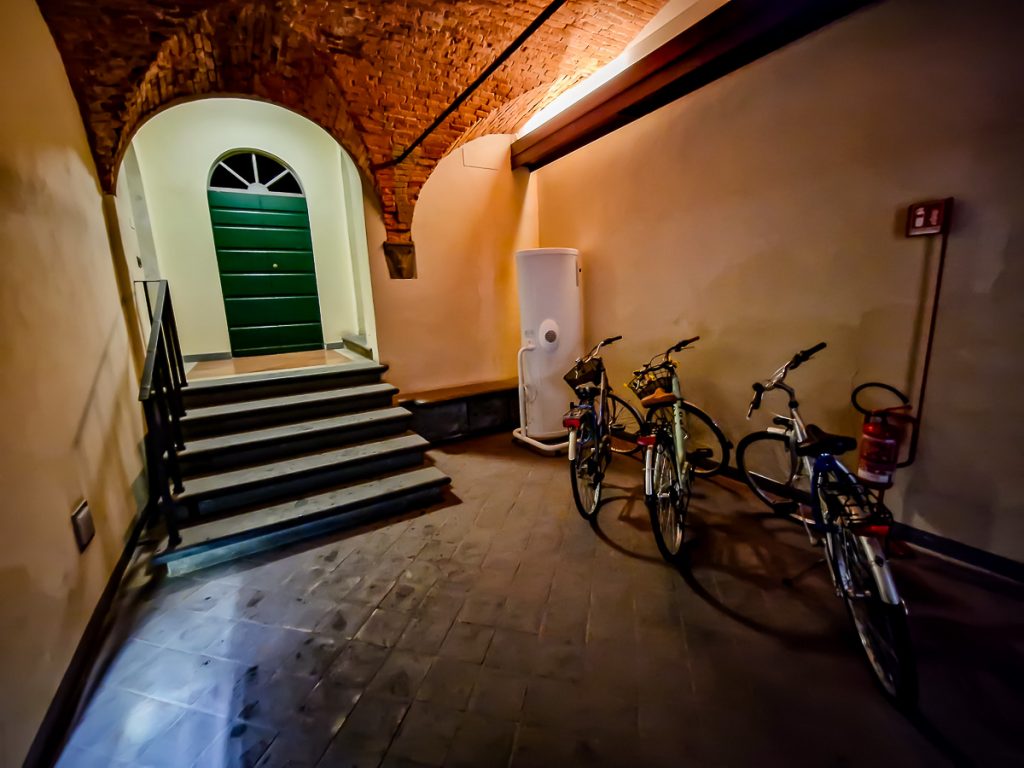
I am practically in a block of flats hall. I entered illegally…
A tenant coming down looks at me as if he was waiting for the postwoman with the pension money and he doesn’t understand why she looks like that… I leave. I discover that the ticket for the memorial house must be bought from the square, from another building. The sellers encourage me to go back to the red house and ring the doorbell.
I’m ringing. “Hello, Mr. Puccini, open the door, I’ve come for a coffee and a song.”
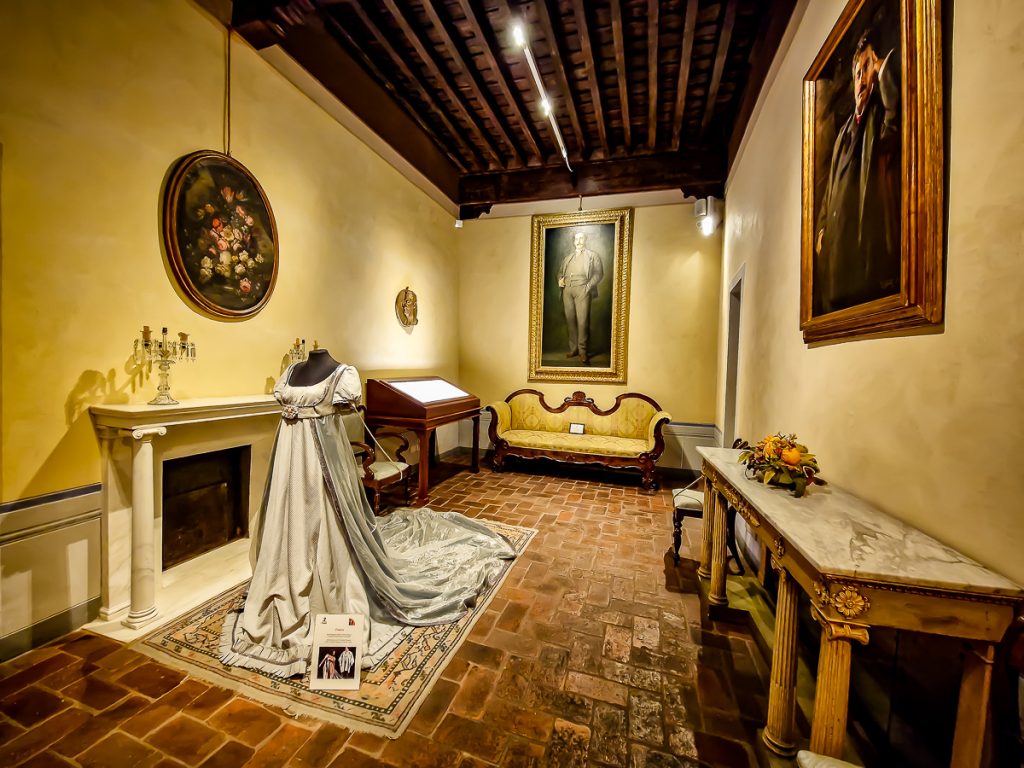
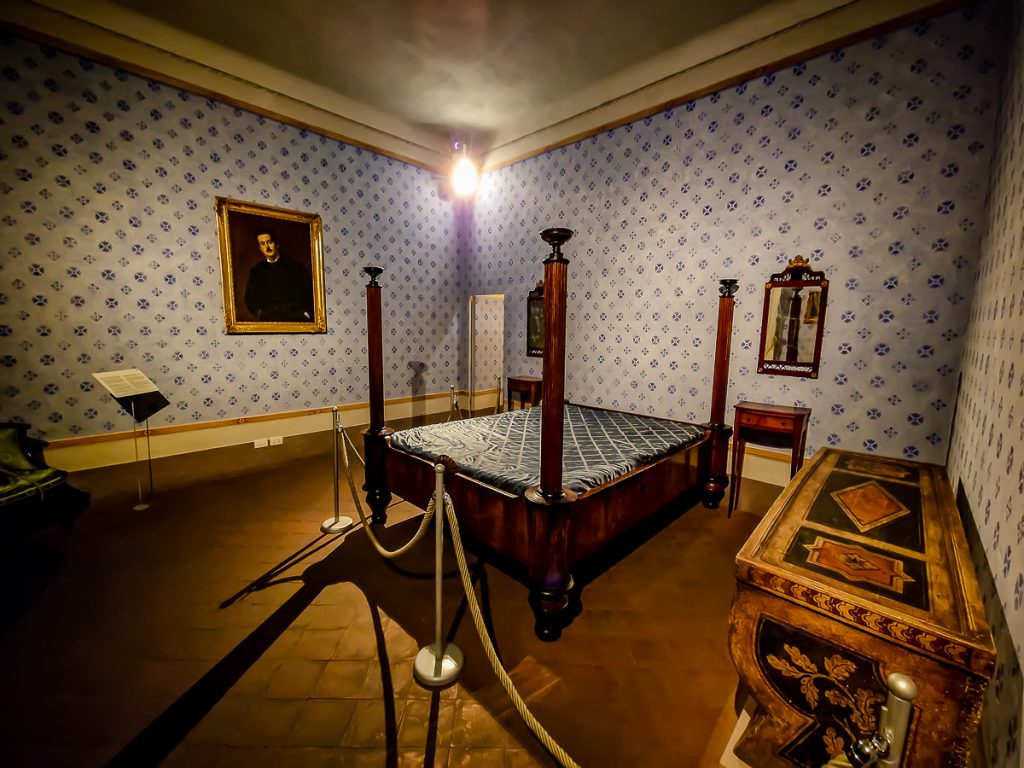
Born in the family bedroom… wait… that’s not what I meant, although it’s true, he was born in this bedroom.
So: born in a family of musicians with a long tradition – 5 generations! – it was unlikely that Giacomo Puccini would stay away from music. As a child, he learned to play the organ and sang in churches. The Super Bowl didn’t exist back then…
Now speaking seriously, the kid sang in churches to help his mother, who was left a widow with 7 children.
When he was 17 years old, he went to Pisa to see a performance of Verdi‘s Aida. Wow! Shock and euphoria!
Puccini was simply blown away and, basically, that was the moment when he decided that this is what he wanted to do: to compose opera music. The family told him he was crazy… but they couldn’t shake it off him.
Giacomo went to Milan to study composition and did that for 3 years.
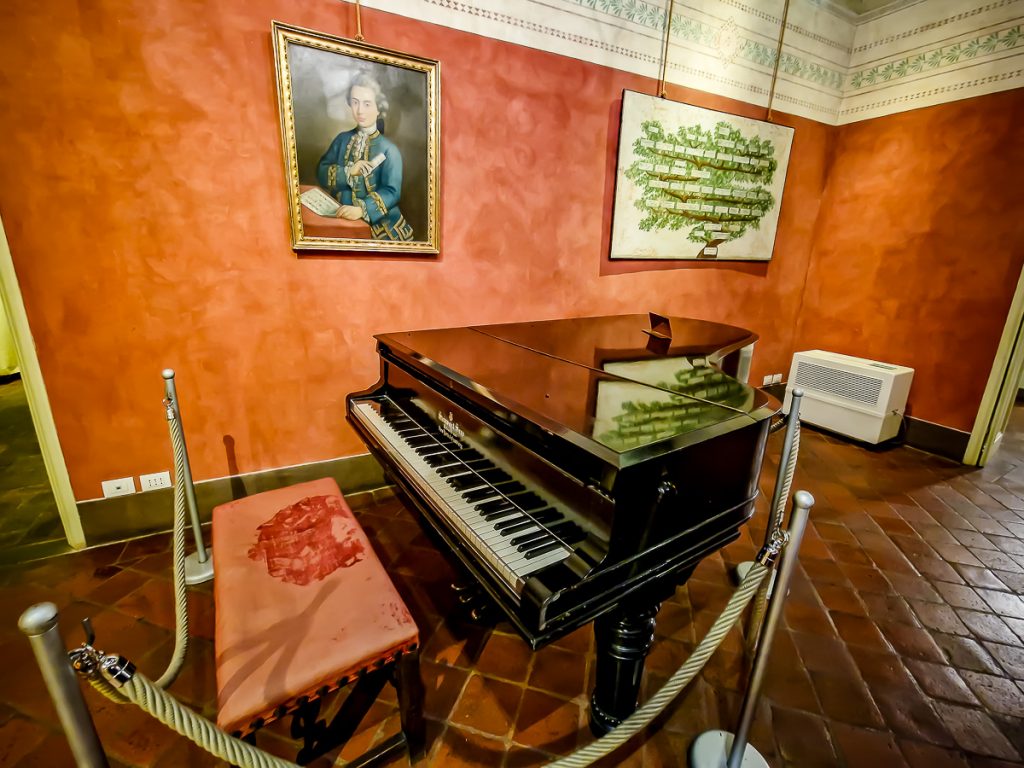
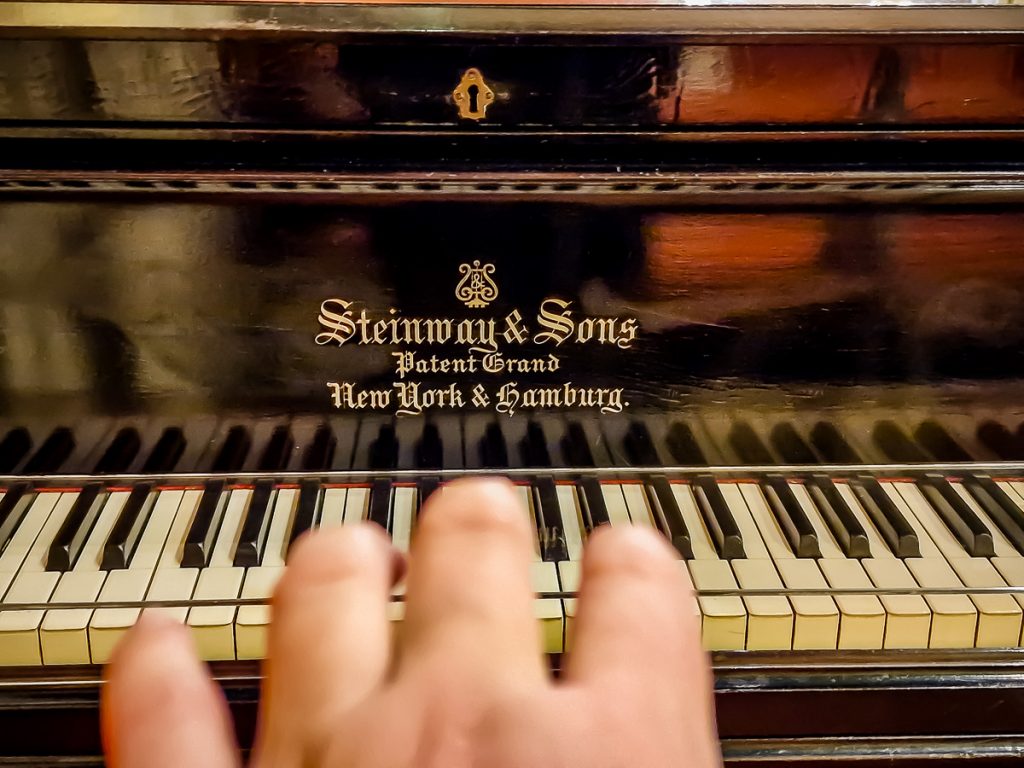
Puccini wrote 12 operas, that’s all. With the third – Manon Lescaut – he met the celebrity. He was 34 years old.
He became very rich and damn lucky, enjoying success (and money) during his life…
I don’t know if the paparazzi of the 19th century ran after the “star” Puccini, but I found out that he didn’t like to sit around as a model at all, when someone painted his portrait. For this reason, they managed to photograph him and thus make his portrait after the photo.
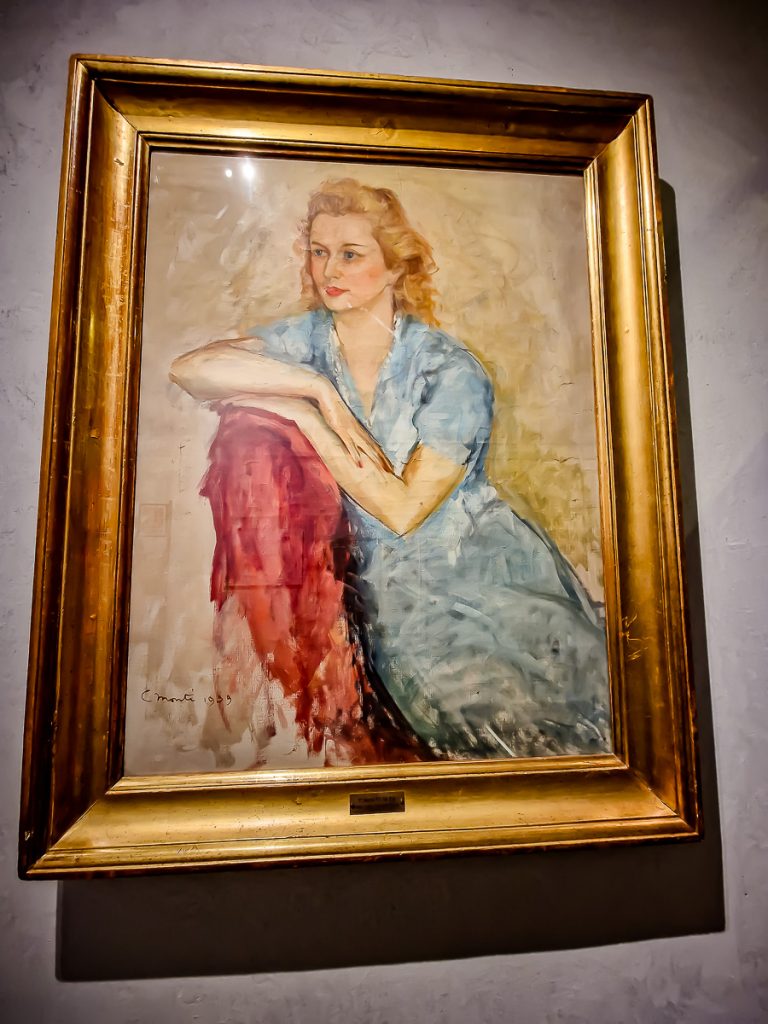
And, speaking of the painting, I admit that I would not have stopped in front of this painting if I had not read about the lady in it.
Rita della Anna was Puccini’s daughter-in-law. We owe her this memorial house! A few years after the death of her husband (Puccini’s son), she donated the house, along with many documents and pieces of furniture, with the aim of being transformed into a museum. It happened in 1974.
Whether you are passionate about opera or not, this house is worth visiting, for everything exposed in it and for the atmosphere.
I, a novice, spent half an hour in front of a single museum piece: an absolutely fabulous costume!
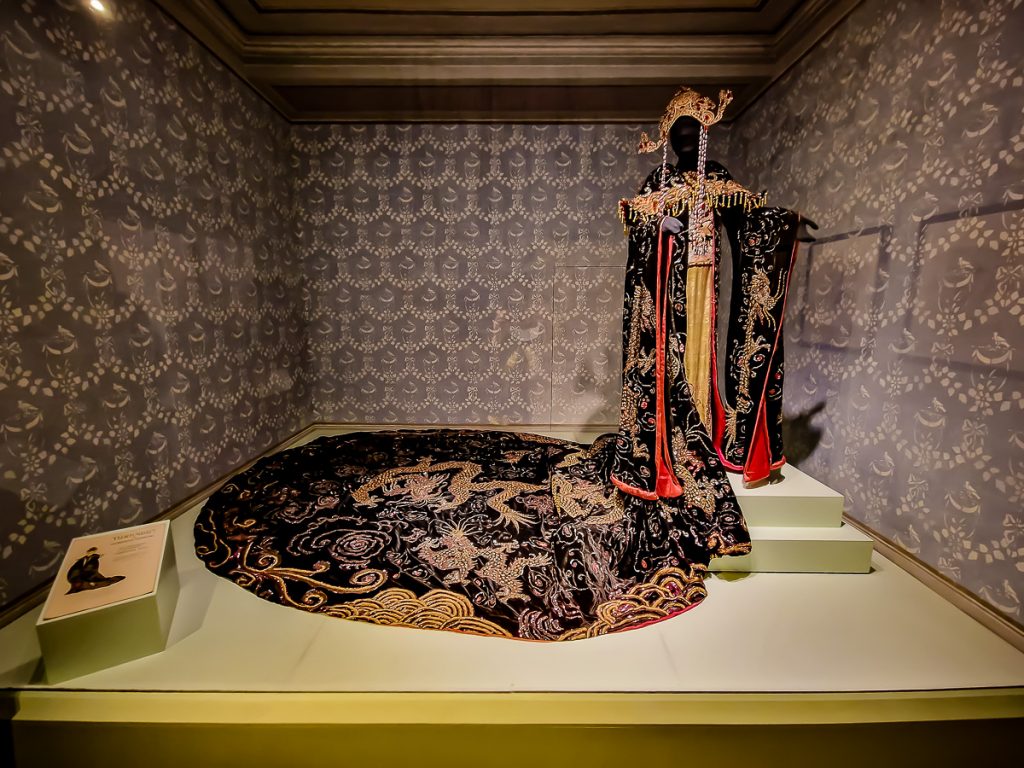
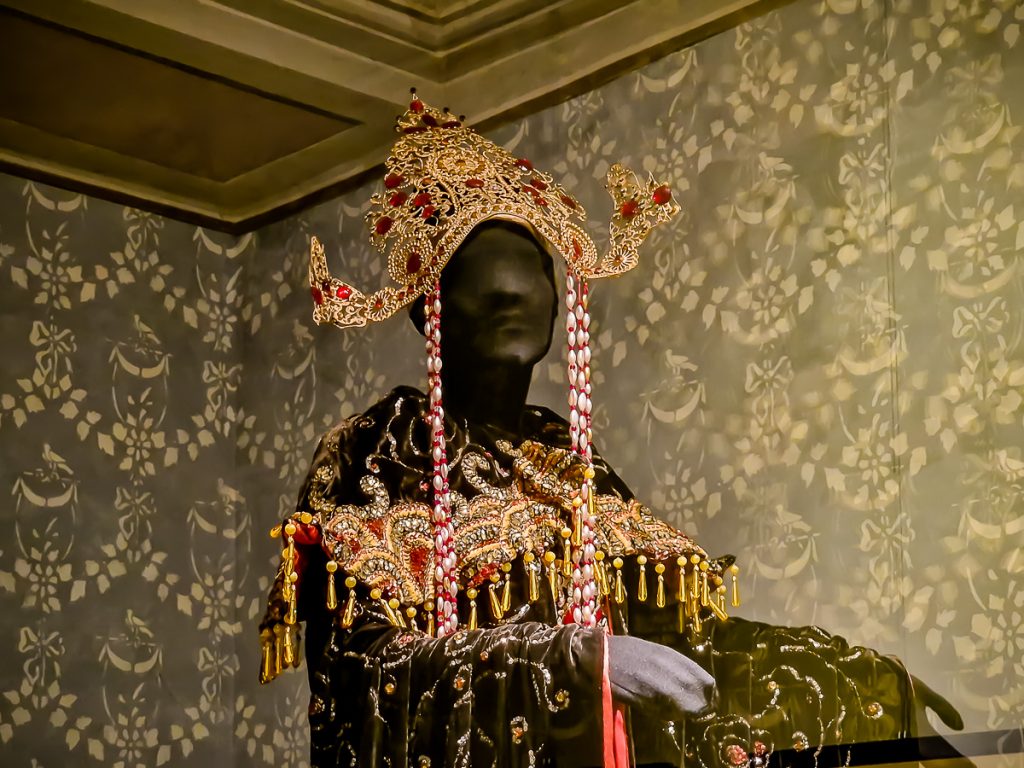
It is the costume used in Act 2 of Turandot – Puccini’s unfinished work – in the first performance at the Metropolitan Opera House in New York.
The details are… absolutely jaw-droppingly! I couldn’t take my eyes off the window. Standing nailed here, I promised myself that I would go see an opera by Puccini as soon as possible. Either one!
The guide I had on the walk in Lucca told us that there was a Top of the most performed operas in the world. It looks like this:
- Verdi – Traviata
- Mozart – The Magic Flute
- Bizet – Carmen
- Puccini – La Bohème
- Puccini again – Tosca
- and again Puccini – Madame Butterfly
Cool, right?!?
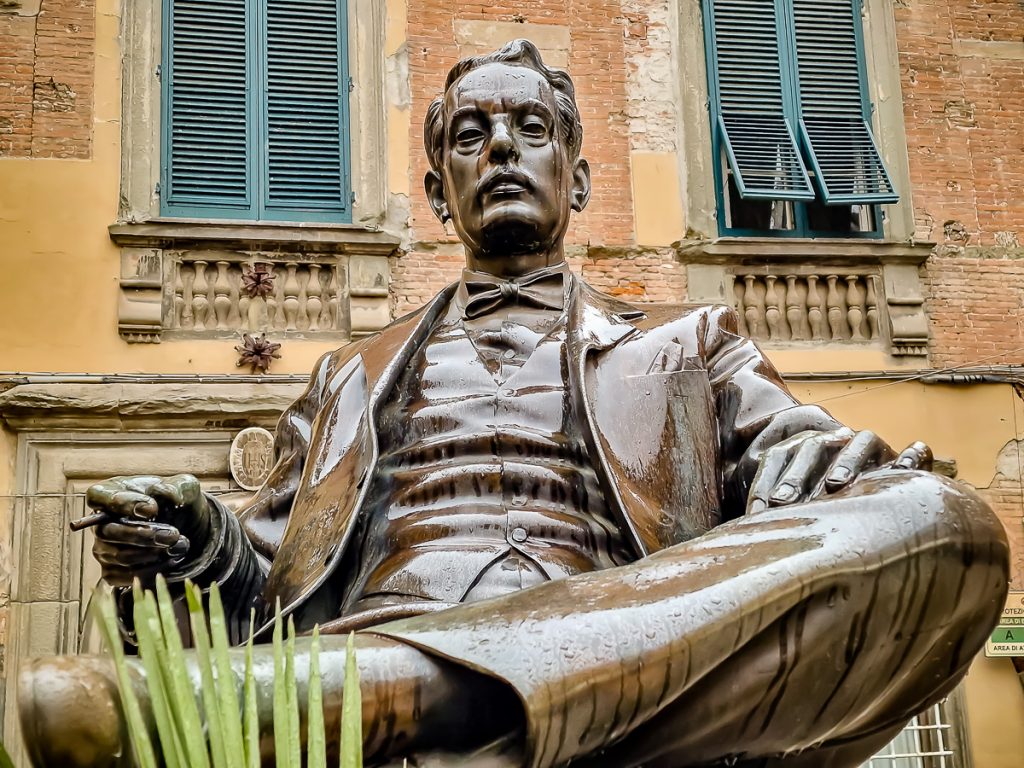
Did you know that Puccini died of cancer?? I had no idea. Cancer of the larynx. He smoked over 60 cigarettes a day, man!!!
Even the statue shows Puccini with a cigarette in his hand…
He was almost 66 years old when he died.
VIA FILLUNGO
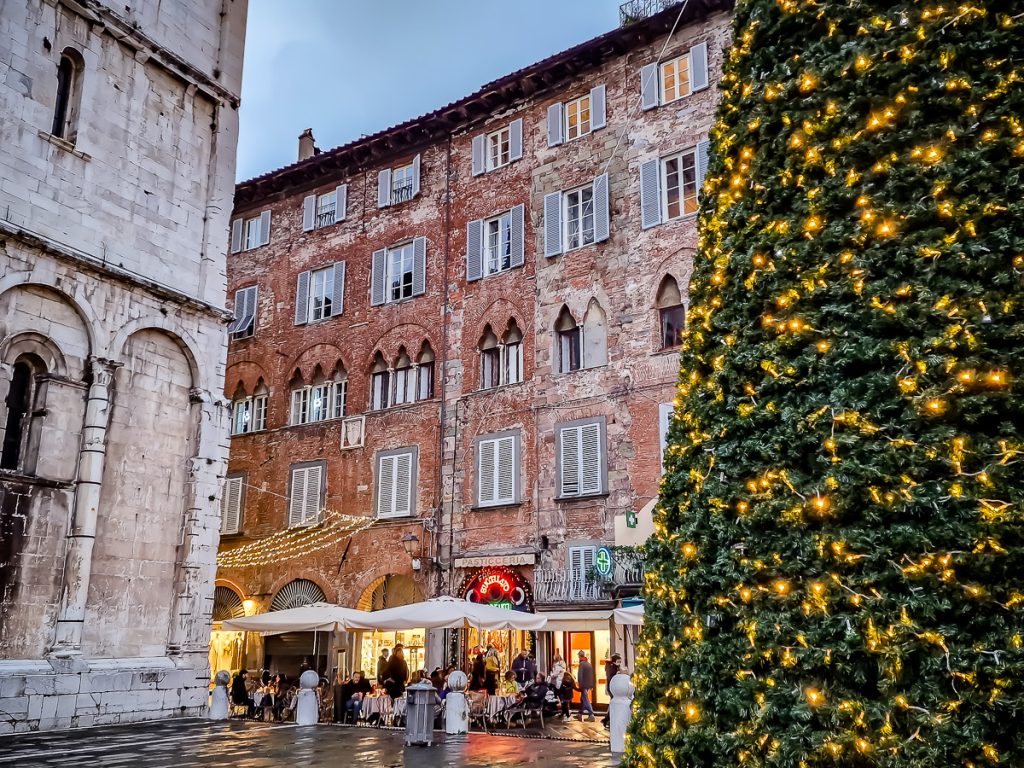
I return to Piazza San Michele and take Via Fillungo, a narrow and looong street that cuts through the city. Unbelievable, but it’s been like that since the times of the Romans, when it connected the north with the south!
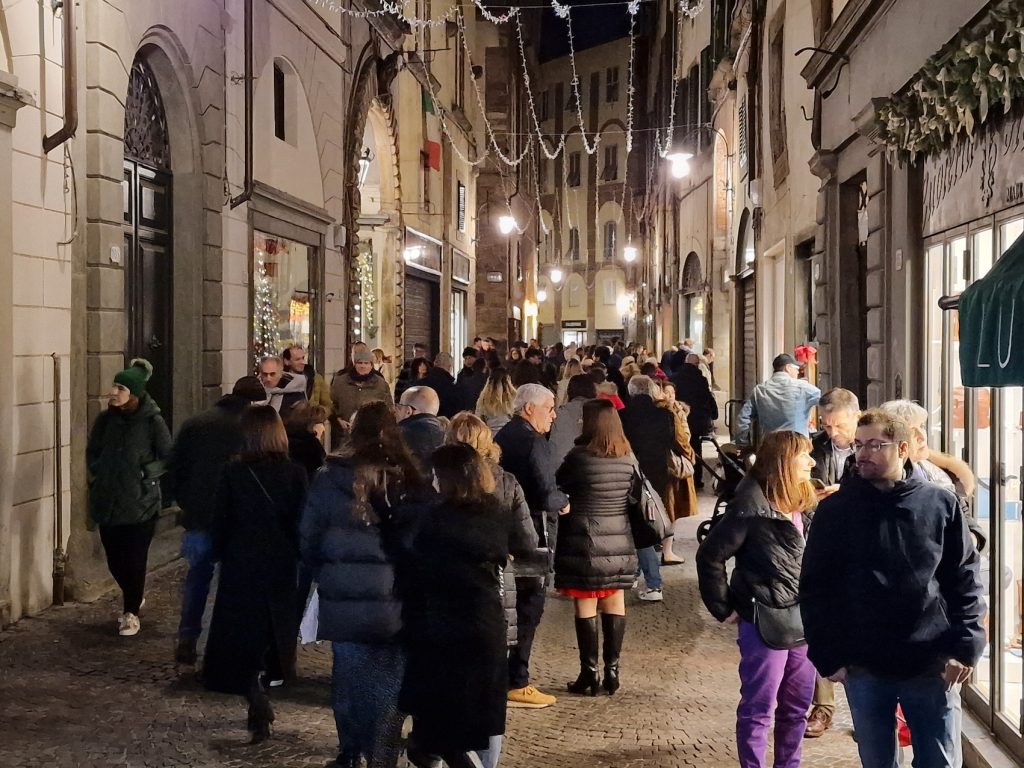
Today I enjoy the hustle and bustle here, I pass by beautiful buildings, towers, I see shop windows, many people in cafes or ice cream parlors, but for now I don’t stop, because I want to reach a unique square, located near the end of this long street.
PIAZZA DELL’ANFITEATRO
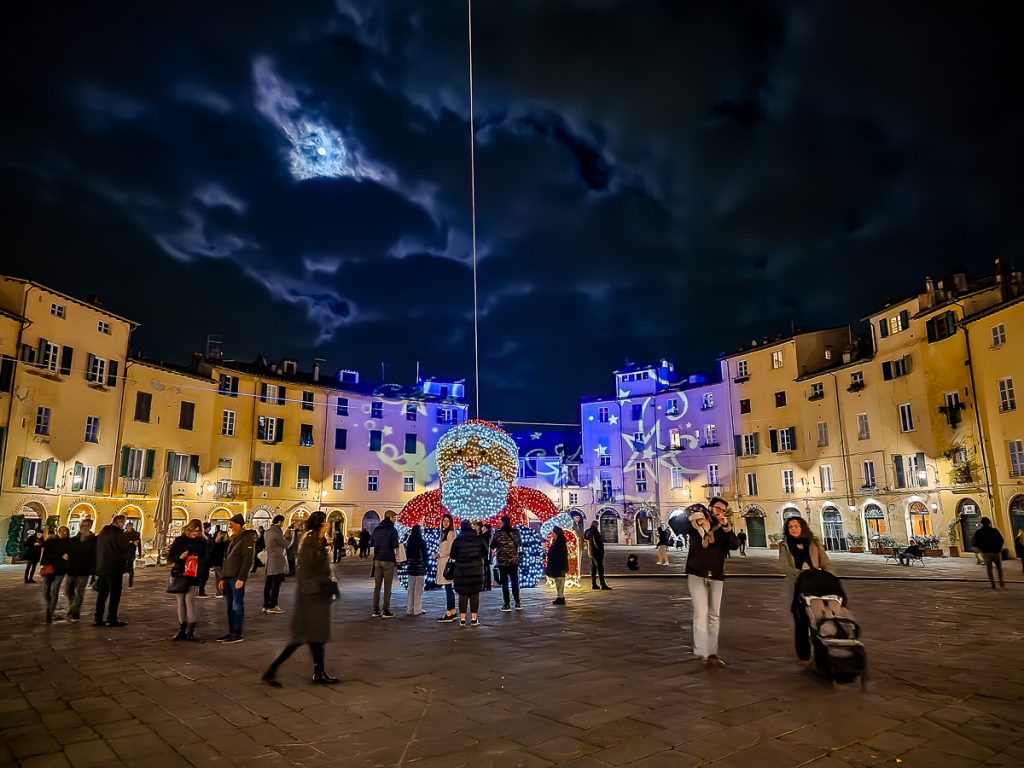
This square owes its name to the old Roman amphitheater located in the oval perimeter on which there are now some medieval houses.
The amphitheater had been built outside the Roman forum, more on the outskirts, because there was no room for such a thing inside. It had two levels, and people came with great enthusiasm to witness the gladiator fights.
The capacity of the amphitheater was of 10,000 people. (As an idea: the Colosseum in Rome had a capacity of 50,000 people, and the Arena in Verona – 25,000 people)
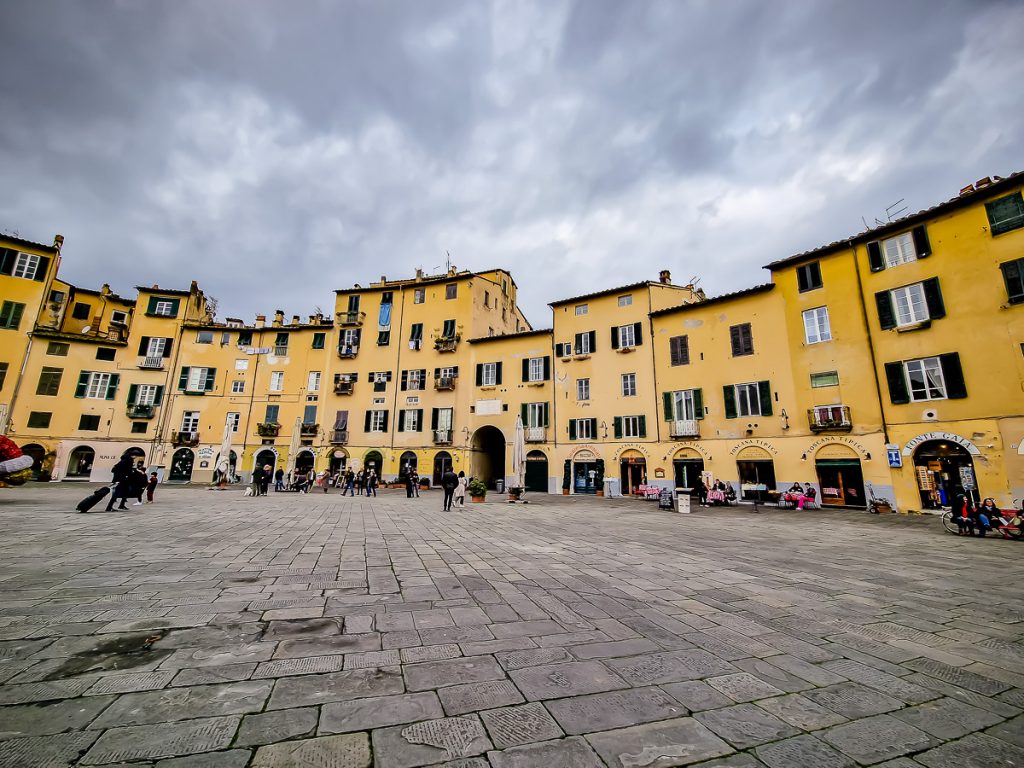
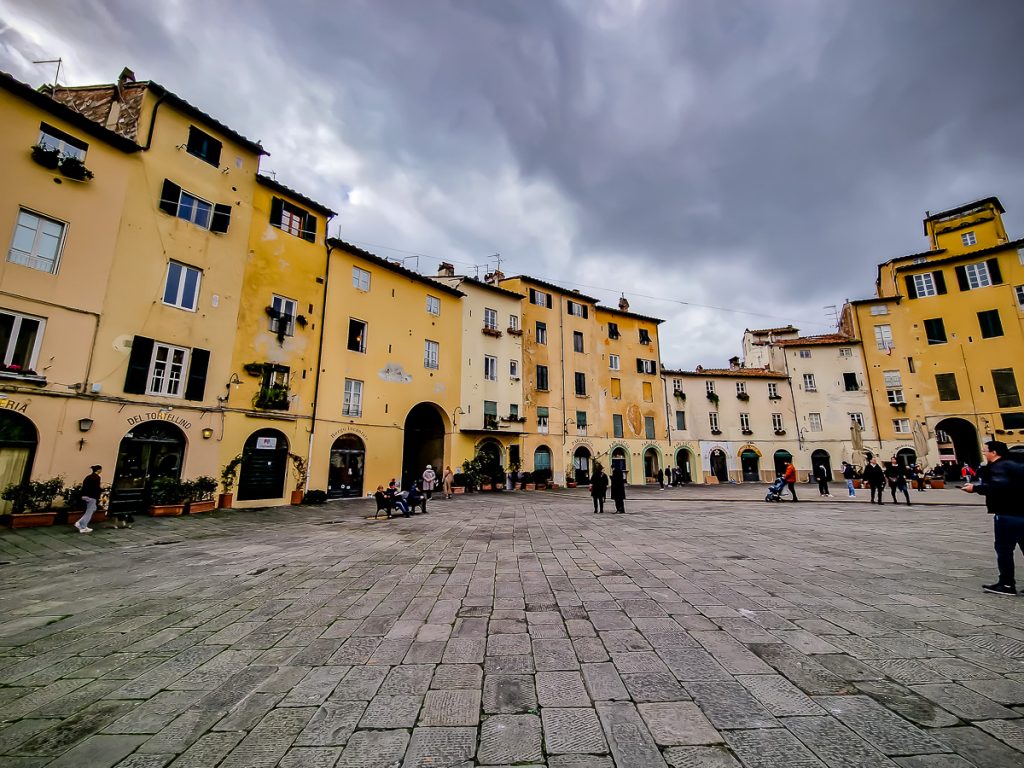
After the fall of the Roman Empire, apart from “let’s steal the stones from the amphitheater to build our houses”, some people built their houses right in the amphitheater.
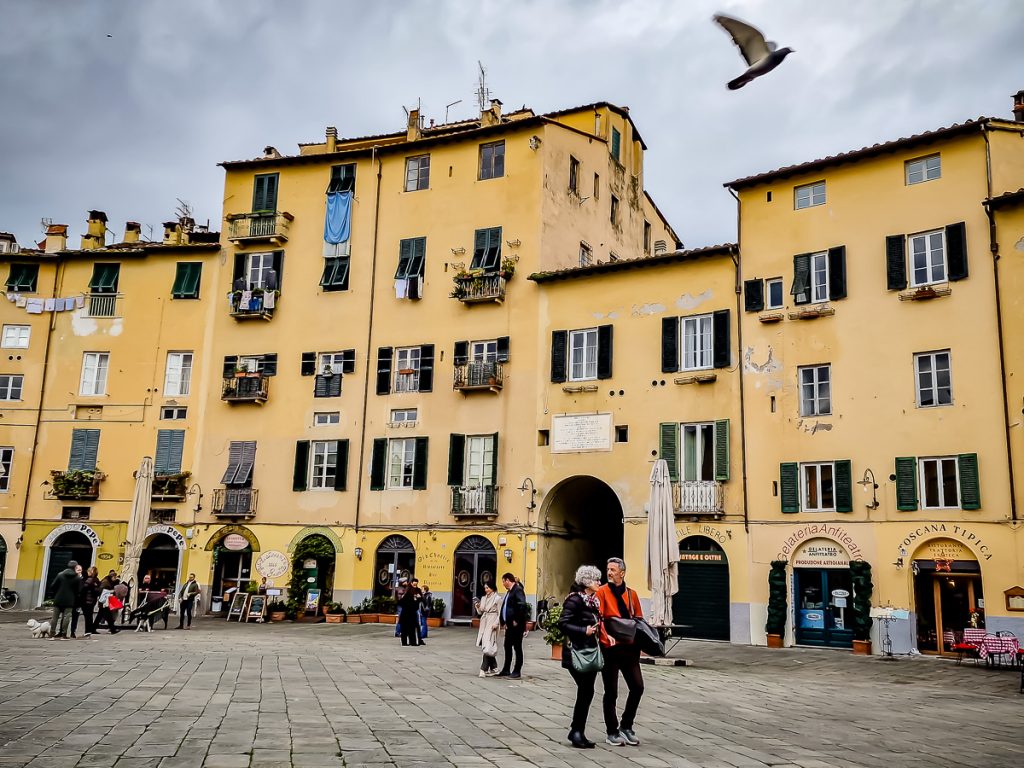
Over the years, everyone built something on any empty space, so that, if you look carefully, you can see that the buildings pileup, room after room, without unity in several places.
The guide tells us that, until you enter an apartment in this square, you don’t know what’s inside, just by judging from the outside.
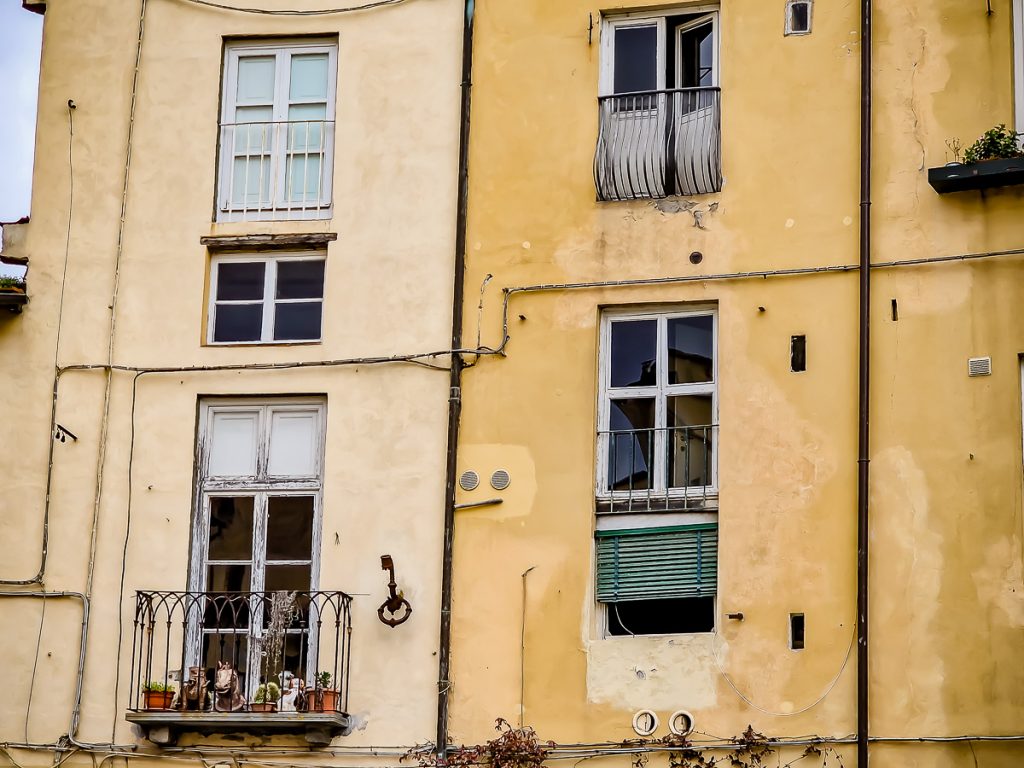
In the upper left, you don’t know if the square window is that of a new room, if someone has divided the apartment horizontally. The same with the window with the green blinds.
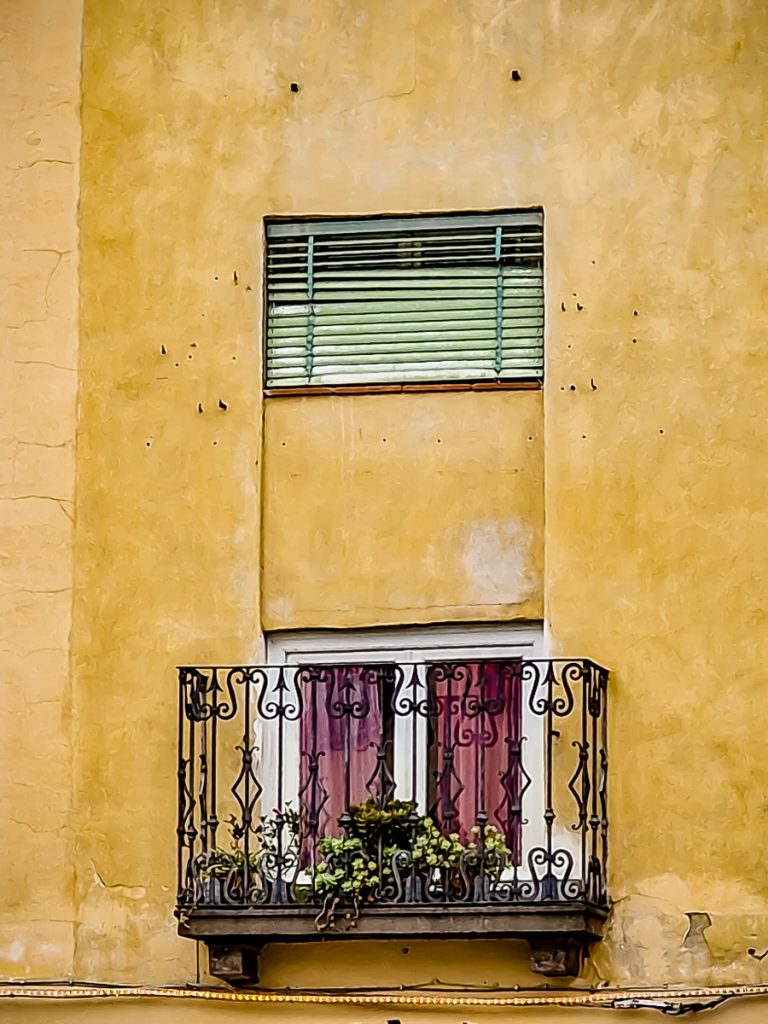
Here, the same dilemma: someone divided a tall room into two lower ones??… Maybe even two apartments with different owners??…
Around 1800, an architect began to clean the place, demolished the buildings inside the amphitheater, cleaned up the vegetable gardens and everything else people had done, depending on their needs…
You won’t believe it, but not long ago, more precisely in 1980, this square was a mess. Poverty was rampant, no one wanted to live here. Only at the end of the 90s did it get its current look, and now I think it’s a luxury to buy something in Piazza dell’Anfiteatro!
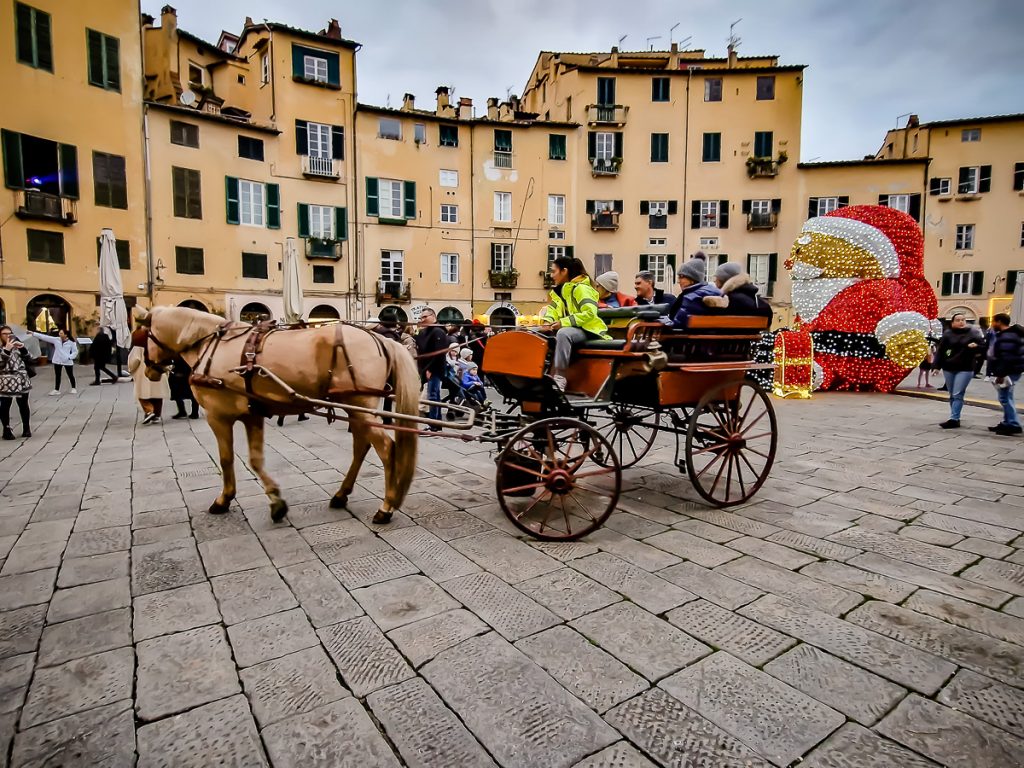
The wall leaves a lot to be desired in places, but not necessarily due to the negligence of the tenants. I understand that the authorities are careful to make people paint, but, being a wet area, the plaster wears off over time. So they preferred to invest in interiors.
Of the 4 entrances to Piazza dell’Anfiteatro, only one is original. I photographed it both from the outside and from the inside.
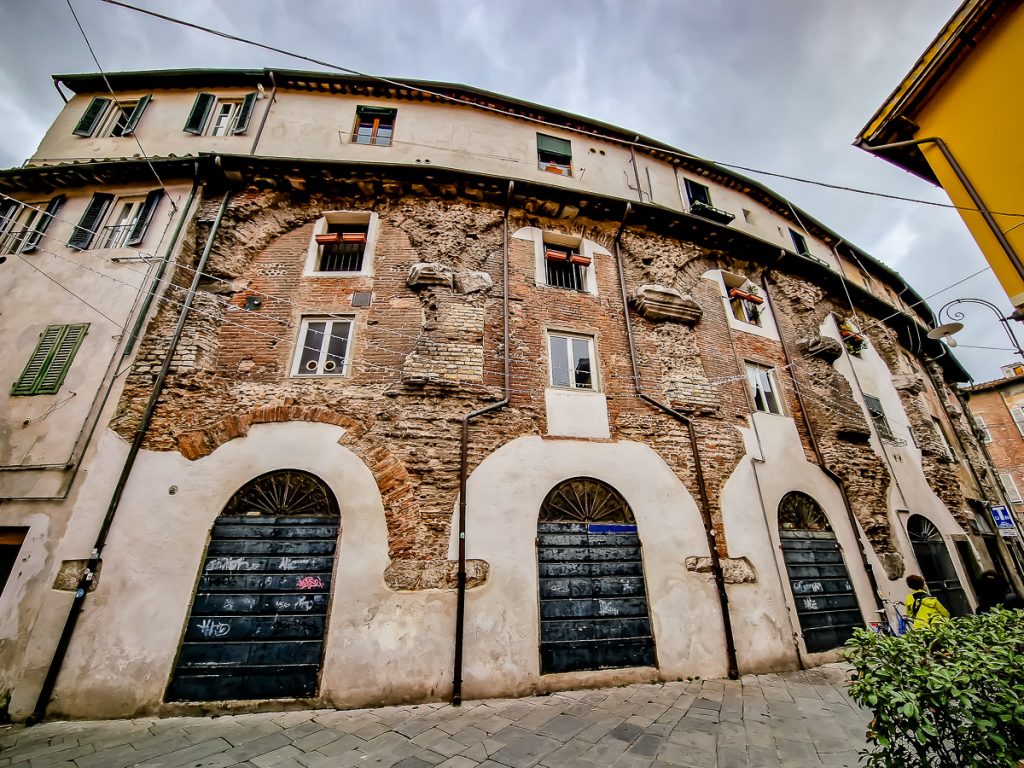
And, you may not believe it, but some stones in the current wall of the amphitheater are from the time of the Romans! They are 2,000 years old, bro!!!
They can be seen very well from the outside, on the part captured in the picture.
BASILICA OF SAN FREDIANO
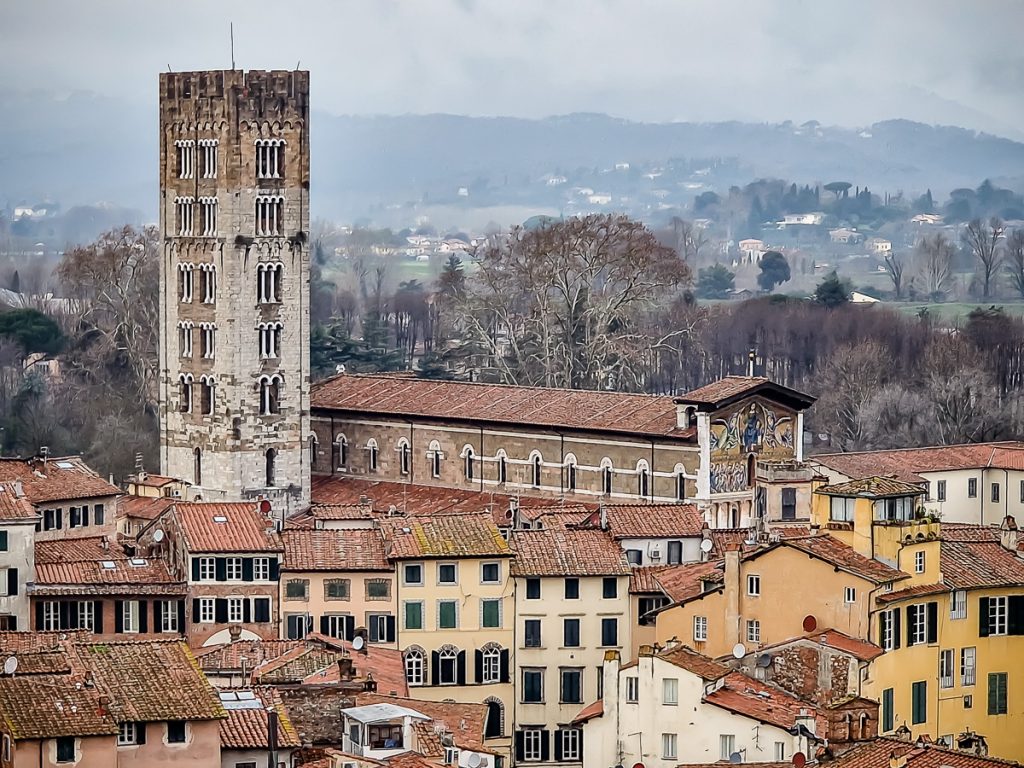
Very, very close to the Amphitheater Square is the Church of San Frediano, which catches your eye first of all because of the large mosaic on the facade, a mosaic dating from the 12th century!
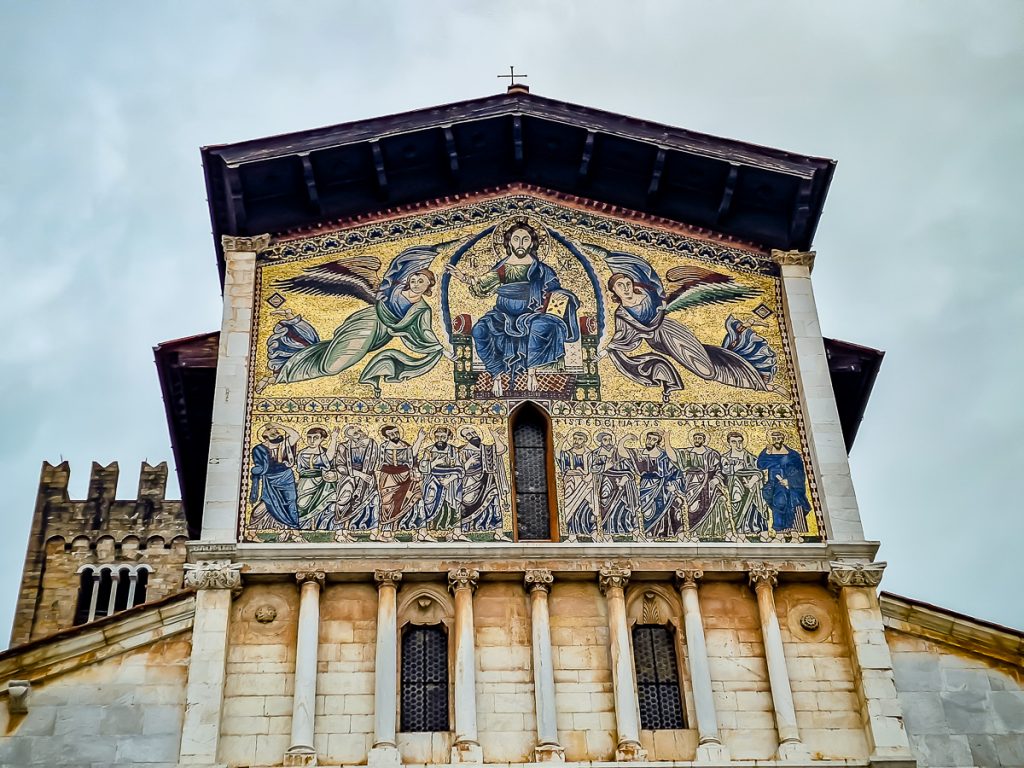
They say this is the church that the inhabitants of Lucca love the most! Weddings, events, etc. are held here. But you didn’t forget, right? The most important remains the Cathedral (Dome).
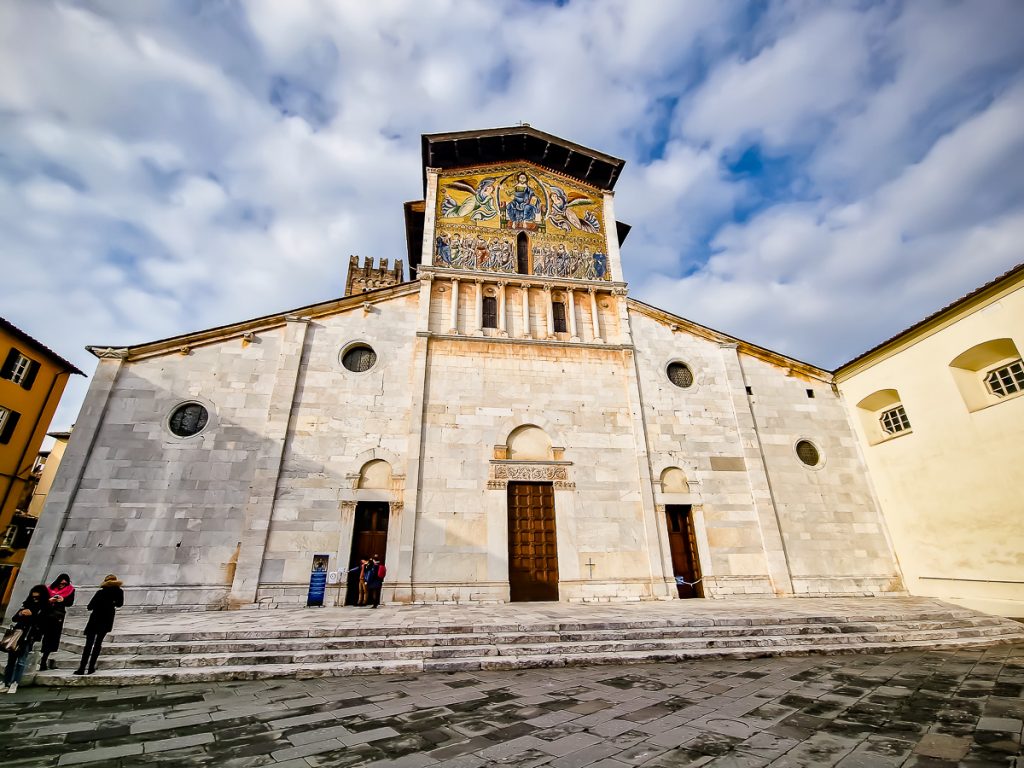
I could have sworn that the facade is made of marble (it blinds you when it’s sunny outside), but no, what do you know, it’s made of limestone.
I pay 3 euros and enter.
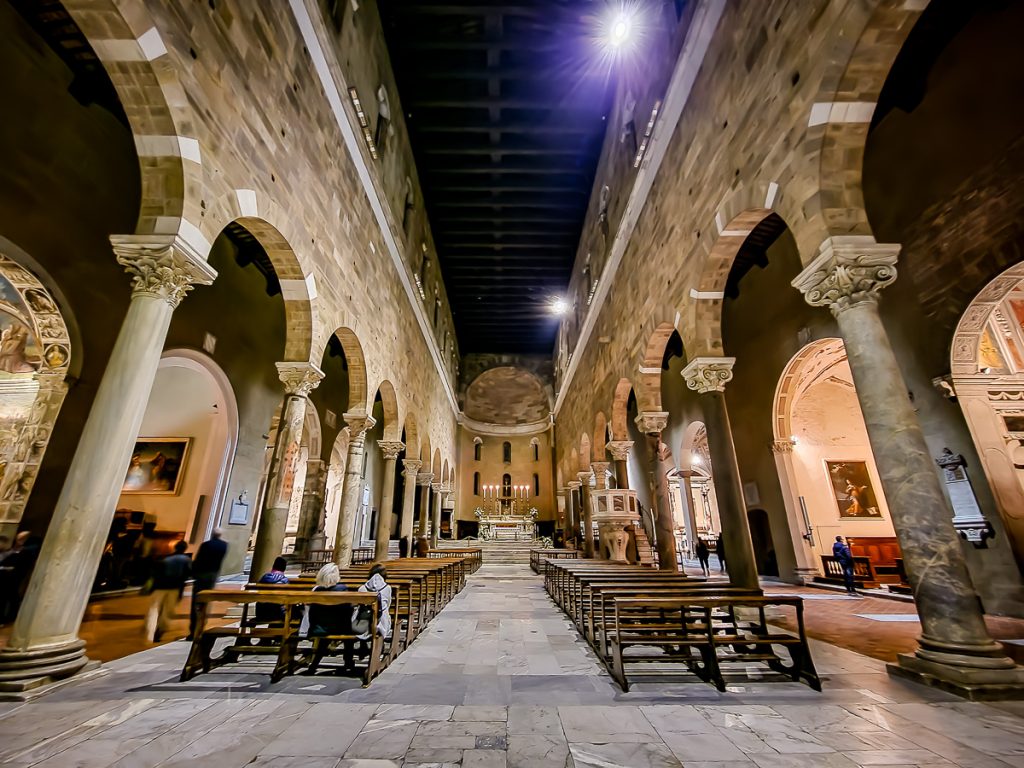
I walk through it freely, without knowing much, I look at the noble chapels, sculptures, decorations.
The place is also important because the mummified body of Saint Zita is kept here– something very important for the Lucca people.
Having humble origins, Zita was a small servant in the house of some rich people. She was hardworking and kind. She often took the leftover pieces of bread to the poor. Until, one day, being accused of theft by the owner of the house, she said that she was not hiding bread in her apron, but… flowers. And so it was: by a miracle, the bread was transformed into flowers and she came out clean.
Saint Zita is the patron saint of maids and domestic servants and is worshiped annually on April 27, when the whole area is filled with flowers and plants!
THE TOWERS OF LUCCA
The medieval period is the one in which several Italian cities became a kind of Manhattan – medieval skyscrapers appeared like mushrooms after the rain, because the rich of the time wanted as many as possible, as high as possible…
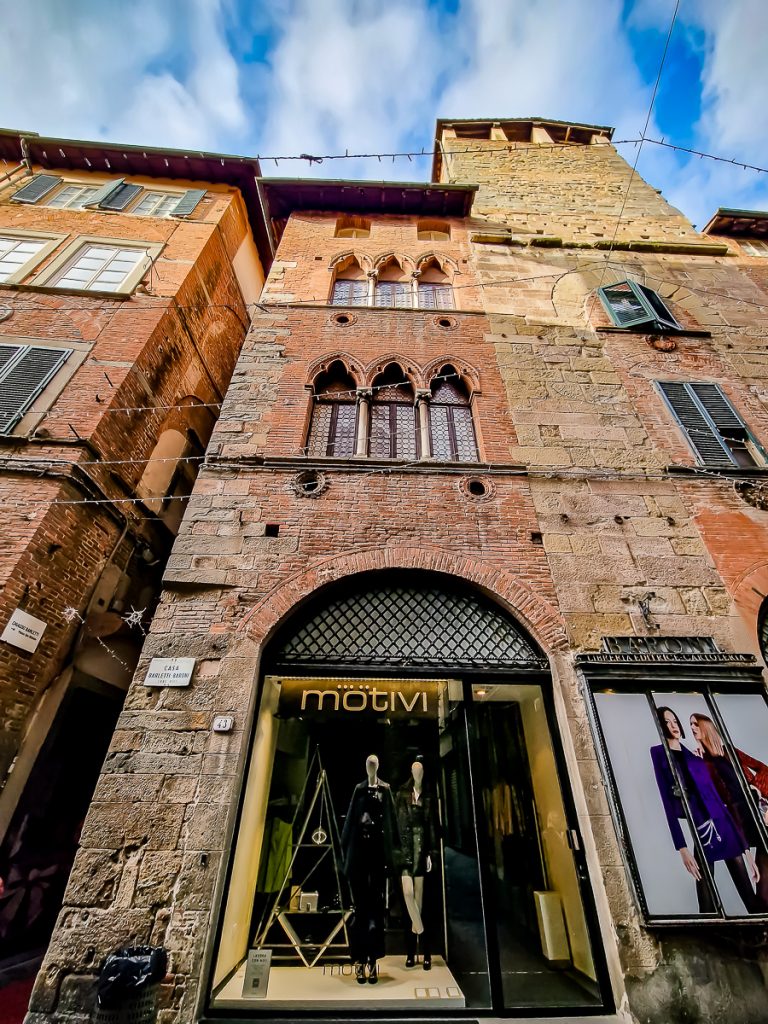
In a tower, the workshop/store/warehouse was always on the ground floor, the living rooms were above, and the kitchen was on the top floor. Why? For a practical reason: if it caught fire, at least it only burned at the top, it didn’t destroy the whole tower.
In Lucca, there are not many towers from the medieval period left standing. Most were demolished in the Renaissance years. What was not cut from the root was included in the new „palazzo”, like this one, for example:
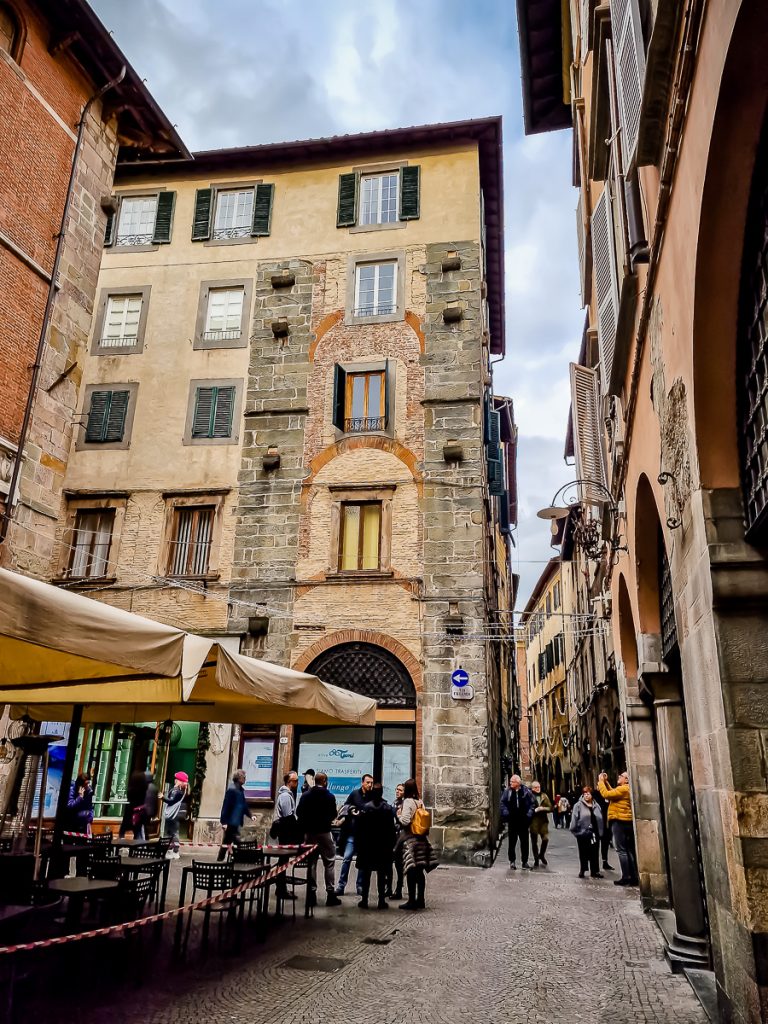
TORRE DELLE ORE
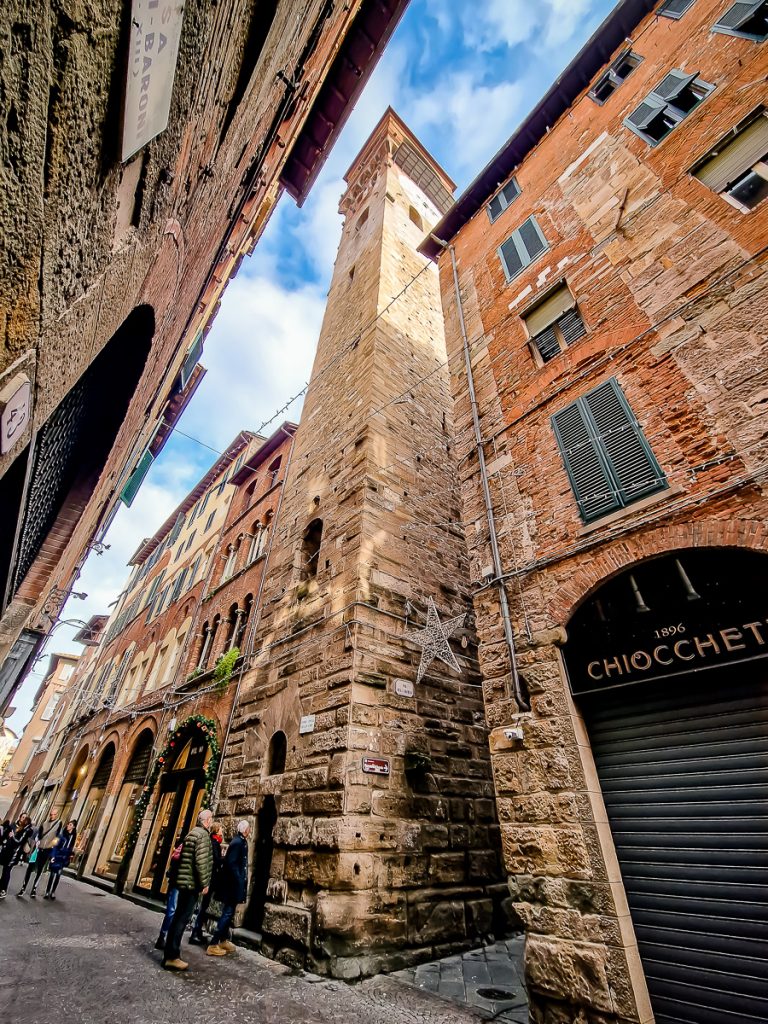
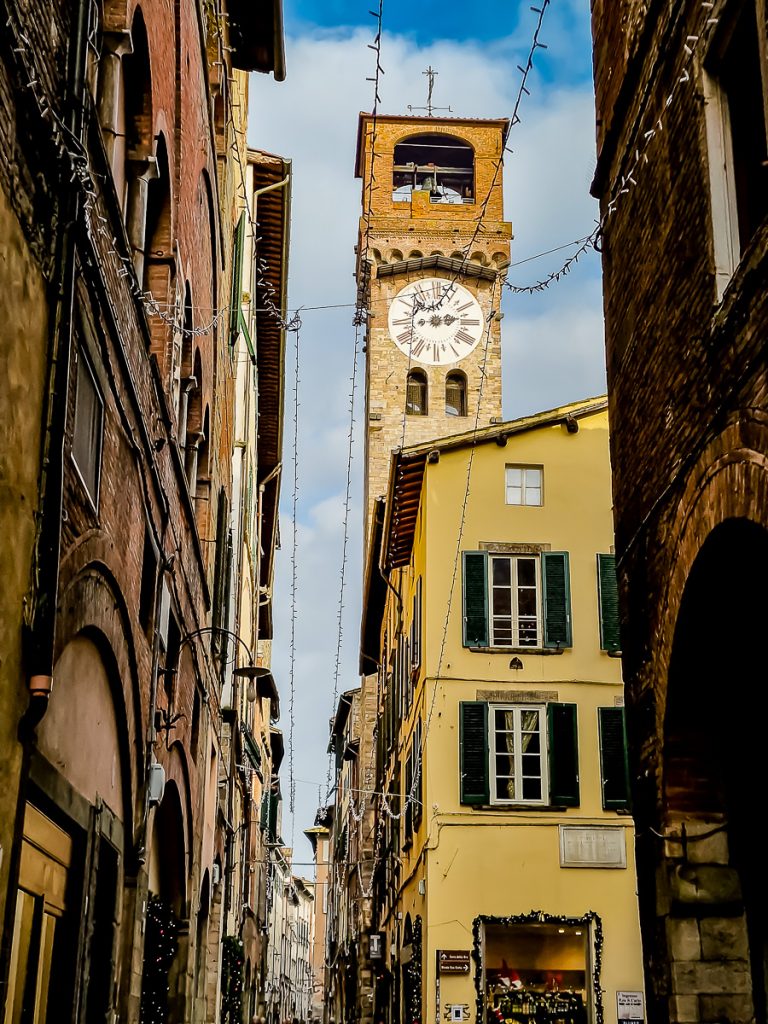
Right on Via Fillungo, proudly stands the Clock Tower, which has been telling the time since 1390!
You can climb into it (5 euros), but it is not recommended for claustrophobes. I didn’t go up, not because I’m claustrophobic, but because I decided not to die on the steps of a tower at the beginning of the year. It’s just that, dammit, what I thought was not what I got…
GUINIGI TOWER
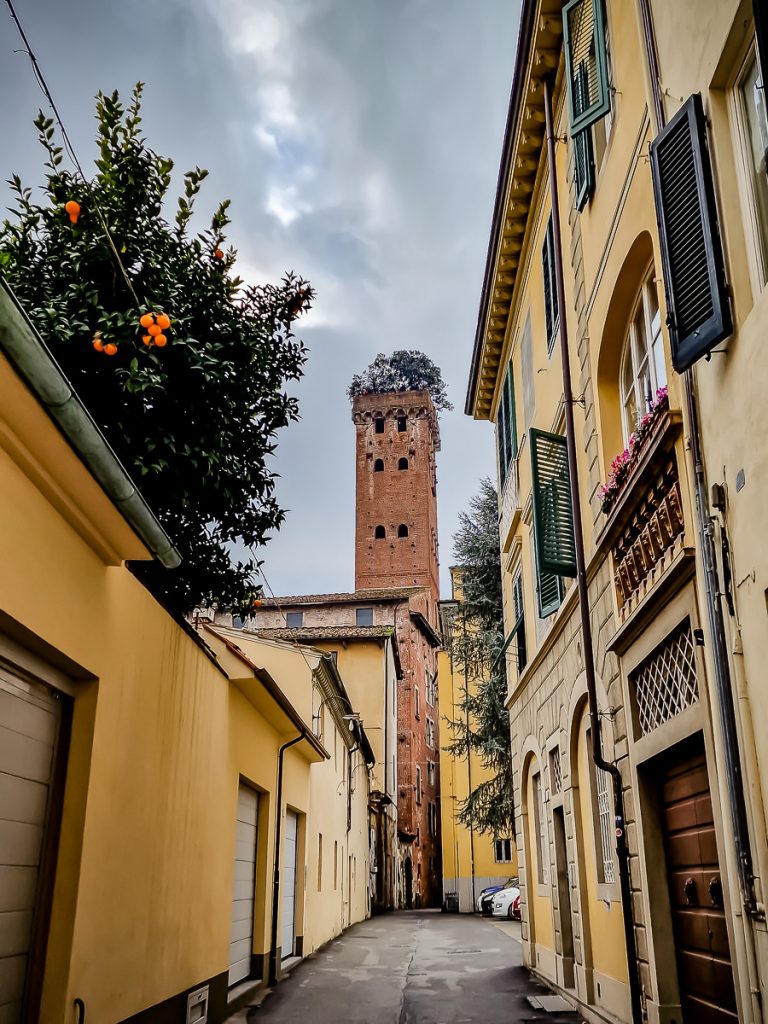
As I was sleepily walking on January 1st, I came across the Guinigi Tower – one of the few towers left standing today, a symbol of the city of Lucca, the pride of the inhabitants and already a magnet on many refrigerators.
If most towers were made to be lived in, it seems that this one was made out of arrogance, to show that the owners are rich and special. And with ideas!…
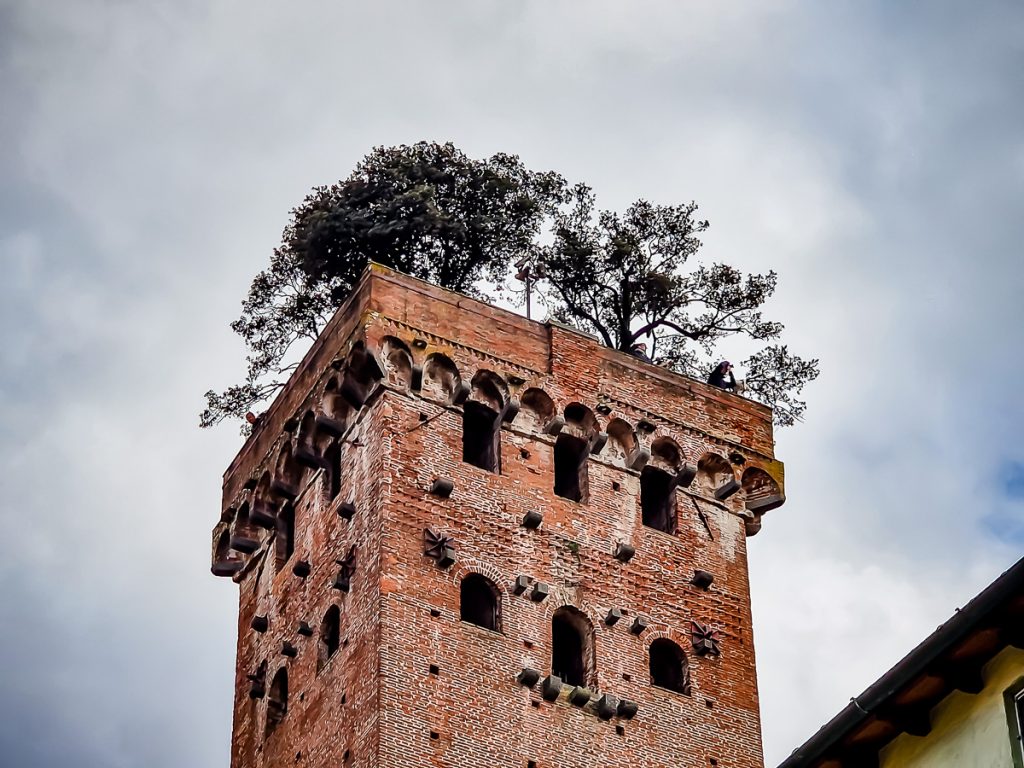
Mr. Guinigi, whom I mentioned above, built this tower around 1300, to be more special than the others: on its top, at a height of 45 meters, he planted some trees! Yes, yes, that’s right!
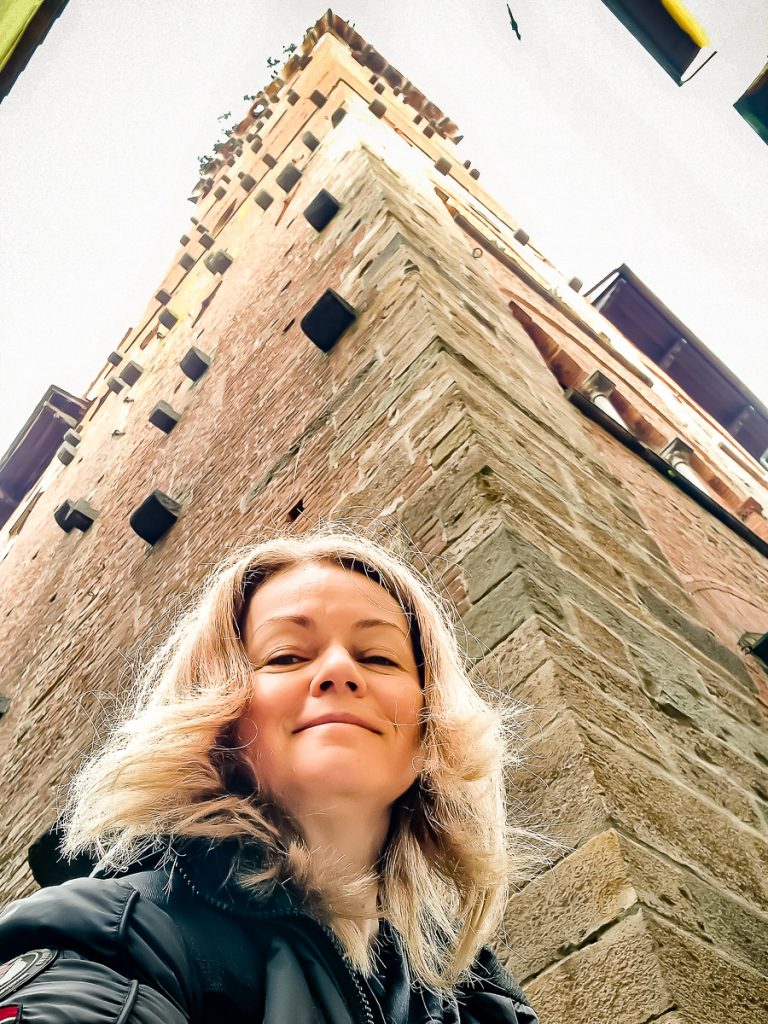
Although it’s January 1, I see the door at the entrance to the tower open. Well, I say start the new year on a high note, right? So I buy my ticket (5 euros) and… start on the narrow stairs.
I asked from the beginning how many steps there were to climb, to prepare myself mentally. When I heard that there are 230, I said that I will easily „solve” them.
They solved me…
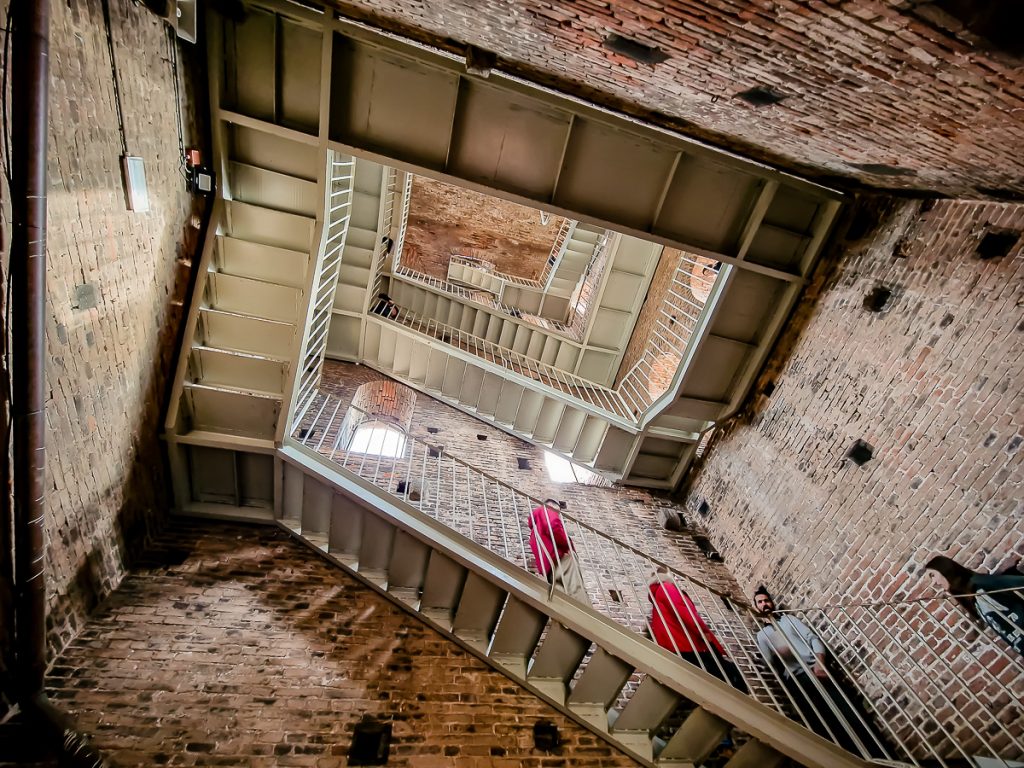
Just when I thought I had arrived, other dozens of steps appeared!
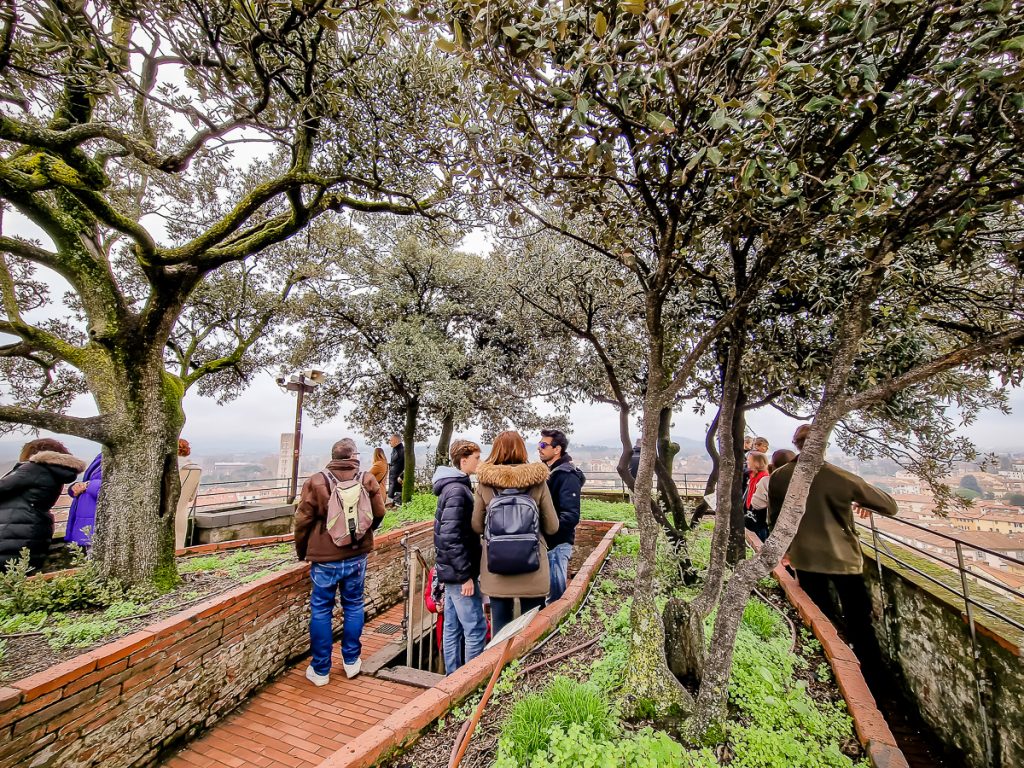
Up high, you have very little room to move, especially if you intersect with other people. You go out on a small terrace, among the trees and, if someone stops to take a picture or show his girlfriend a building in the city, you also have to stop and do something.
The view over the city is wonderful! It enchanted my eyes. I took a series of selfies as soon as I found a free space between two people…
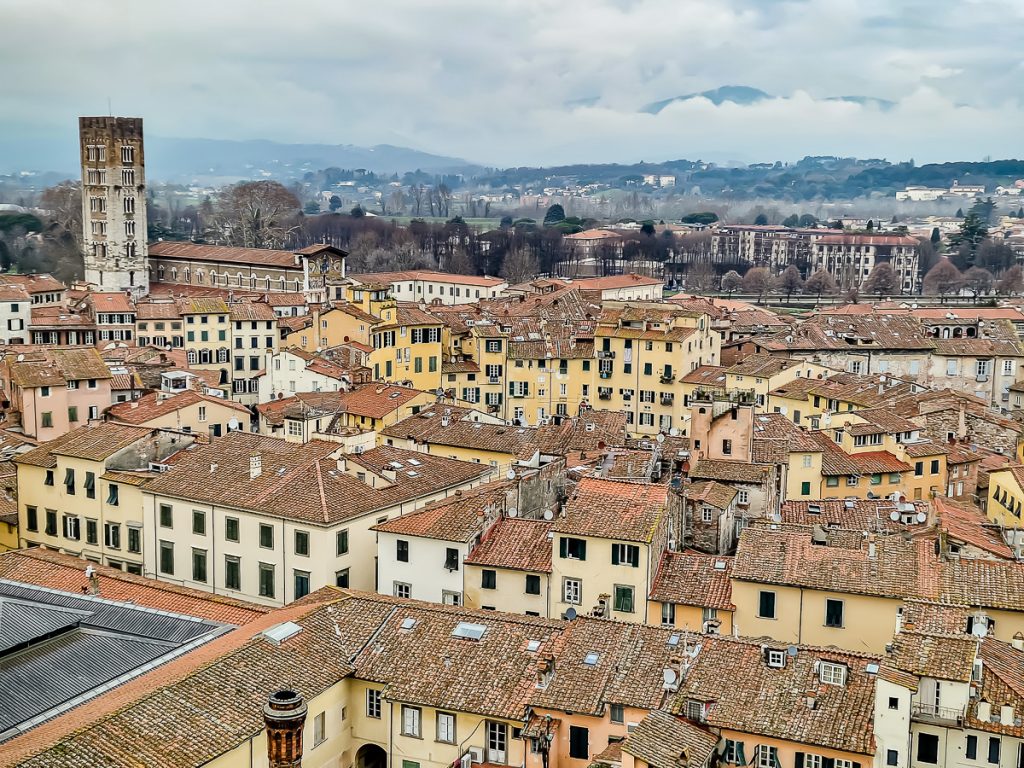
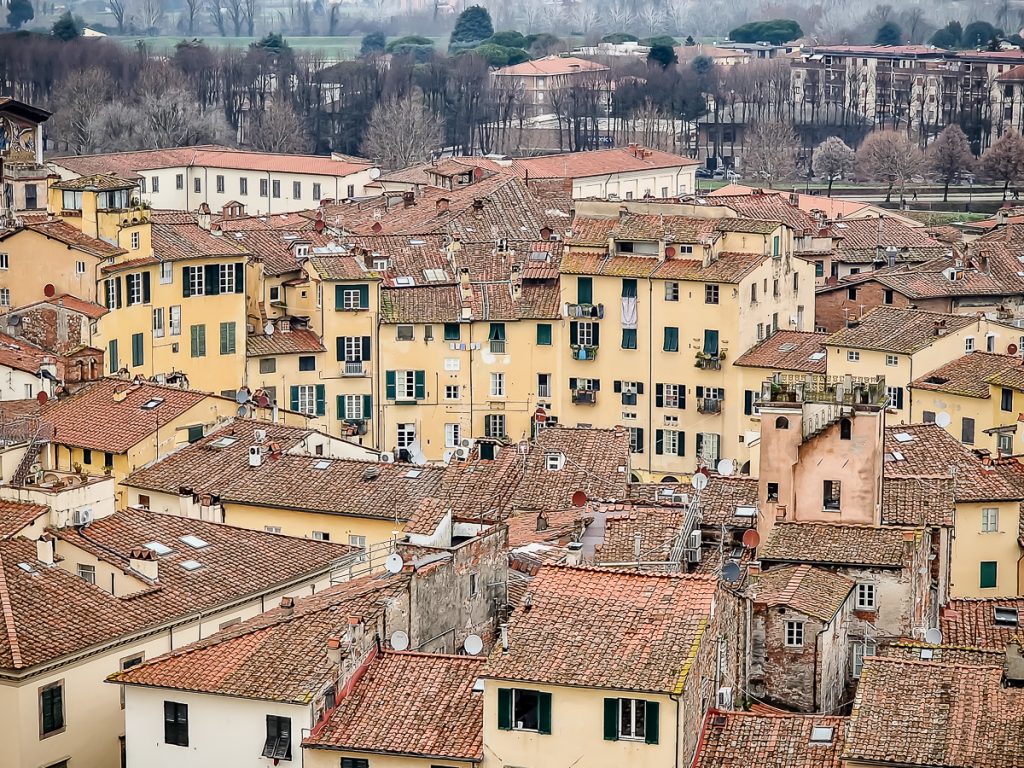
I stood for a long time on the side from which the Piazza dell’Anfiteatro is clearly visible, then I started to admire the trees next to me.
Seven oak-trees created an enviable „haircut” for this tower.
As for the purpose of planting them right here, there are many theories: one says that this is how they managed to make the tower higher than others, another that the Guinigi family came from the country and this is how they showed their origin, another that, in fact, they had made a vegetable garden here. Nothing is certain.
On the way down, I encouraged the people who were breathing hard on the steps in the desire to reach the terrace faster. I was already showing off, saying it’s not difficult…
WHERE TO EAT IN LUCCA
Lucca is full of restaurants, terraces, bars, so you can enjoy 3-4 dishes sitting at the table in a trattoria or you can fill up on the go with a delicious focaccia with mortadella. 5 euros.
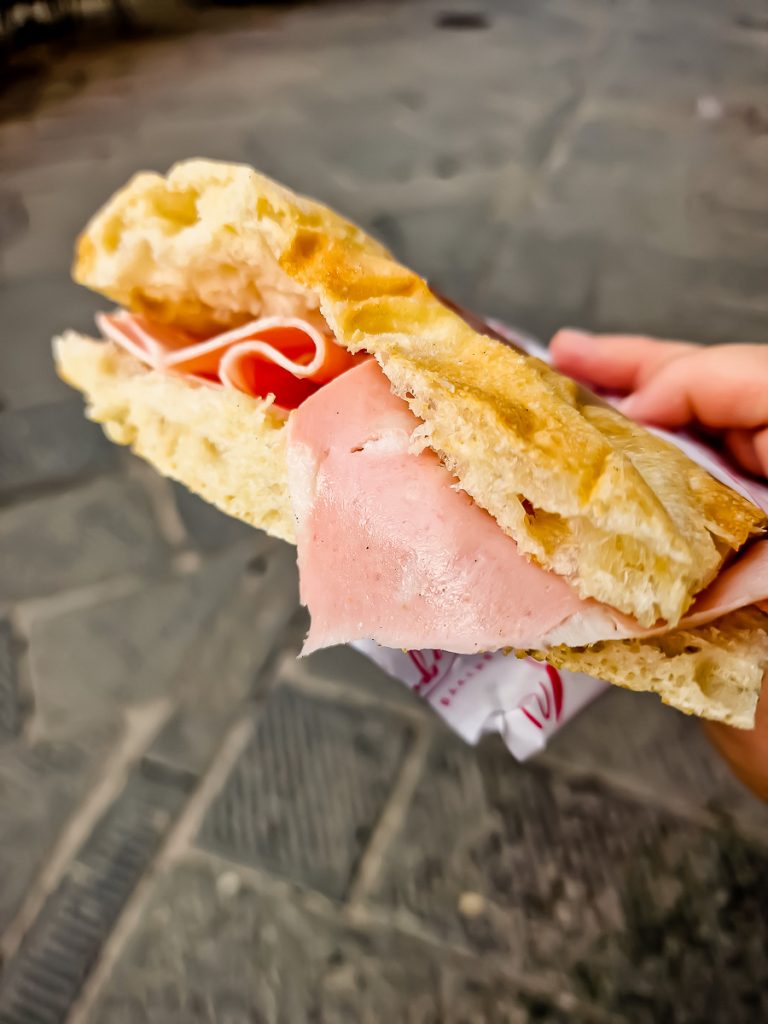
I listened to my friends, the guide and the internet, and I went to eat in recommended places.
BUCA DI SANT’ANTONIO
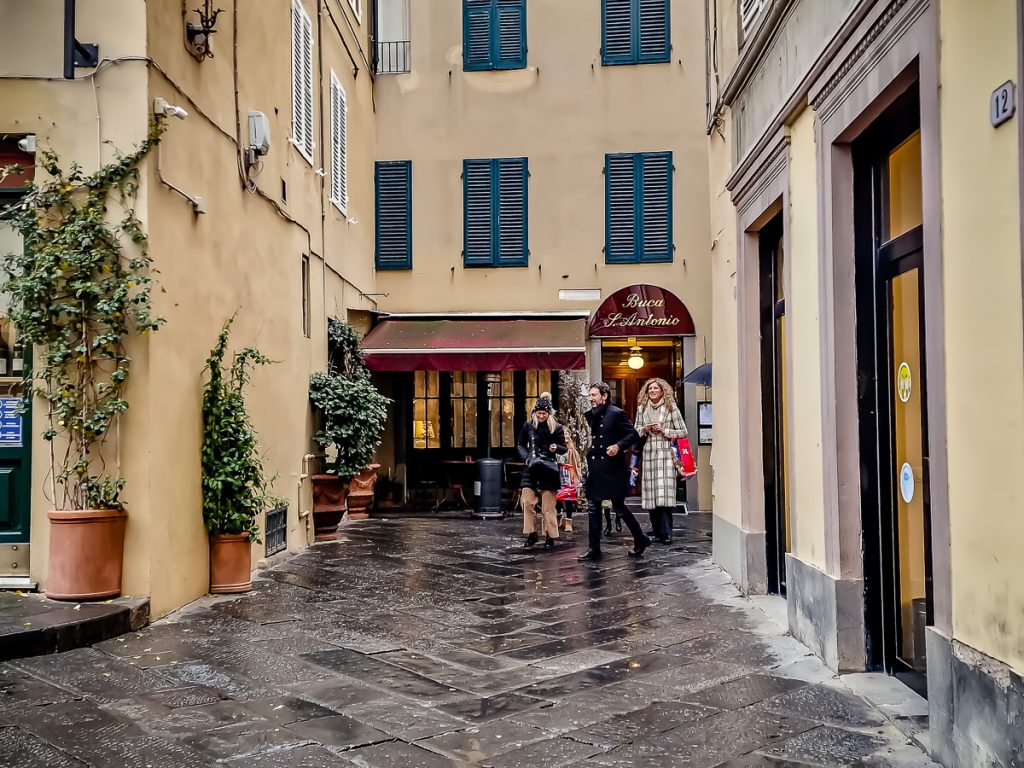
It is the oldest and most famous restaurant in Lucca. It is very close to Puccini’s house, to the church of San Michele, so it is in the very heart of the townlet.
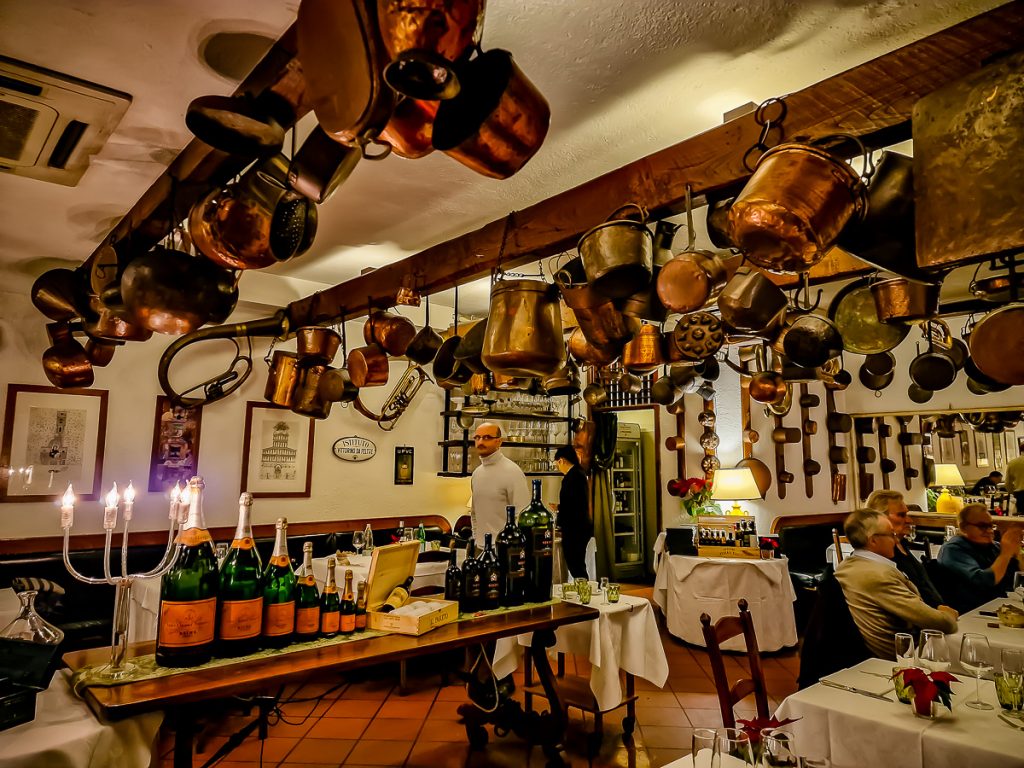
The interior is interesting, the atmosphere is cool, the waiters are friendly. I was “warned” that they behave with you, an ordinary person, just like with the presidents and stars who crossed their threshold.
I ate well, tasty (pasta and meat) and paid about 50 euros per person.
The restaurant is only open for lunch and dinner.
TRATTORIA DA GIGI
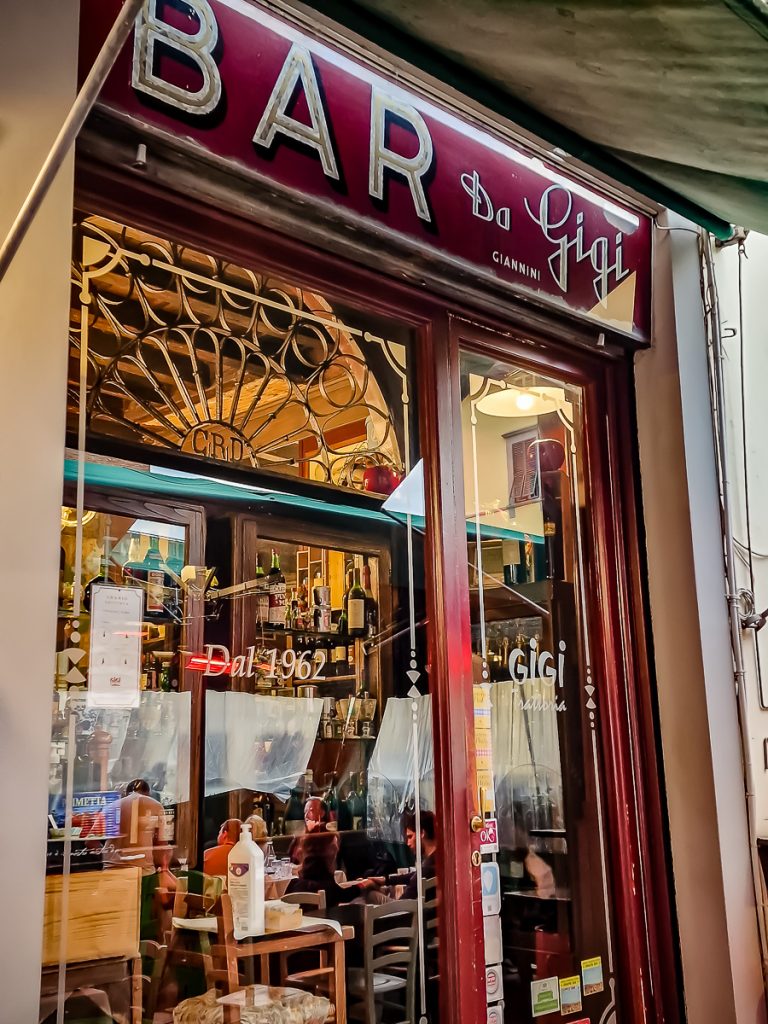
I waited for about 20 minutes for a table to become available at this trattoria, a bit more hidden than other restaurants “on the street”.
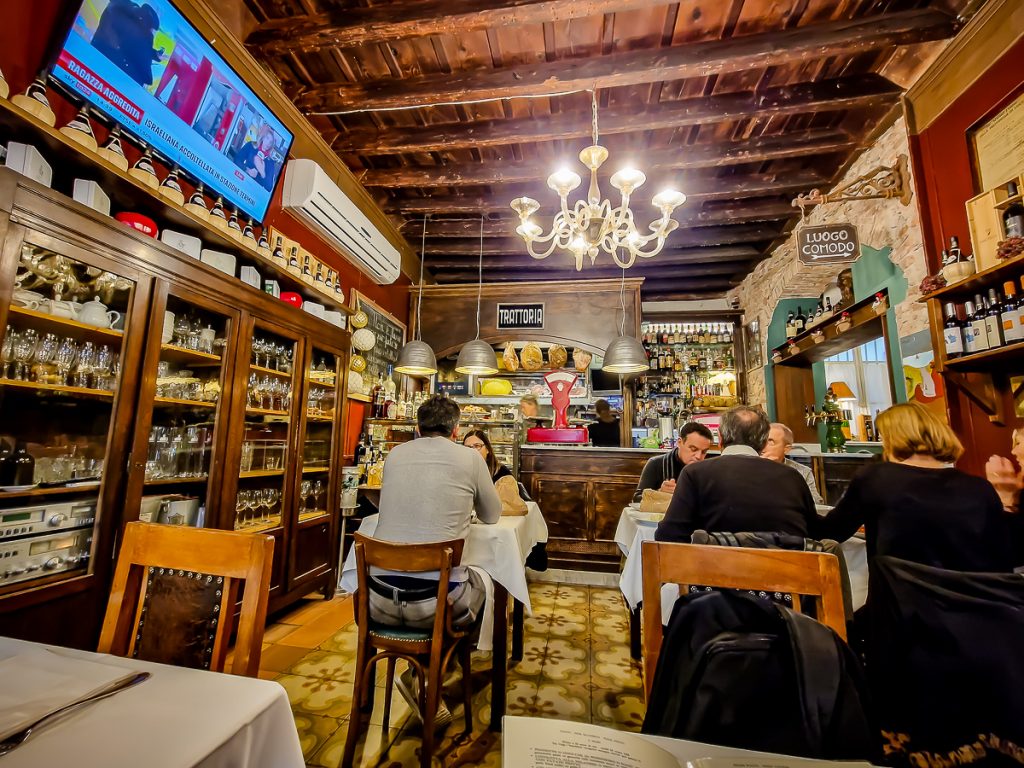
The truth is that it does not have many tables and, if you happen to be there when many hungry people gather around, you risk not finding a place.
I ate very well!!! Pasta with ragù, then beef.
Gigi’s is only open for lunch and dinner.
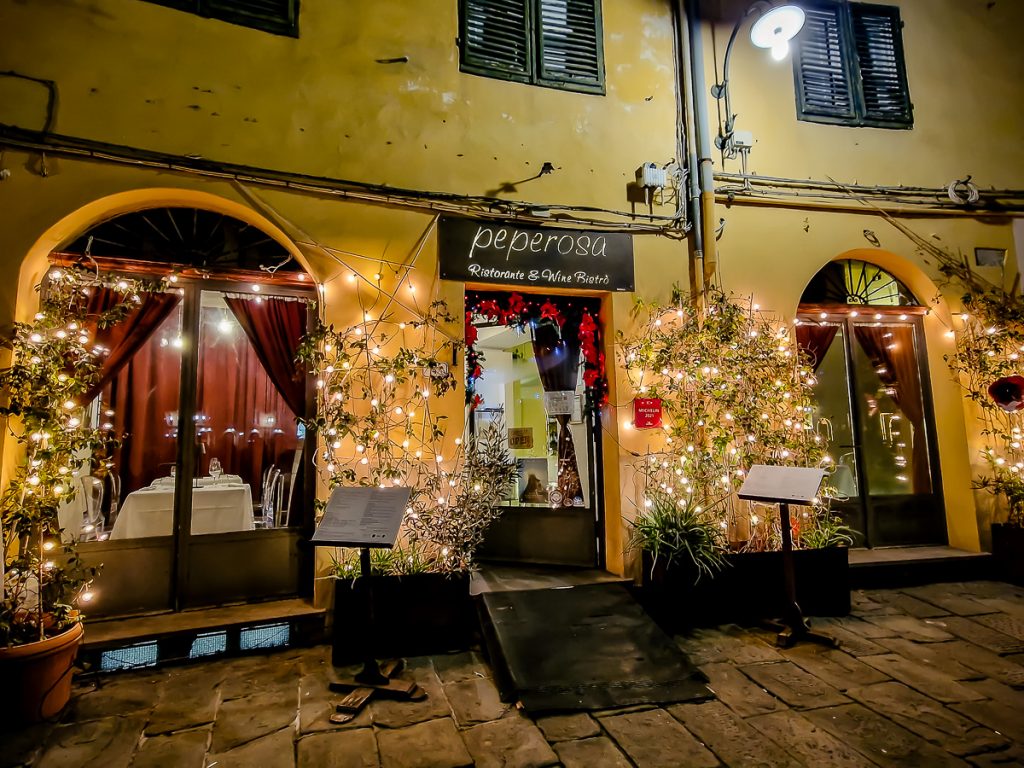
That rule that says “don’t eat in the tourist area, because the food is not good” is not really valid in Lucca. I received recommendations from the locals for restaurants located in an area full of tourists.
PEPEROSA
Being the type of tourist who wants to walk, not to go out in the evening on the fashion street, I entered the restaurant in Piazza dell’Anfiteatro relaxed and poorly dressed. I was convinced that it was a trattoria like any other. Well, no. It was about luxury and elegance, like „let me take your coat, carry your bag, seat you, light your lamp”. My coat was a jacket, my bag was a backpack, not to mention that I couldn’t wait to sit down to hide my boots and sweatpants under the table…
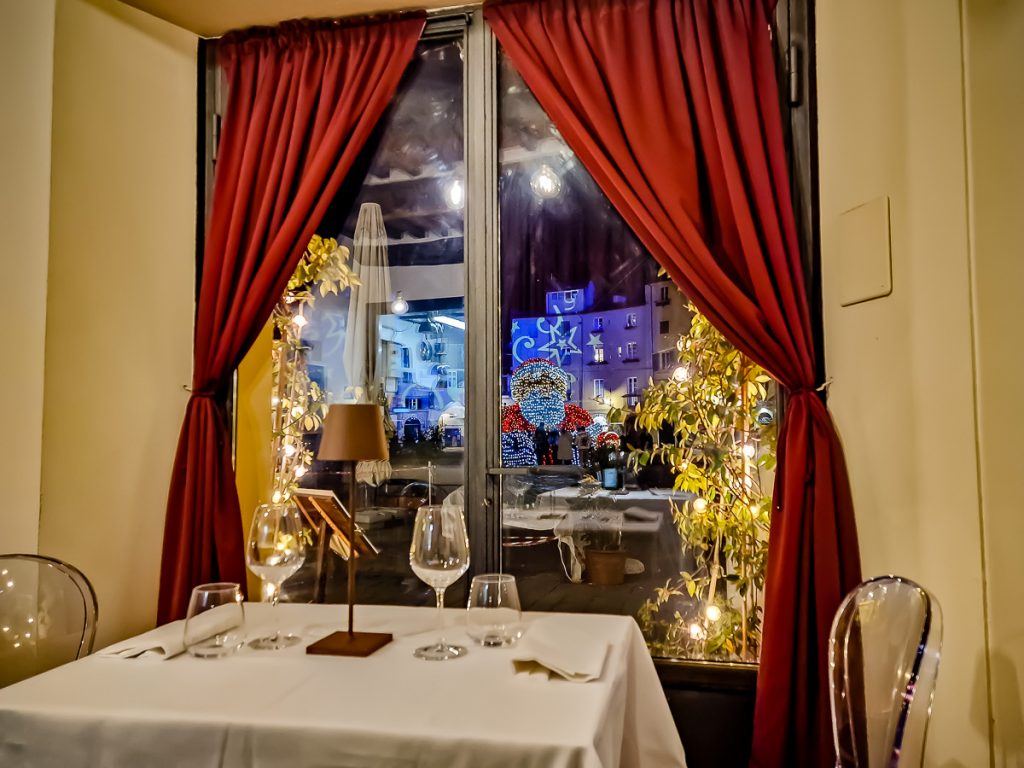
I was served a welcome drink, then a tiny thing to eat and I said that there was nothing I could do: I have to behave like a lady! A lady like „I’m a millionaire, but that’s how I like to dress, to go unnoticed” J))
I was the only one in the room at dinner time. But do you know how my stress passed??? Once the next customers entered the restaurant, people dressed in jeans and sweaters.
And look how I suddenly became relaxed and enjoyed dinner. Mini dinner. Tiny dinner.
A good one, however…
Da Gherardo was also recommended to me in Piazza dell’Anfiteatro, but I didn’t get there. And the guide told us that the restaurants outside the square, right within the radius of the amphitheater, are very good! Good to know, for next time…
For fast food fans: no trace of Mc Donalds or KFC in Lucca! No smell, nothing. I was told that there is Mc, but outside the walls. The interior is “theirs”. Good for them!
LUCCA GELATERIES
Near the Amphitheater Square, there are also two gelaterias that I was advised to go to: Matta and Veneta Lucca. I tested the ice cream from both J.
And, to give you an idea of the price, here it is:
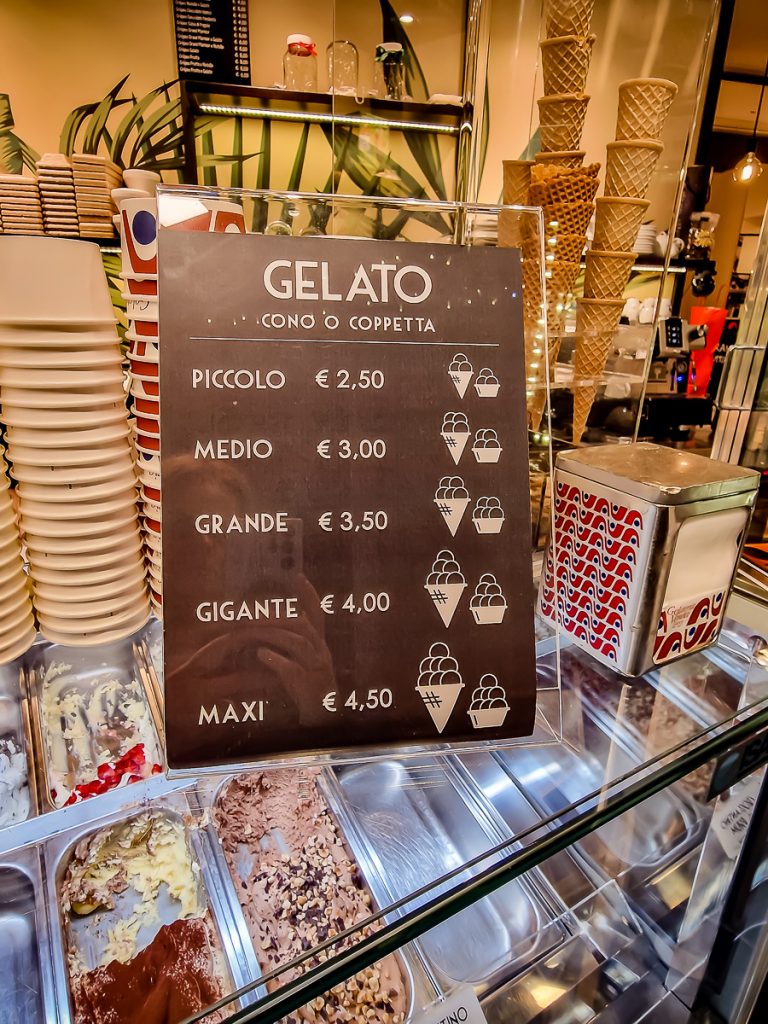
Believe me, a small one is enough! Let’s say that, if you come with a huge appetite and have a big stomach, a medium one will do. But bigger, it’s already a waste…
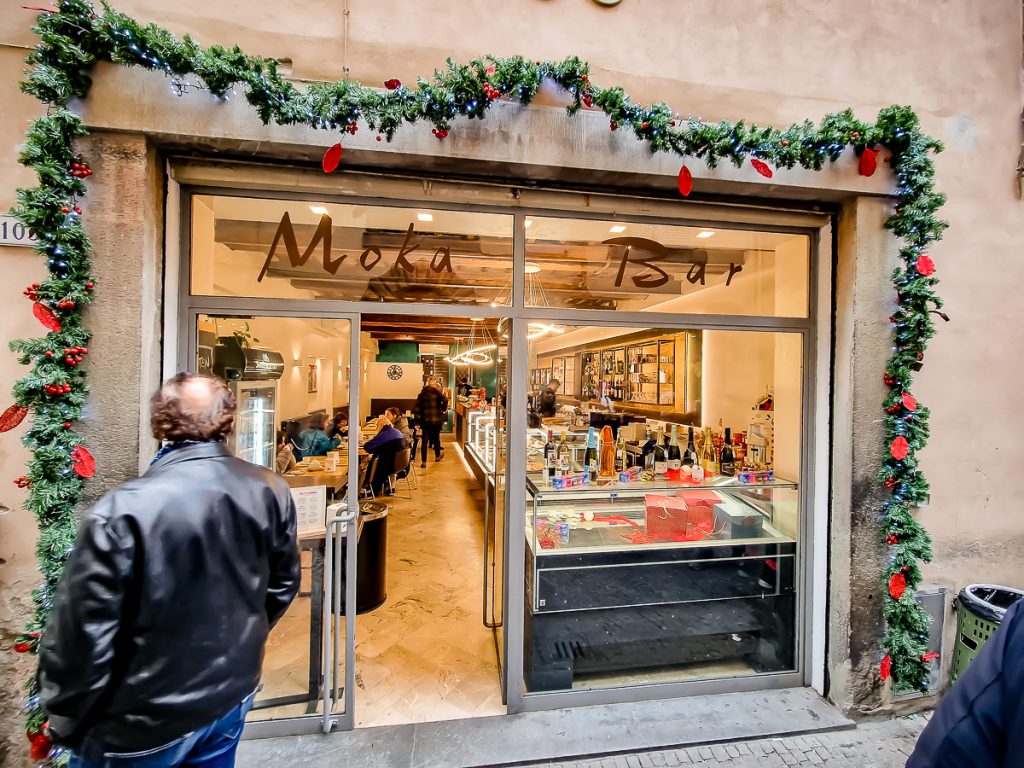
For coffee lovers, there is Moka Bar on Via Fillungo.
The coffee here is very good and many of the customers are actually locals.
SHOPPING IN LUCCA
Even if you don’t want to buy anything, a walk through the historic streets, full of shops, is so relaxing! This is how you discover a chic city.
I even felt like a star walking the red carpets on some streets.
I don’t know if they have a specific purpose, if they are placed only in a specific period, but even when it rained they gave an air of elegance to the area.
Not even a trace of H&M, Zara or other big stores that, from what I have seen in other cities of the world, occupy strategic places, in areas with a huge traffic! I think I counted on my fingers the stores from international chains, such as Sephora, Douglas or Foot Locker.
I understand that this is the way of the Lucca people to protect their own craftsmen, designers, small traders! Cool!
The truth is that, during the tour through the city, the guide wore my ear out:
The guide: „This is a historic store!”
The guide: „That’s another historic store. And another and another.”
And he showed us the family name, written somewhere under or next to the type of business.
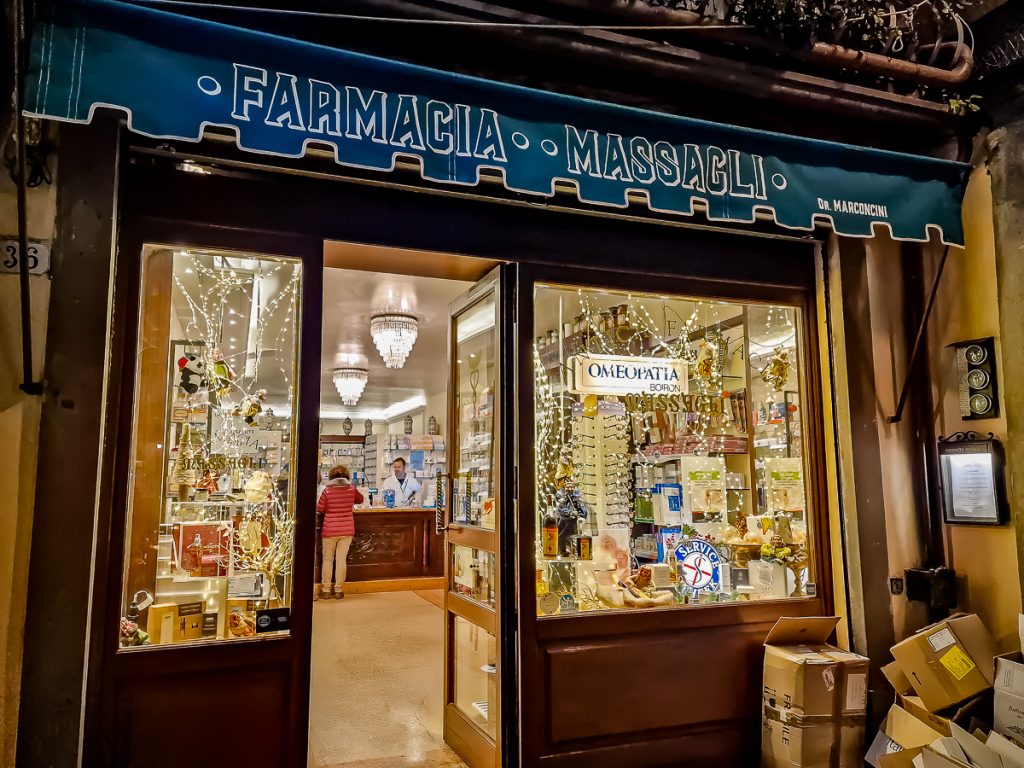
„This pharmacy is historic.” Really!? This one too??? Yes, even this one, that showcases a digestif used some time ago against malaria – Massagli.
The shops are small, which means that the goods brought are chosen carefully. You won’t find cheap products here, because these people don’t have space for something like that…
MERCATO DEL LIBRO
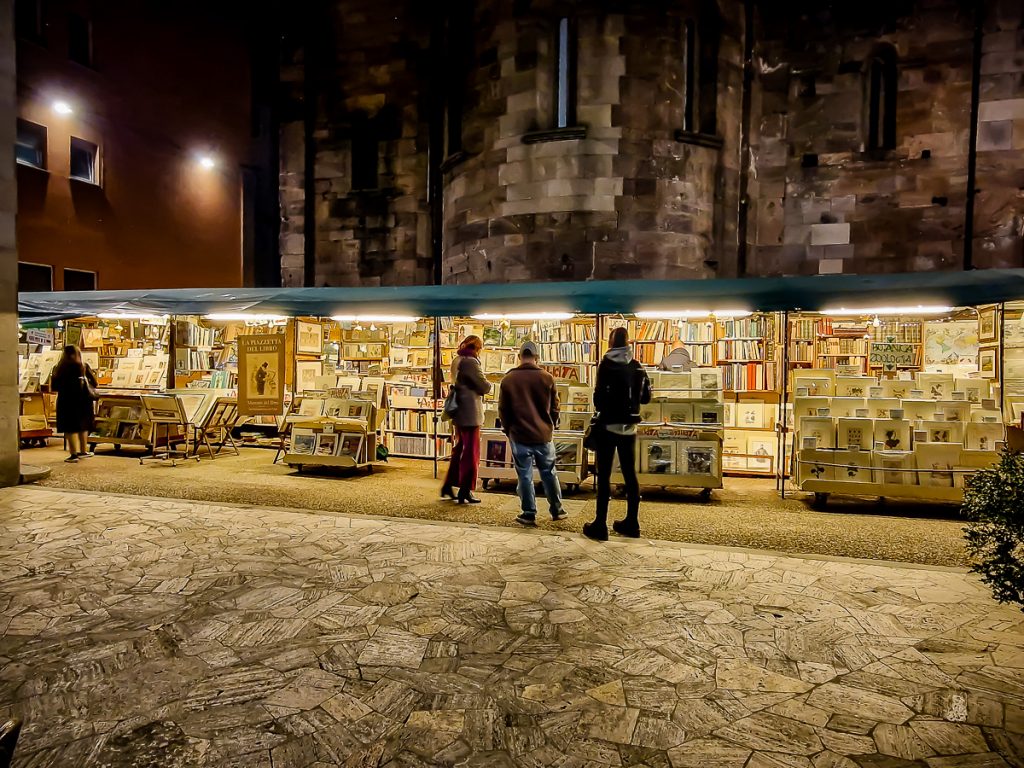
I really liked this place, discovered absolutely by chance!
An open-air market where you can stay for hours, if you are passionate about looking through antiques. From books to lithographs, calendars, maps, paintings…
It is open until late at night.
WHERE TO STAY IN LUCCA
I stayed at Antica Residenza del Gallo. Very good, quiet area, spacious, tall, historic rooms and apartments. And the security given by the boss, Zinaida, my former college colleague.
There are many places where you can stay in Lucca and, if you choose to stay inside the walls, everything is close, you don’t have to worry.
Although I came by train, you can also come here by car. There are free parking lots near the city wall. There are some you have to pay for. It is important not to park in the resident’s spot, so as not to spend your vacation money on fines…
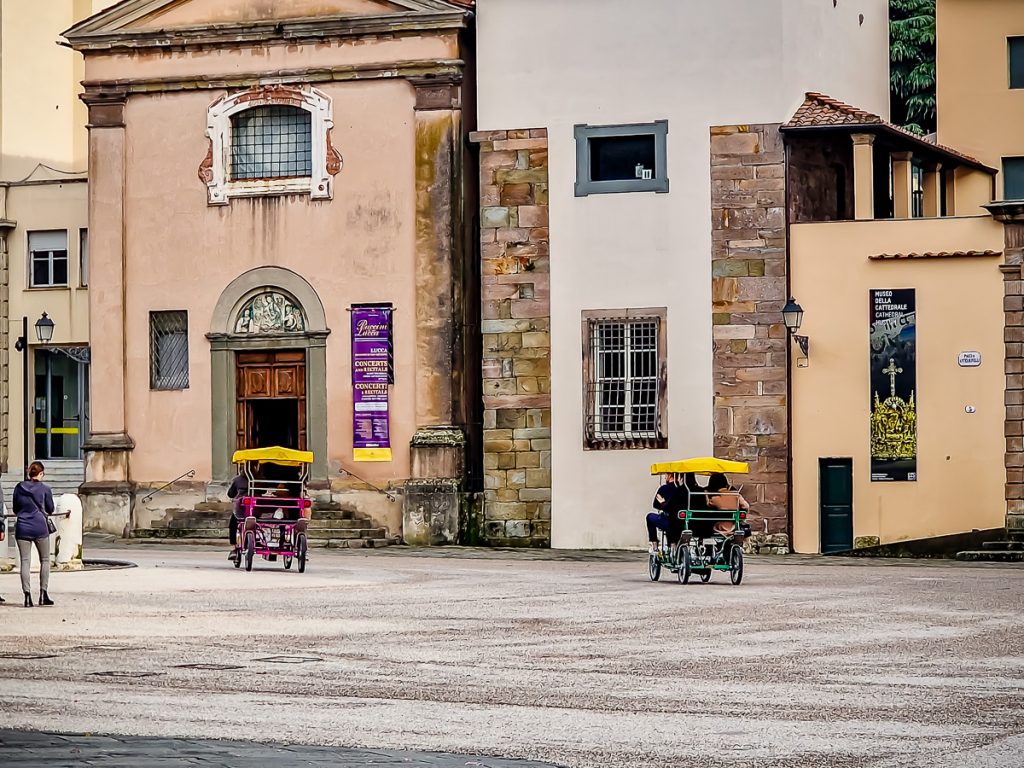
It is good to leave your car somewhere while you are staying in Lucca. You can easily cross the city on foot, but you can also take a bicycle!
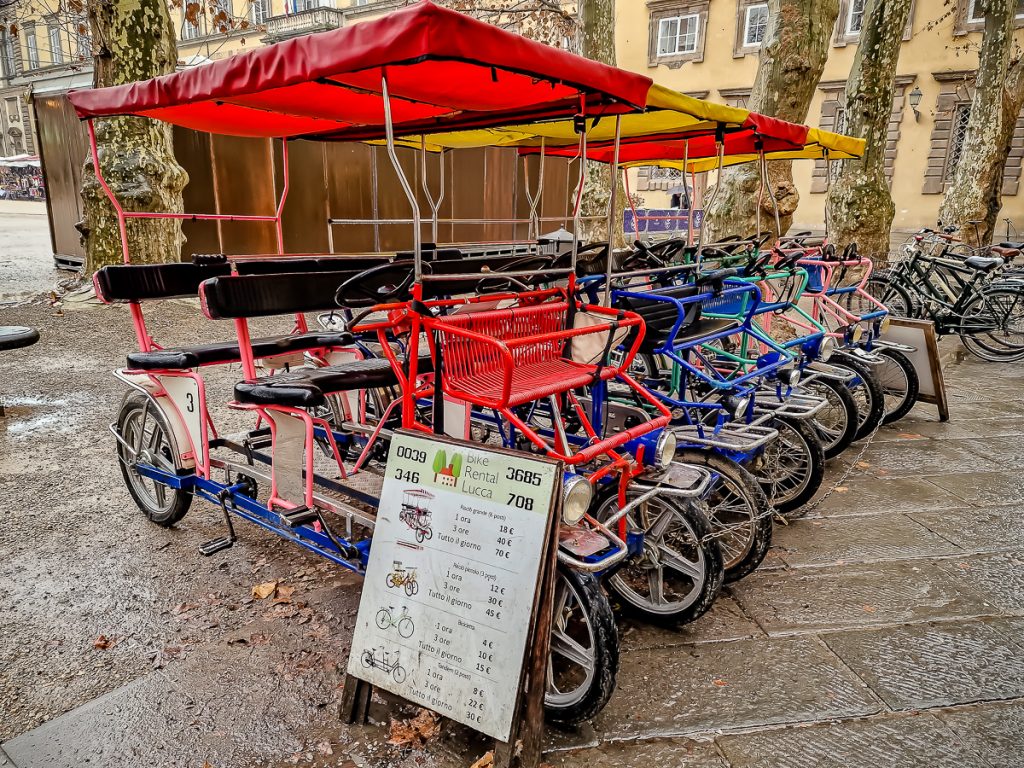
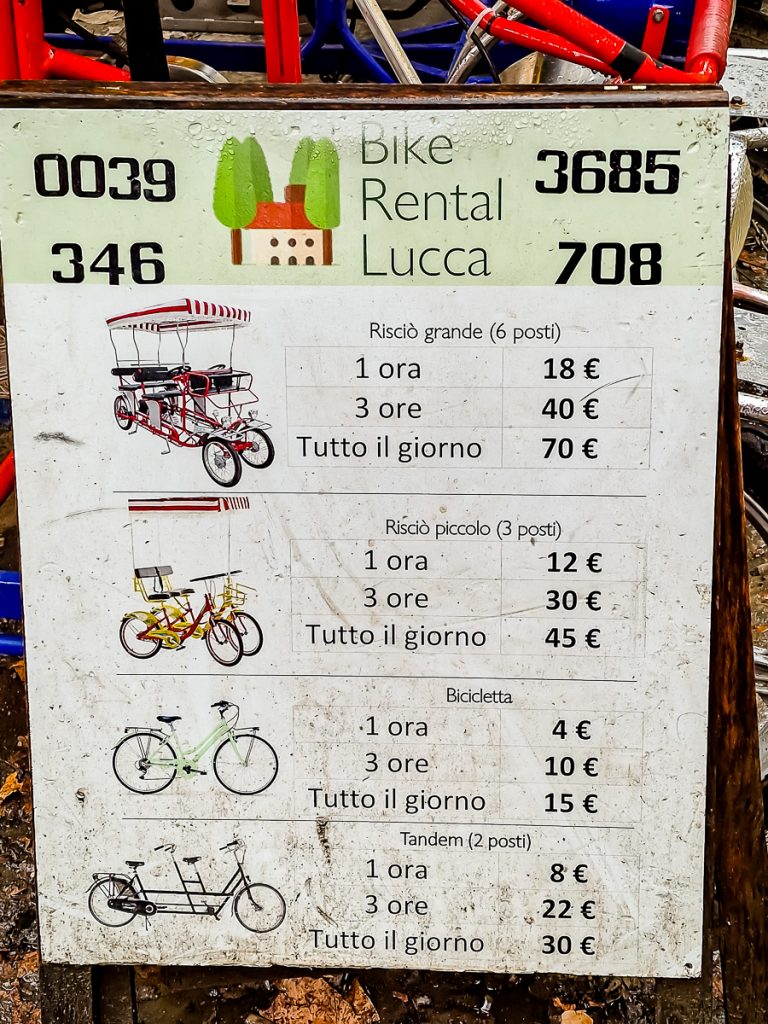
I study the mercurial of bicycles for rent and, as in their parking lot there are only “family” ones, I take it on foot…
On my way I set my eyes on one, only it’s already „rented” and I can’t take the man’s bread:
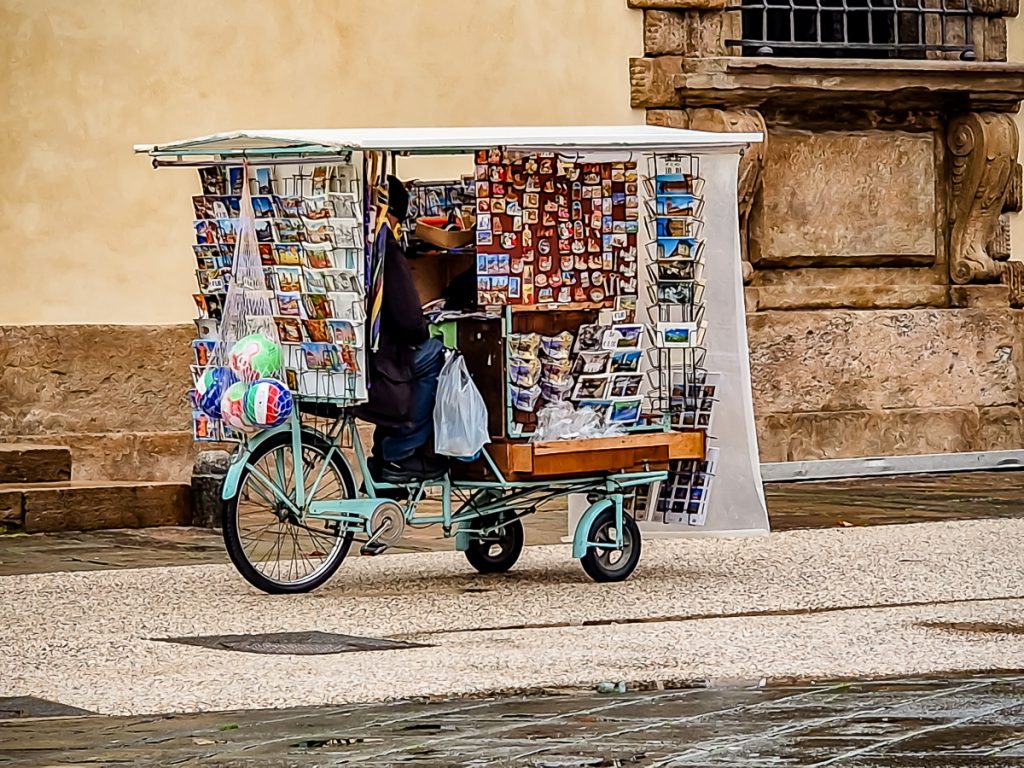
Anyway, I don’t even have time, I’m rushing to the train station to catch the train to Bologna. Basically, I move from one region to another: I leave Tuscany and go to Emilia-Romagna.
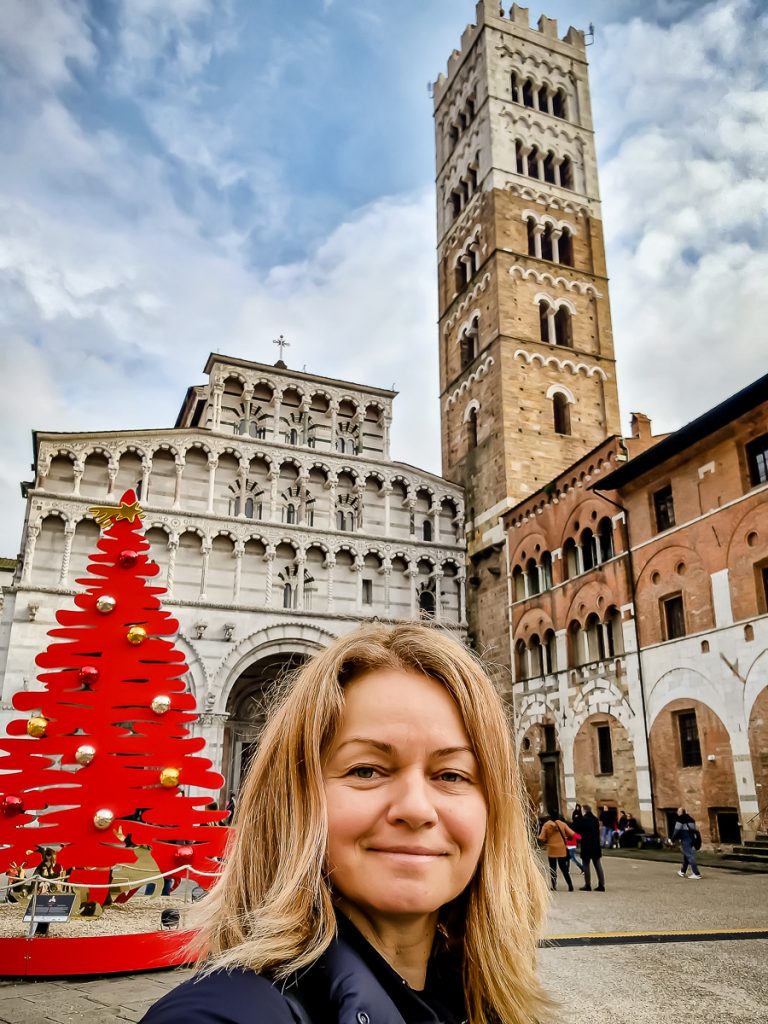
Passing in front of the Cathedral, my heart (and my reflexes…) won’t let me leave without taking a selfie, then I run with my suitcases, looking for the hole in the wall that would save me from going up and down with over 20 kilos of luggage.
I am returning to Bologna after only a few months, ready to update what I have learned and already written about this place. Haven’t you read it yet??… Well, you have to, because you don’t know what you’re missing J. Right here.
